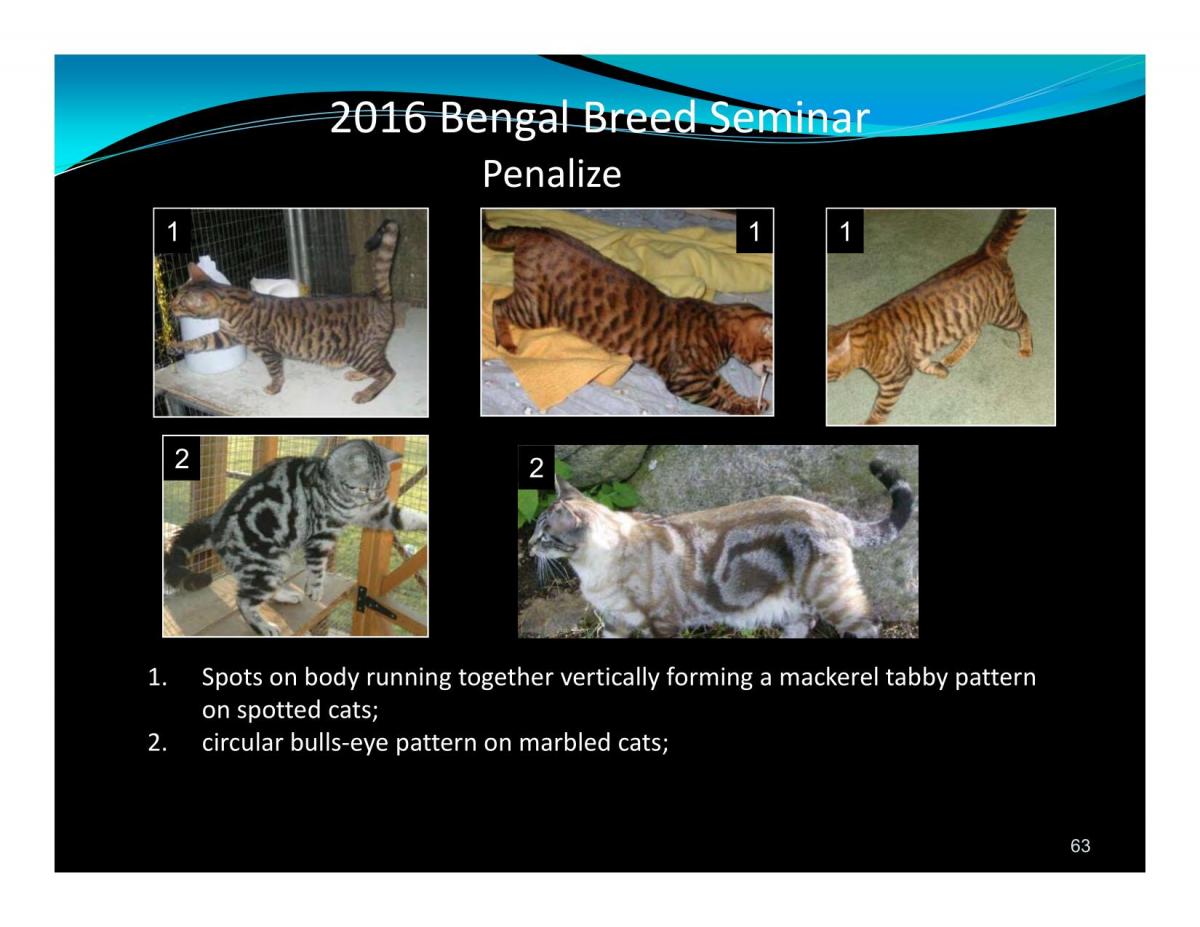The Bengal is a unique and captivating breed, their combination of intelligence, high energy and flashy appearance captivates fanciers around the world. As this presentation is geared toward helping exhibition professionals, judges, handlers, and exhibitors, it covers several points that should assist in better evaluation of individual animals. Photos are intended to help clarify and provide a better understanding of the Bengal standard in CFA.
Historicals goals of the Bengal Breed: To create a miniature leopard, with the loving dependable temperament of the domestic cat. From the humble beginnings of Jean Mill's first experimental breeding to one of the most registered and sought after breeds in the world. Bengals have come a long way in a relatively short span of time. Temperament remains of utmost
importance, both in the show hall and in providing kittens and cats as companions to the public. Bengals now come in more patterns and colors than any wild species, through selective breeding we are able to adhere to a standard that places value on hcaracteristics deemed important by experts, breeders and enthusiasts. With the advances in genetic testing and veterinary medicine, we are now able to more efficiently apply selection pressures to those colors we want to work with and diseases and genetic faults we seek to avoid. So, while it isn't necessary to look specifically at the Asian Leopard Cat as our muse, it is worthwhile to be aware that the goal of Bengal breeders is to selectively breed for a domestic cat with unique physicla features similar to the stunning
small arboreal cats that have long captivated us.
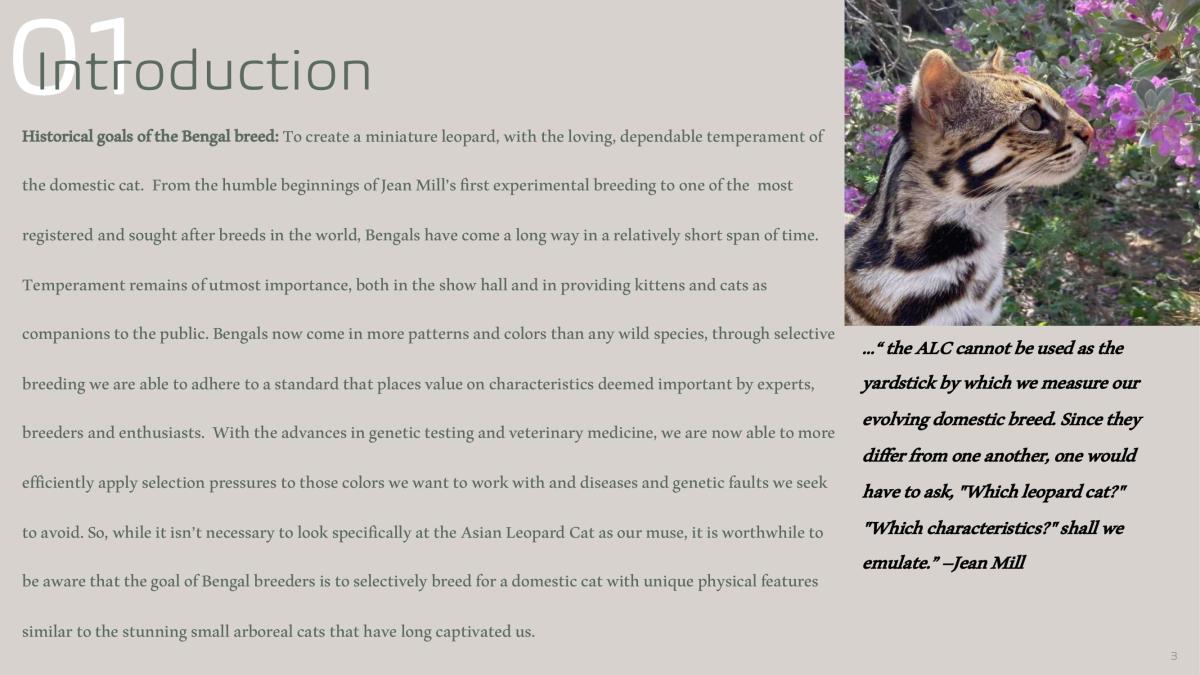
Acknowledgements and Full Credits to: https://cfa-files.s3.us-east-2.amazonaws.com/breed-presentations/Bengal.pdf
The Bengal is one of the few breeds selectively bred to emulate traits of wild felids.
• High contrast, patterned coats coupled with a smooth, luxurious texture.
• Exotic facial appearance: Prominent eyes, large puffy nose leather, and rounded deeply
cupped ears.
• The body is athletic, with substantial boning , larger hindquarters and a thick tail.
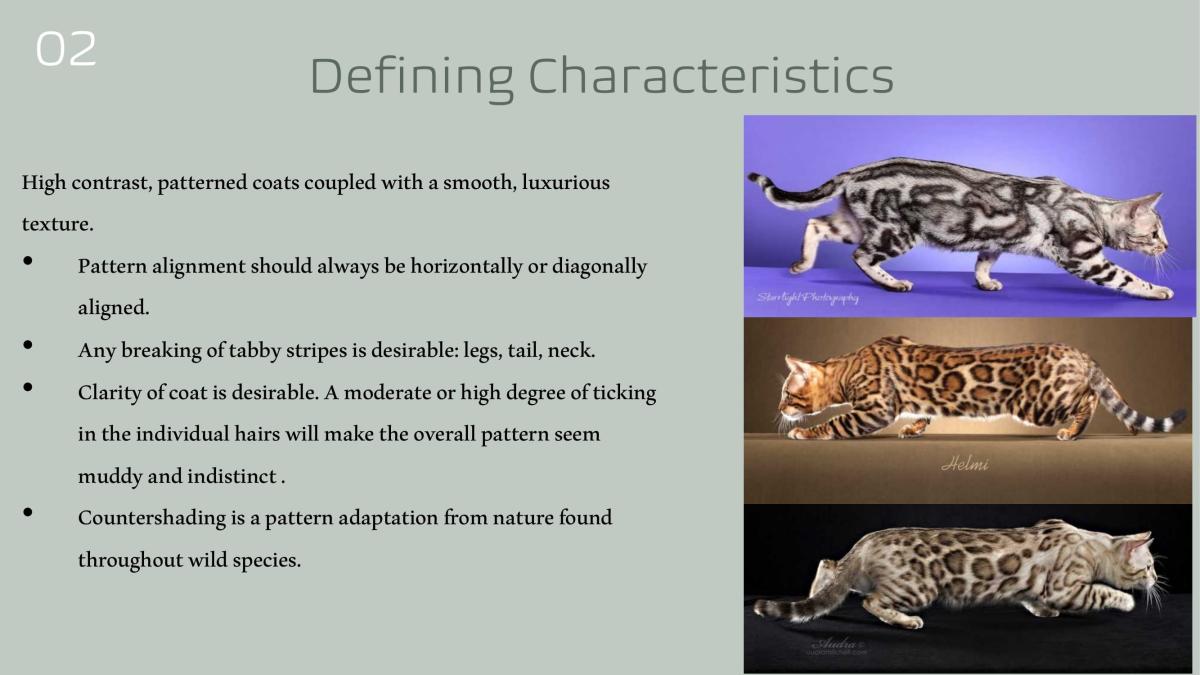
High contrast, patterned coats coupled with a smooth, luxurious texture.
• Pattern alignment should always be horizontally or diagonally aligned.
• Any breaking of tabby stripes is desirable: legs, tail, neck.
• Clarity of coat is desirable. A moderate or high degree of ticking in the individual hairs will make the overall pattern seem muddy and indistinct .
• Countershading is a pattern adaptation from nature found throughout wild species.
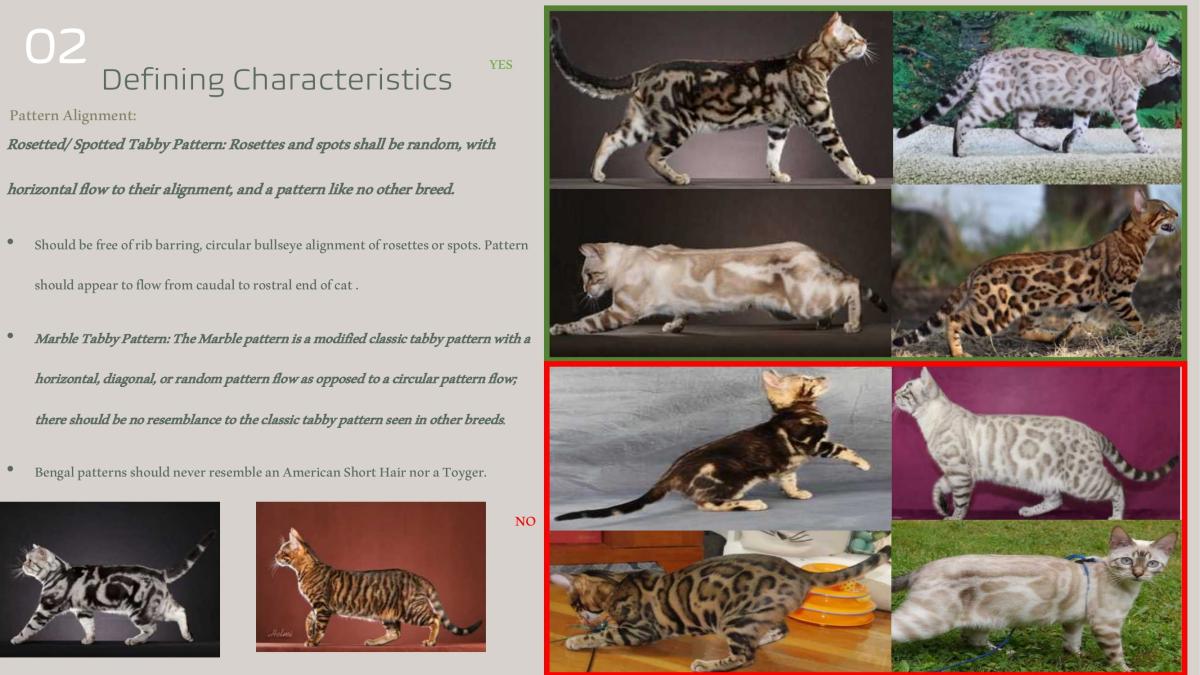
Pattern Alignment
Rosetted/ Spotted Tabby Pattern: Rosettes and spots shall be random, with horizontal flow to their alignment, and a pattern like no other breed.
• Should be free of rib barring, circular bullseye alignment of rosettes or spots. Pattern should appear to flow from caudal to rostral end of cat .
• Marble Tabby Pattern: The Marble pattern is a modified classic tabby pattern with a horizontal, diagonal, or random pattern flow as opposed to a circular pattern flow; there should be no resemblance to the classic tabby pattern seen in other breeds.
• Bengal patterns should never resemble an American Short Hair nor a Toyger.
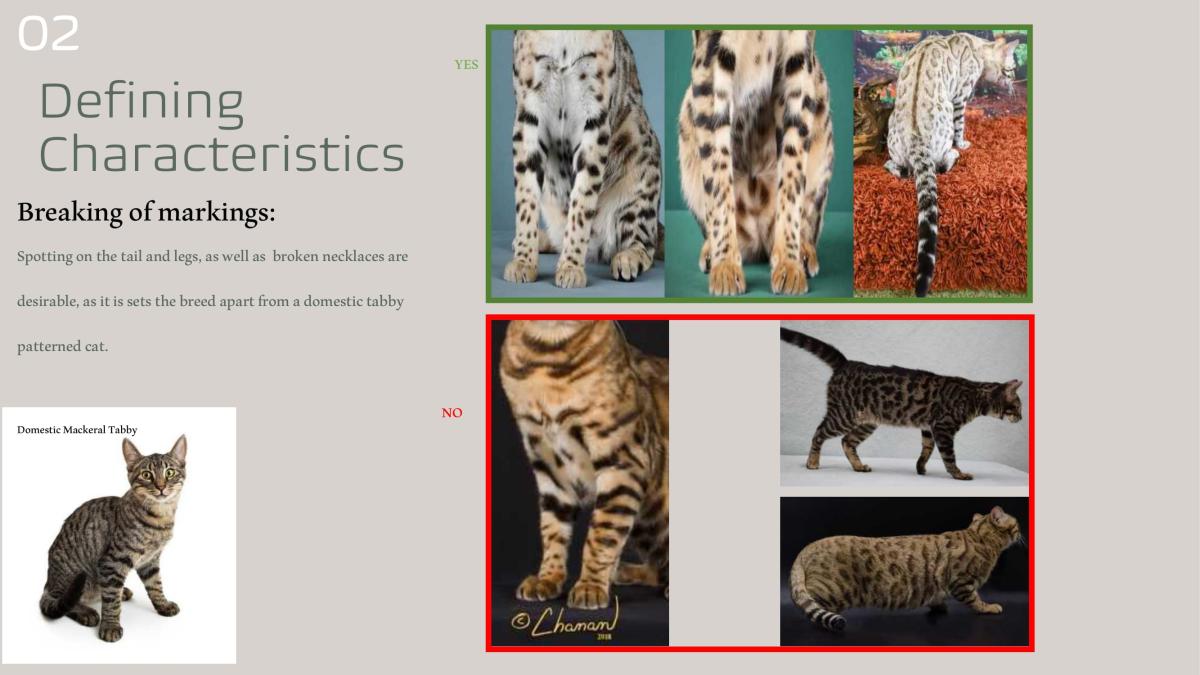
Breaking of markings:
Spotting on the tail and legs, as well as broken necklaces are desirable, as it is sets the breed apart from a domestic tabby patterned cat.
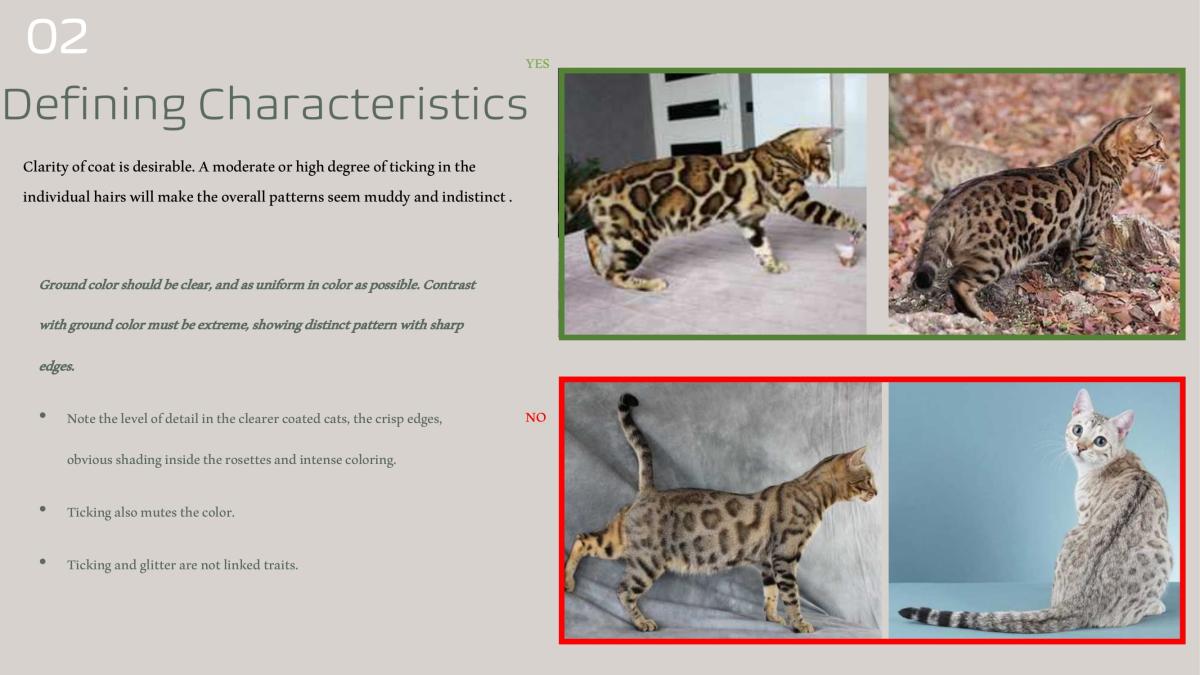
Clarity of coat is desirable. A moderate or high degree of ticking in the individual hairs will make the overall patterns seem muddy and indistinct .
Ground color should be clear, and as uniform in color as possible. Contrast with ground color must be extreme, showing distinct pattern with sharp edges.
• Note the level of detail in the clearer coated cats, the crisp edges, NO obvious shading inside the rosettes and intense coloring.
• Ticking also mutes the color.
• Ticking and glitter are not linked traits.
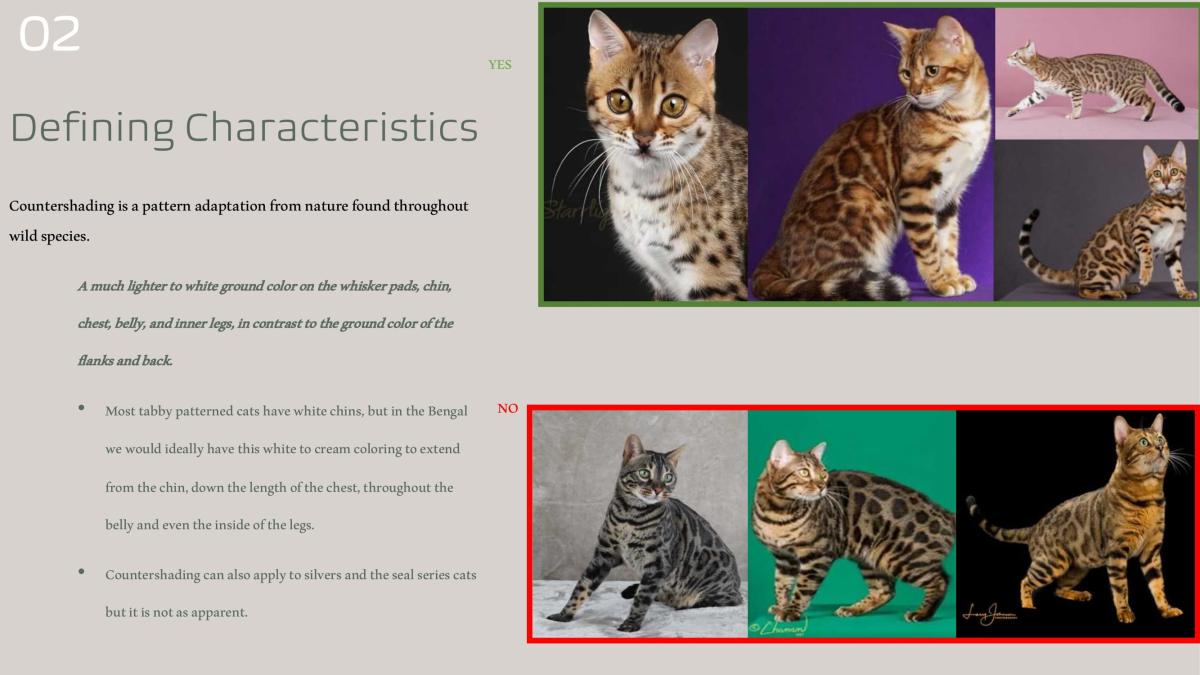
Countershading is a pattern adaptation from nature found throughout wild species.
A much lighter to white ground color on the whisker pads, chin, chest, belly, and inner legs, in contrast to the ground color of the flanks and back.
• Most tabby patterned cats have white chins, but in the Bengal we would ideally have this white to cream coloring to extend from the chin, down the length of the chest, throughout the belly and even the inside of the legs.
• Countershading can also apply to silvers and the seal series cats but it is not as apparent.
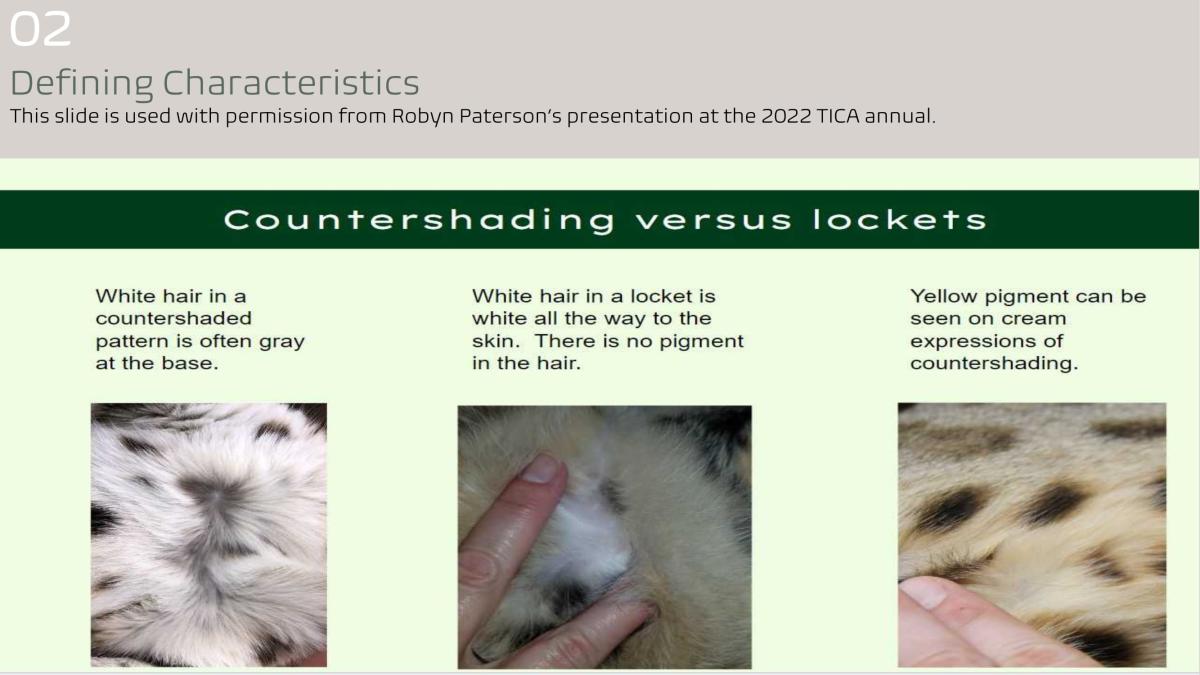
Wild cats (top row) do not have the basic Tabby M on the forehead. While this is not mentioned in the standard, it is something to select for that deserves extra merit as it emulates the wild species. It is achievable in the later generation cats (bottom row).
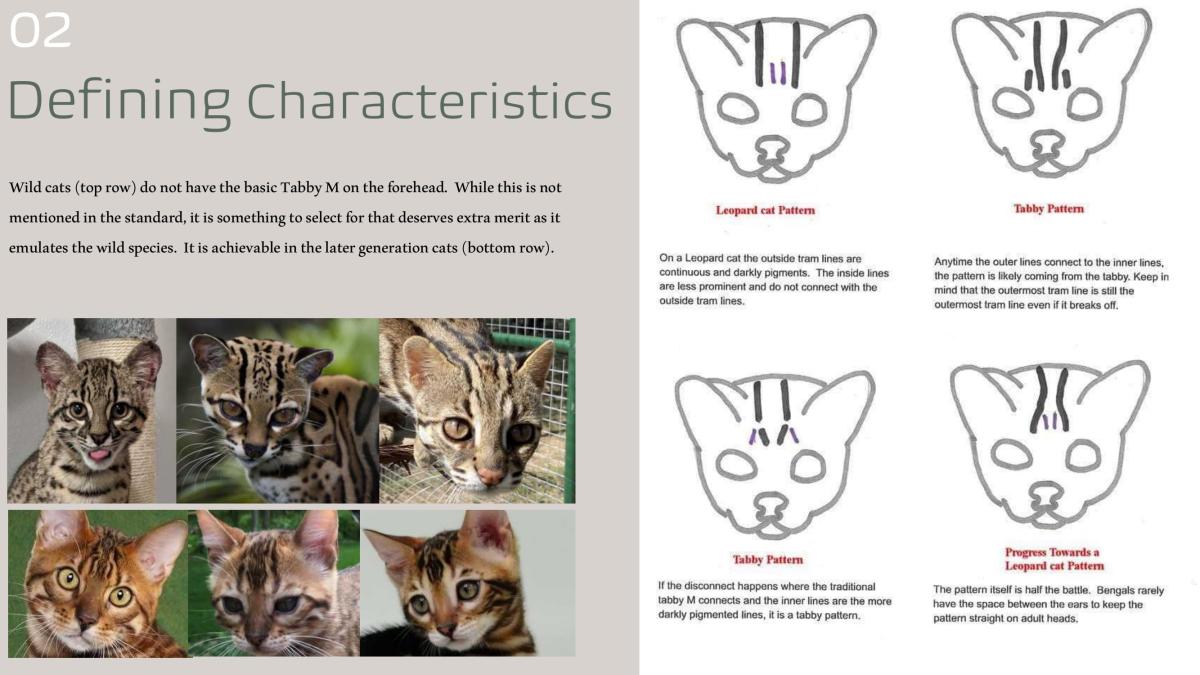
Acknowledgements and Full Credits to: https://cfa-files.s3.us-east-2.amazonaws.com/breed-presentations/Bengal.pdf
Originally written as a standard that would split the points equally between type and coat elements, CFA’s standard does place more emphasis on the coat than any other association. The challenge in evaluating is to ensure that CFA Bengals do not deviate from acceptable Bengal type yet have the highest quality coats and most correct patterns.
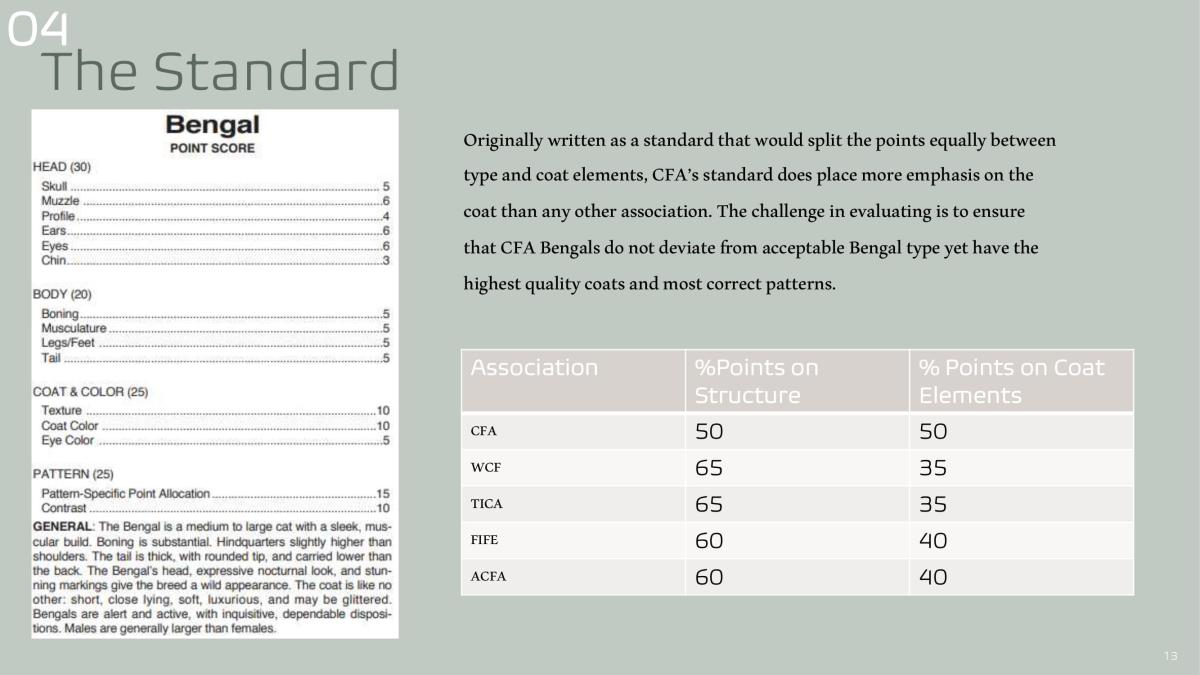
HEAD
Broad modified wedge with rounded countours , longer than wide, with high cheekbones. Slightly small in proportion to body, not to be taken to extreme. Top of skull flows back into the neck, with visible back skull. Allowance for jowls on mature males.
• Note that eyes, muzzle , and ears have the same point allocation . These important features are crucial to a well balanced Bengal head.
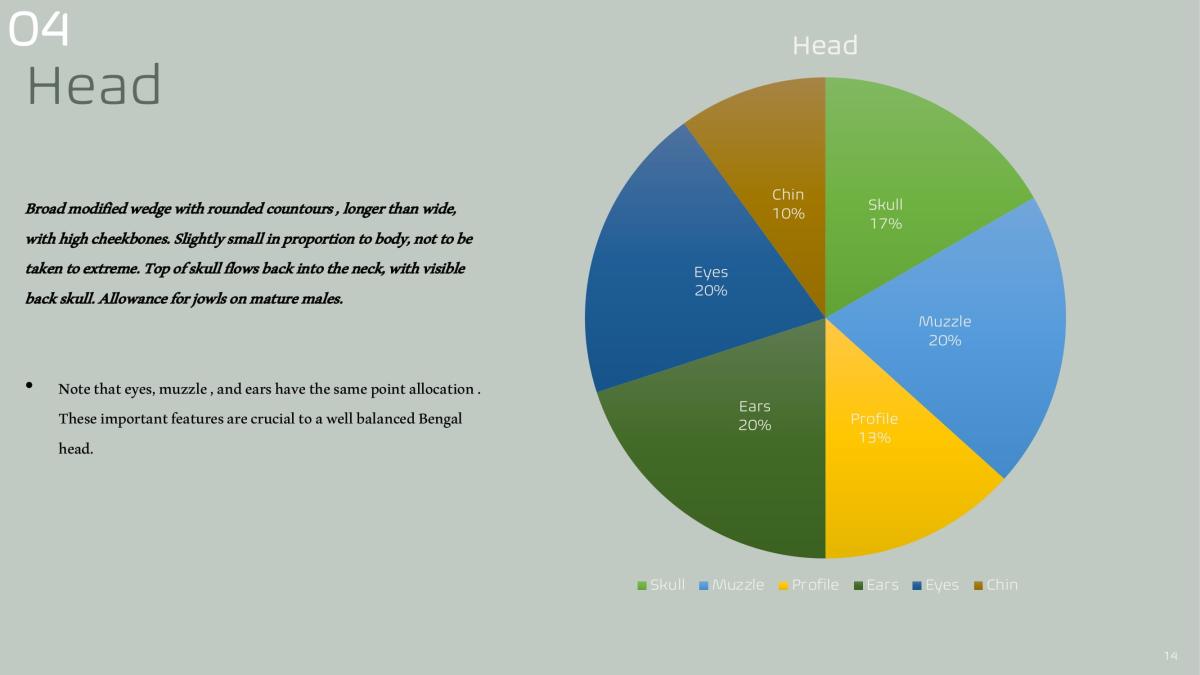
0S4kull / Head shape
• Broad modified wedge – more contoured and rounded than the wedge of more foreign breeds like a Siamese.
• Longer than wide – The length should be in the top 2/3, the back skull and the forehead of the cat.
• Somewhat small in proportion to the body.
• Allowance for jowls on mature males.
• Visible back skull, top of head should be rounded, not completely flat. Some angles of photographs or very muscular necks can obscure the back skull, it’s important to feel the structure.
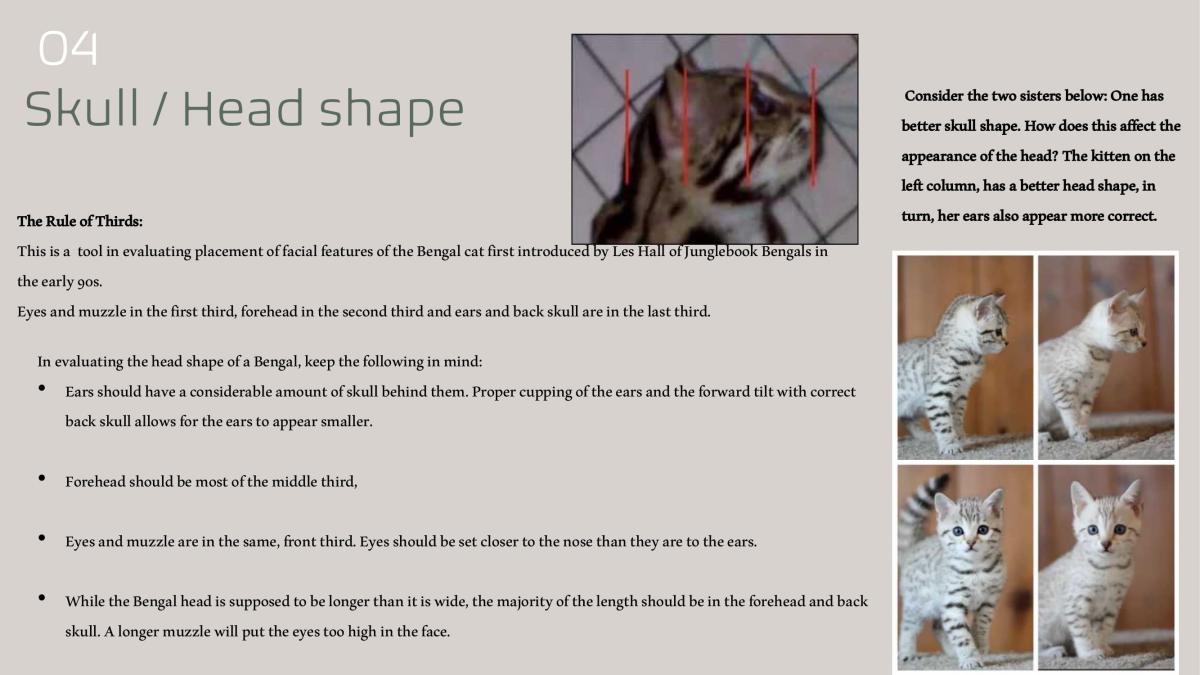
Skull / Head shape
The Rule of Thirds:
This is a tool in evaluating placement of facial features of the Bengal cat first introduced by Les Hall of Junglebook Bengals in the early 90s.
Eyes and muzzle in the first third, forehead in the second third and ears and back skull are in the last third.
In evaluating the head shape of a Bengal, keep the following in mind:
• Ears should have a considerable amount of skull behind them. Proper cupping of the ears and the forward tilt with correct back skull allows for the ears to appear smaller.
• Forehead should be most of the middle third,
• Eyes and muzzle are in the same, front third. Eyes should be set closer to the nose than they are to the ears.
• While the Bengal head is supposed to be longer than it is wide, the majority of the length should be in the forehead and back skull. A longer muzzle will put the eyes too high in the face.
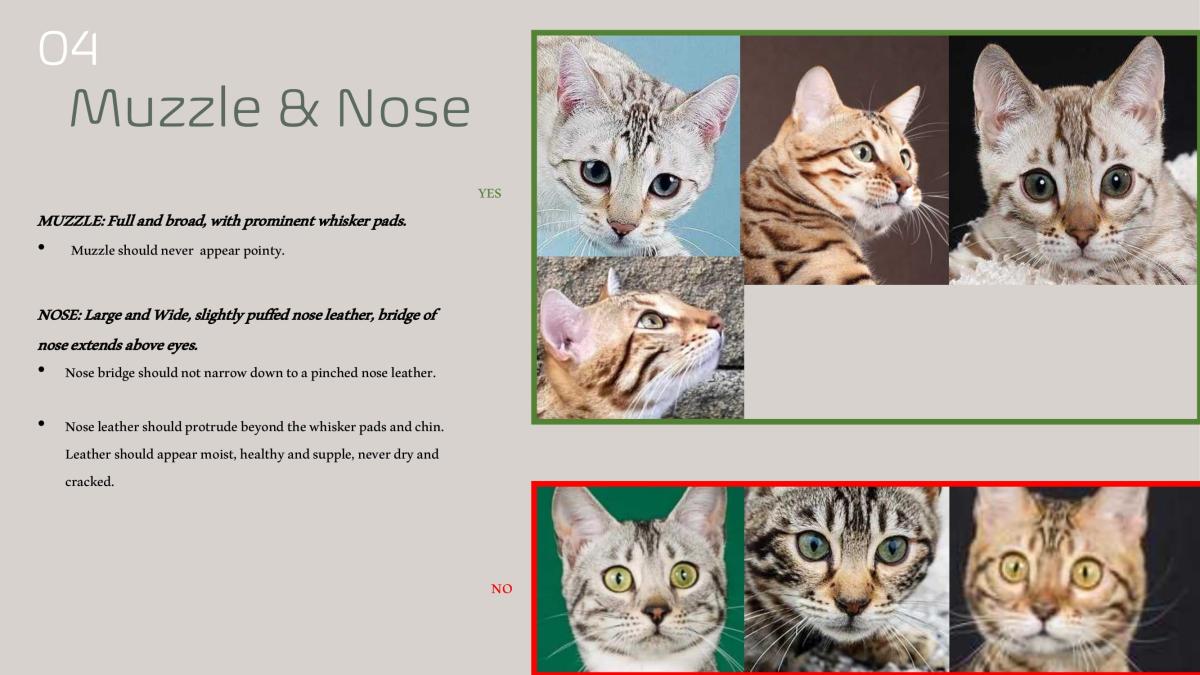
Muzzle & Nose
MUZZLE: Full and broad, with prominent whisker pads.
• Muzzle should never appear pointy.
NOSE: Large and Wide, slightly puffed nose leather, bridge of nose extends above eyes.
• Nose bridge should not narrow down to a pinched nose leather.
• Nose leather should protrude beyond the whisker pads and chin. Leather should appear moist, healthy and supple, never dry and cracked.
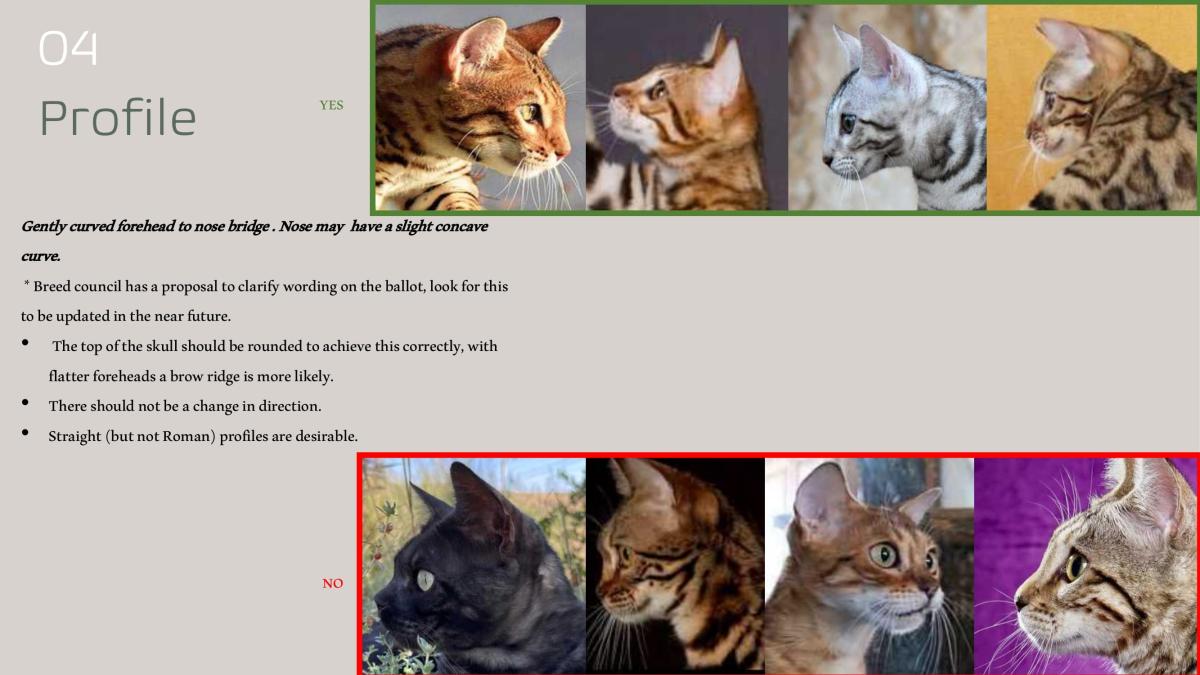
Profile
Gently curved forehead to nose bridge . Nose may have a slight concave curve.
* Breed council has a proposal to clarify wording on the ballot, look for this to be updated in the near future.
• The top of the skull should be rounded to achieve this correctly, with flatter foreheads a brow ridge is more likely.
• There should not be a change in direction.
• Straight (but not Roman) profiles are desirable
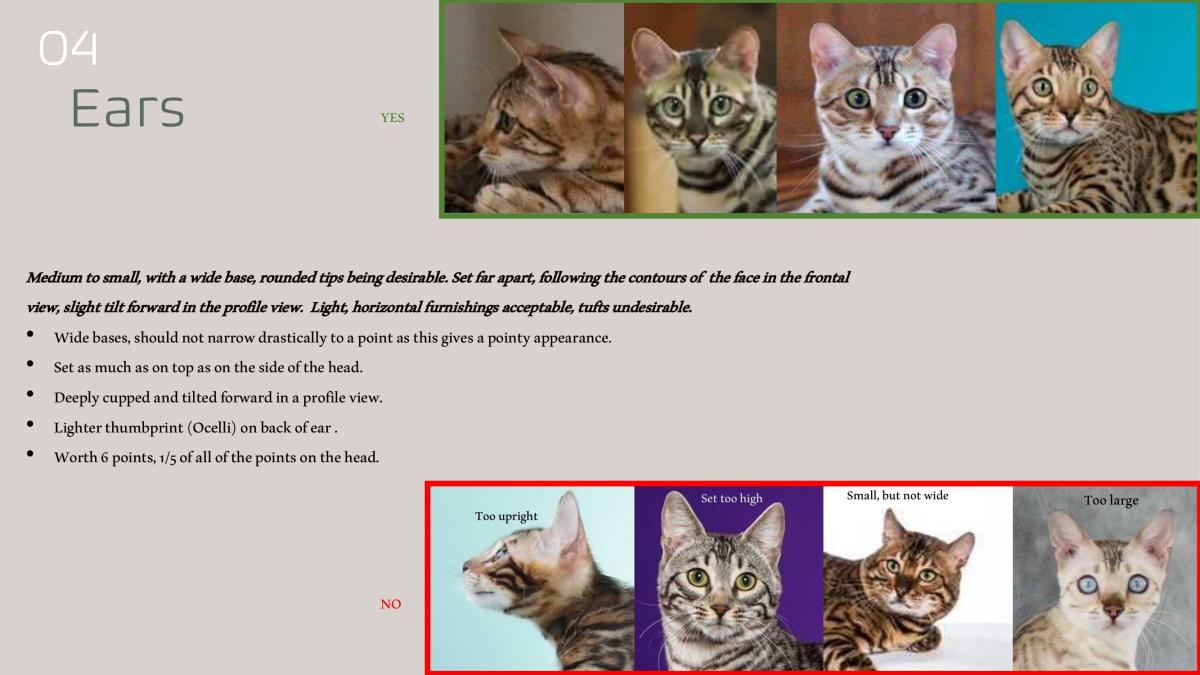
EARS
Medium to small, with a wide base, rounded tips being desirable. Set far apart, following the contours of the face in the frontal view, slight tilt forward in the profile view. Light, horizontal furnishings acceptable, tufts undesirable.
• Wide bases, should not narrow drastically to a point as this gives a pointy appearance.
• Set as much as on top as on the side of the head.
• Deeply cupped and tilted forward in a profile view.
• Lighter thumbprint (Ocelli) on back of ear .
• Worth 6 points, 1/5 of all of the points on the head.
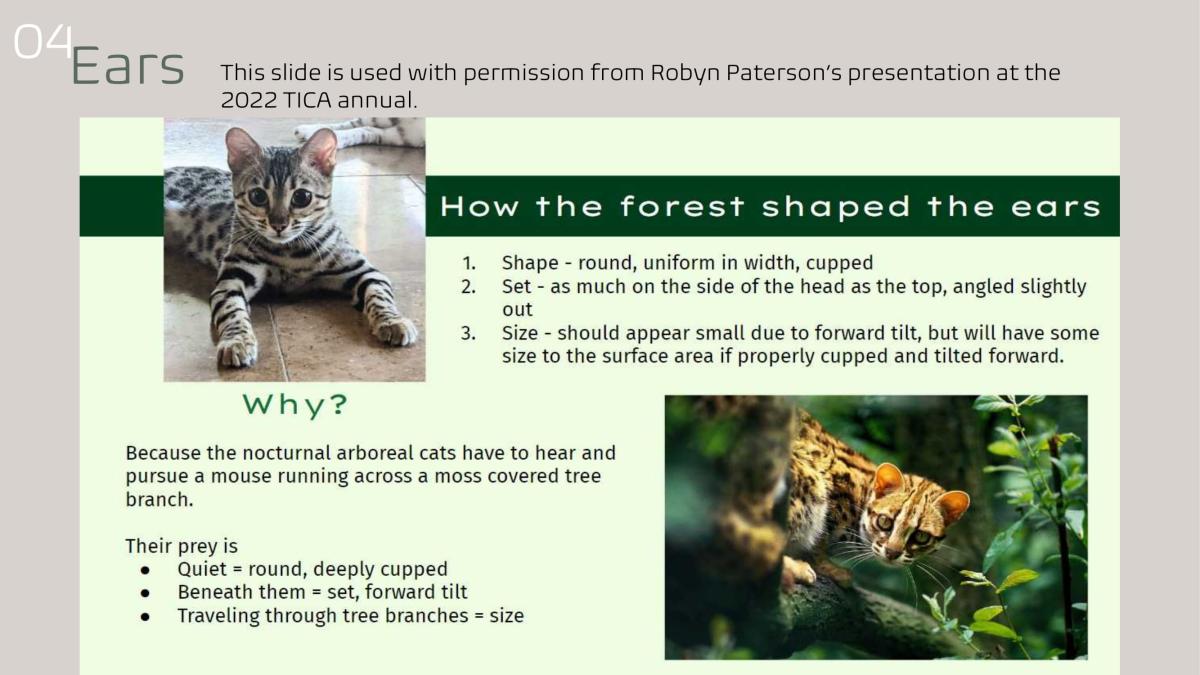
EYES
Shape is round to oval. Large, but not bugged, set wide apart, with a slight bias toward the base of ear, when oval in shape. Eye color independent of coat color except in Lynx Points, where Blue is the only acceptable color. Richness and depth of color is always preferred. * Breed council is debating changes currently, look for this to be updated in the near future.
• Nocturnal look – Size (large) and position are more important than the shape when the goal is to achieve a nocturnal expression. Eyes should be set in the lower third of the face.
• Large but not bugged: the cat should be alert or excited when evaluating in order to see the eye at its largest.
• Widely set- Slight bias toward the ear
• Richness and depth of color preferred.
• Worth 6 points, 1/5 of all the points on the head
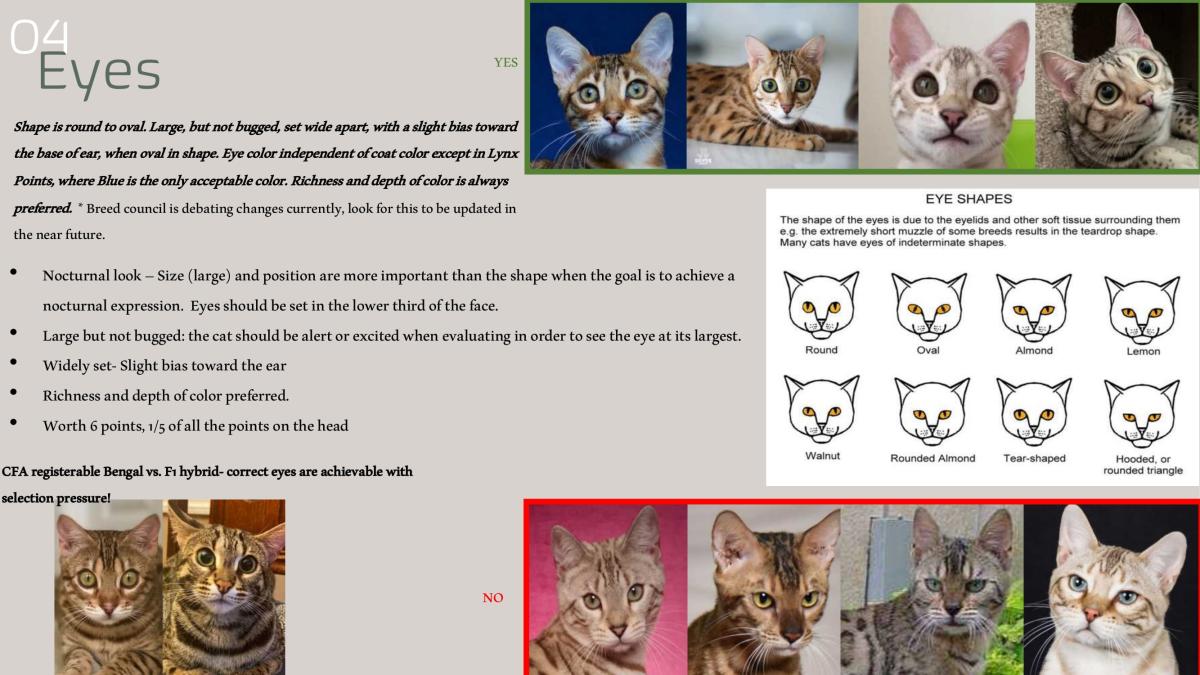
Eyes
This slide is used with permission from Robyn Paterson's presentation at the 2022 TICA annual.
How the forest shaped the eyes
The Leopard cat (top left) and the Margay (bottom left) live in forests on different continents, but their eyes are similar because they are fit for purpose.
Cats who hunt by the dappled moonlight in trees need eyes that are: Large
Set forward on the face Large surface area to the lens
Notice the different eye structure on the Pallas cat (top right) and Serval (bottom right). They hunt at dawn and dusk in the glare of the sun.
The eyes are deeply set to protect them from glare.
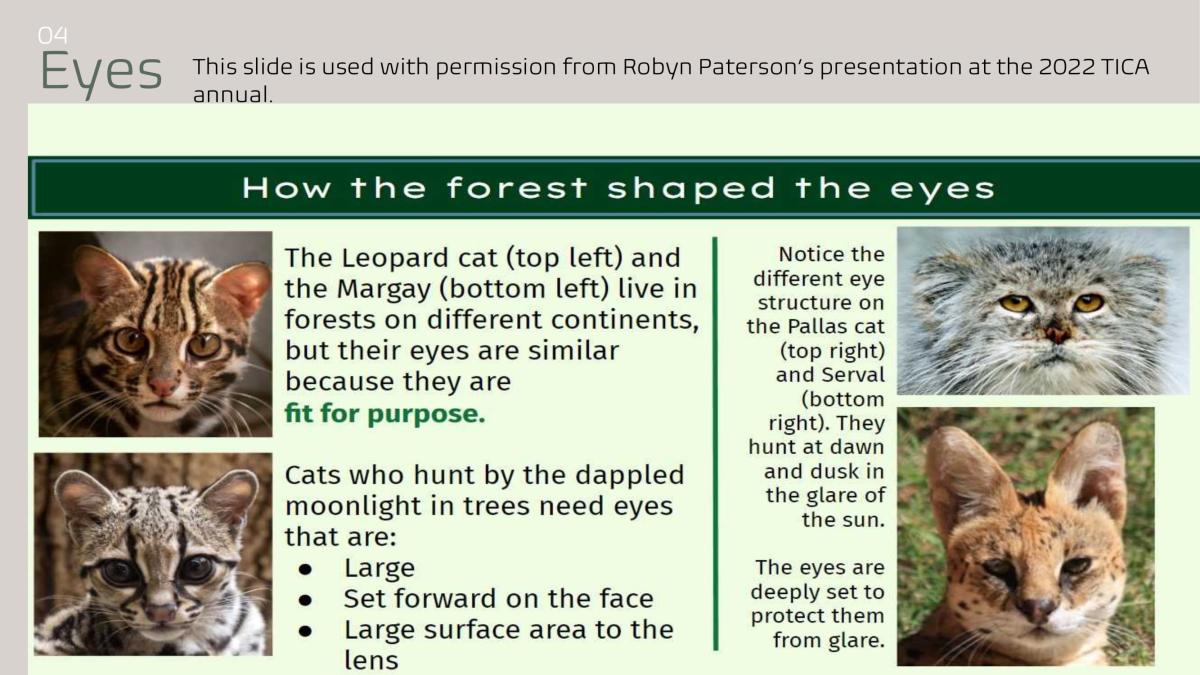
Eyes
This slide is used with permission from Robyn Paterson's presentation at the 2022 TICA annual.
How the forest shaped the eyes
Why?
1. The eyes should be a dominating feature on the face.
2. To get the best look, play with the Bengals in their cages. The bright light on your judging table will be too bright for a nocturnal eye.
3. Assess the surface area of the lens from profile view.
Because the nocturnal arboreal cats hunt in dappled moonlight, their eyes are structured to let as much light in as possible. Their eyes must let light in which influences every aspect of their formation.
- Size
- Set
- Surface area of the lens
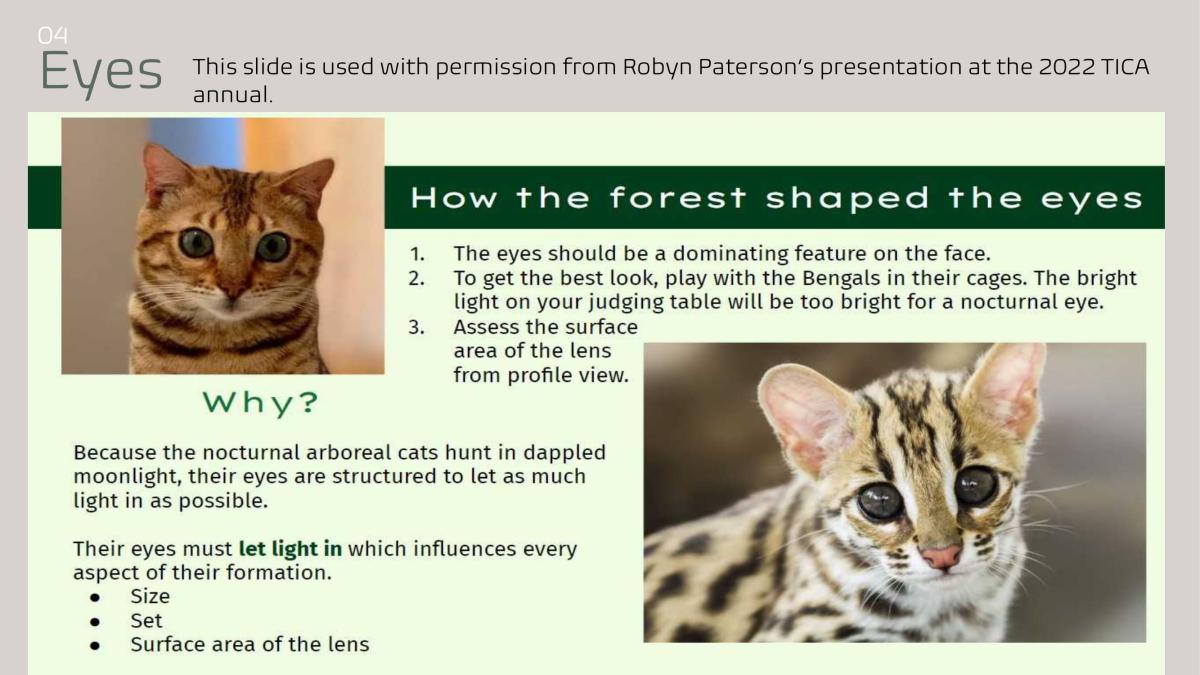
CHIN
Strong, substantial, aligns with the tip of the nose in profile.
• Worth 3 points, the least of any one feature of the head.
• Keep in mind that the jaw structure and the muscles attaching to the chin also affect the visible depth of the chin, for this reason it’s best to evaluate the chin at a relaxed position vs. manipulating any part of the head or neck.
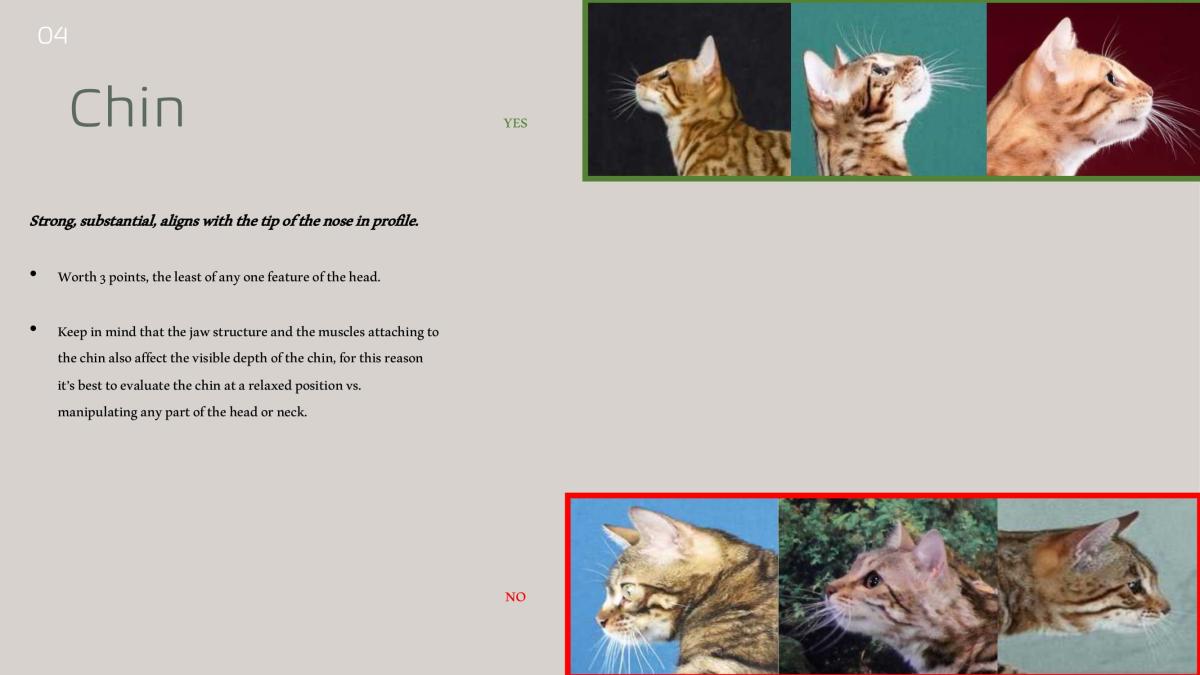
Chin
This slide is used with permission from Robyn Paterson's presentation at the 2022 TICA annual.
How the forest shaped the chin
The chin is the bottom attachment point of the jaw muscles. Bengal chin muscles are sometimes visible when the chin muscles are relaxed and drop forward.
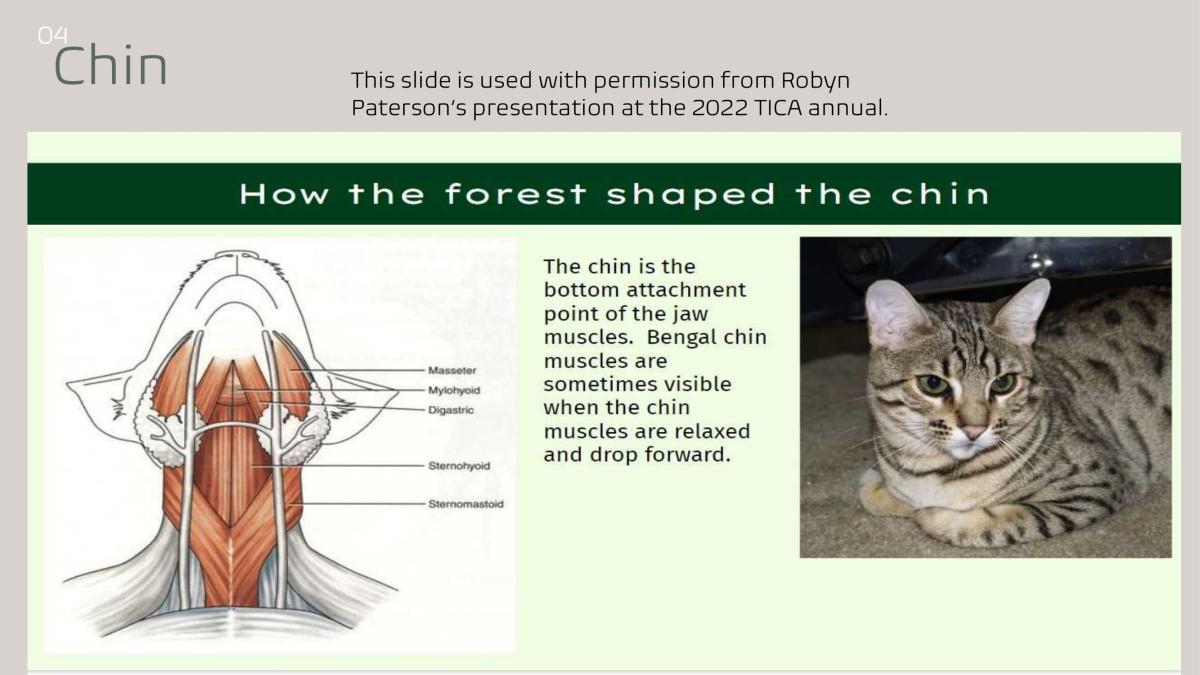
Body
Long and substantial, muscular, particularly the males. Hindquarters slightly higher than shoulders.
• Correct body shape of a Bengal reflects the shape of a small forest dwelling jungle cat.
• Long and lithe, yet athletic and well muscled.
• Torso shape should be lean and no tendency toward barrel chest. No belly tuck in adult cats.
• Weight should be centered on the muscular rear legs, body should deepen towards the rear as a result of the primordial pouch and musculature.
• Longer rear legs.
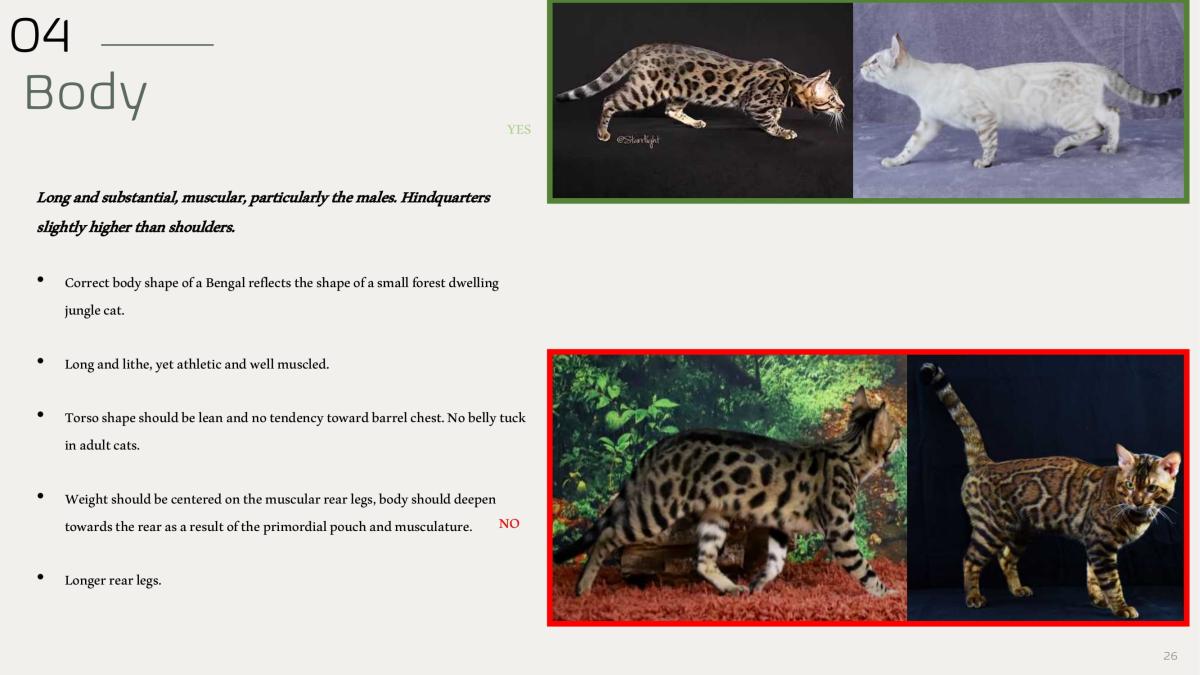
Body
How the forest shaped the body
Primordial Pouch
Primordial pouches are not required. There is no preference for or against them. Please don't discredit a cat with pouches.
The unique trees of Asian forests have shaped the Bengal cat because trees in Asian forests are tall and widely spaced.
Many animals, including the small wildcats, that live in canopy of the Asian forests evolved a larger flap of skin that stretches out further allowing for longer jumps from tree branch to a tree branch as it creates a slight gliding ability.
While all cats have a primordial pouch, the Leopard cat has morphed this into a larger feature that gives the Asian forest dwellers the ability to stay in the air a little bit longer to make those long jumps from tree to tree.
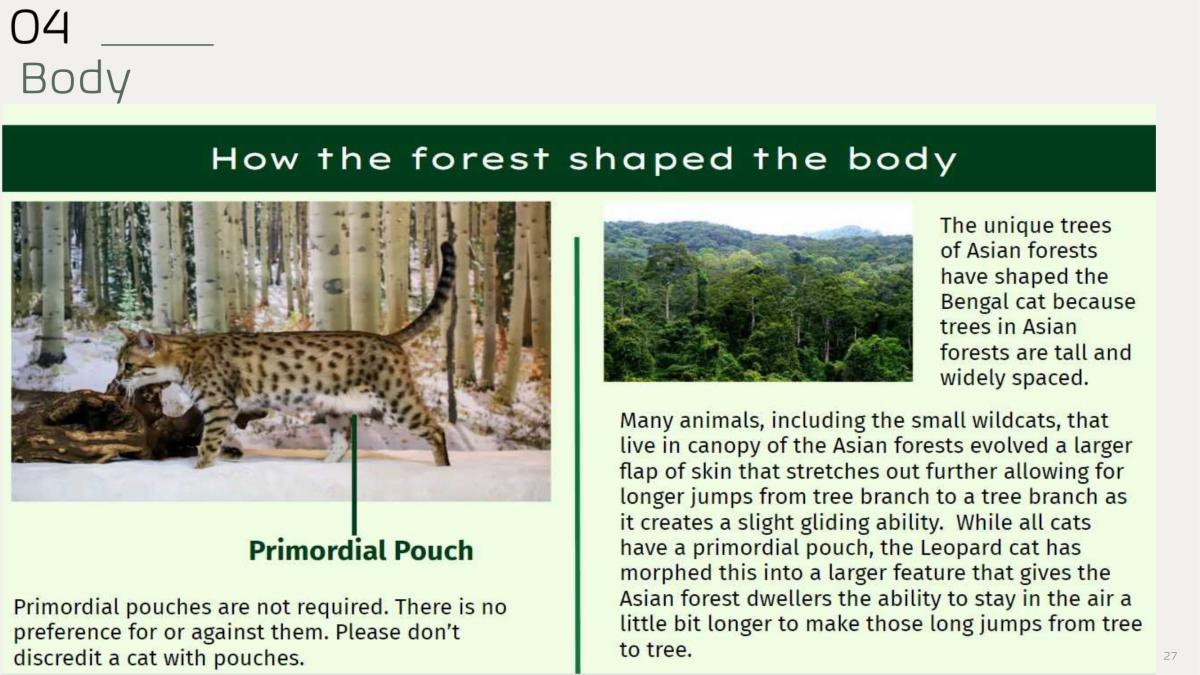
Body
Bone: Substantial, never delicate.
The heavier bone structure is especially evident in the legs, they should give an impression of a sturdy, well built cat.
Legs: Medium long, slightly longer rear legs.
Muscular.
A Bengal's legs are built for running, leaping, climbing and other athletic endeavors.
Paws: Large and round, with prominent knuckles.
The feet of the Bengal are proportionally larger than many other breeds, likely due to larger boning.
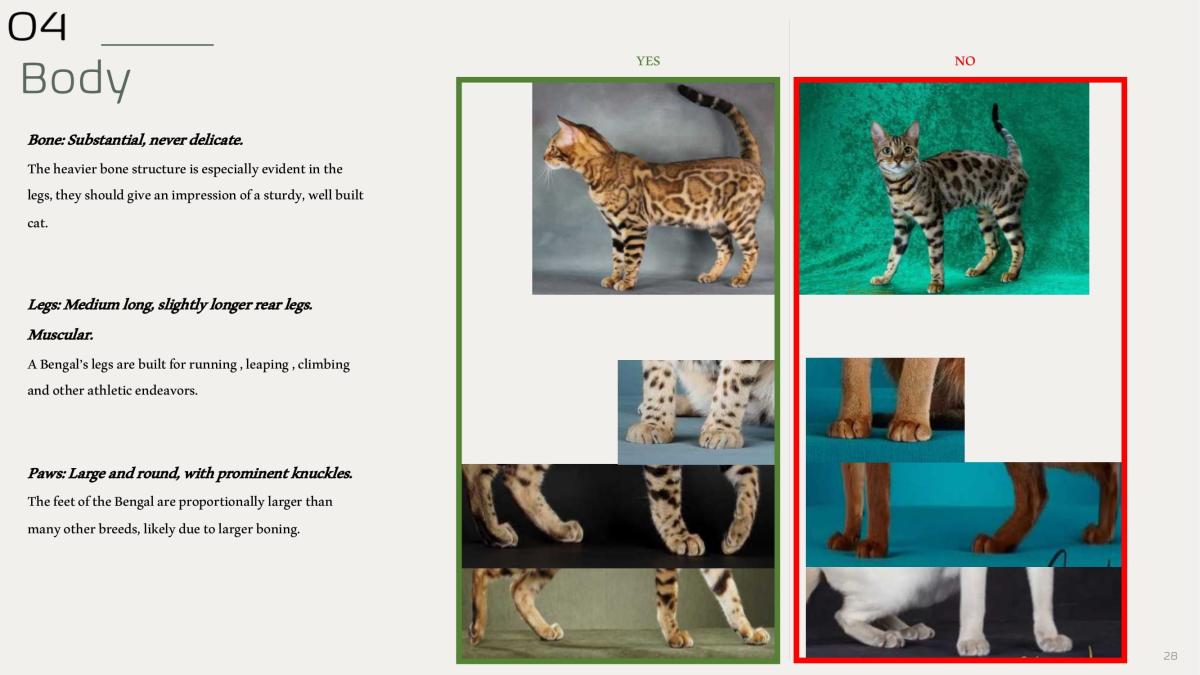
Body
Tail: Thick, tapered at the end with a rounded tip. Medium in length, in proportion to the body.
• Tail set – Tail should be carried low with an allowance for “happy tail” when the cat is confident and alert and carries the tail straight up.
• Rosetted and spotted tails should be given extra merit.
• “Squirrel Tail” where the cat carries the tail over the back is not correct.
• Whippy, thin tails are not desirable and more prone to injury in an active cat.
• There is a wide variation of normal boning / musculature of tails in this breed, palpable differences should not be penalized unless it is an obvious deformity or change in direction.
• Handling should be limited to 2-3 passes down the length of the tail.
• Visible faults should always be disqualified.
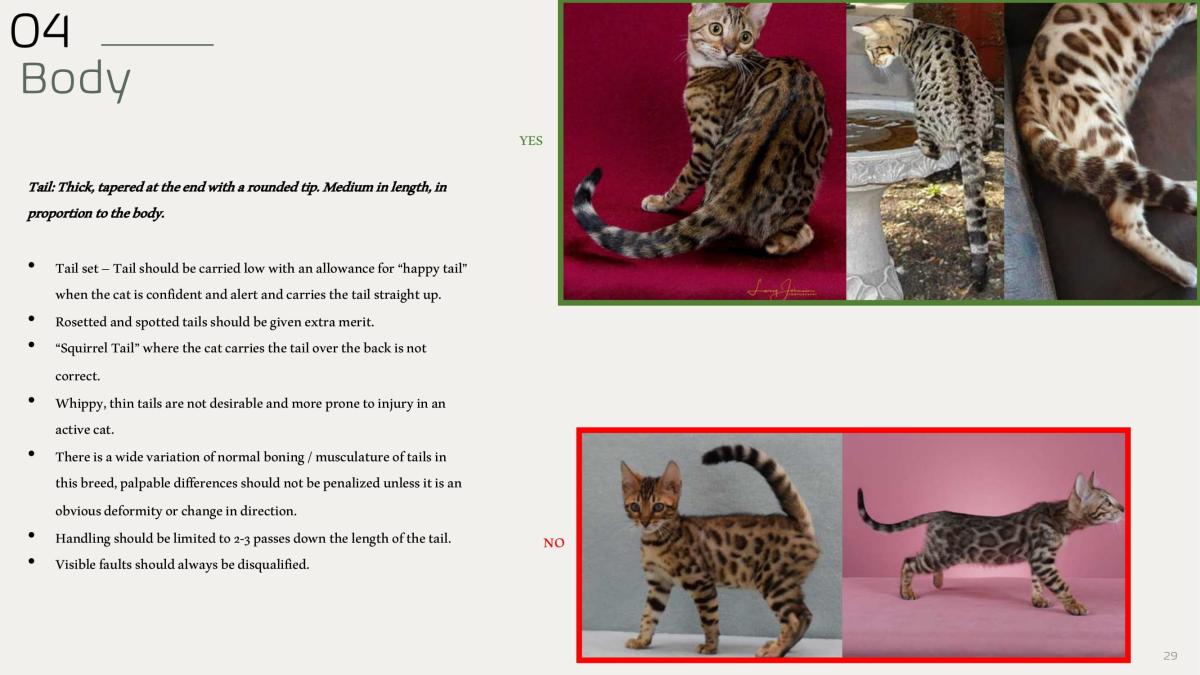
Acknowledgements and Full Credits to: https://cfa-files.s3.us-east-2.amazonaws.com/breed-presentations/Bengal.pdf
Penalize
Rosetted/Spotted Tabby Pattern-
Rosettes or spots running together vertically forming a mackerel tabby pattern. Being rosetted does not make the vertical better, in fact, a greater percentage of the pattern is wasted by undesirable pattern flow.
• Marble Tabby Pattern- Circular bull’s eye pattern. Bengals should never resemble the classic tabby pattern of other breeds. The pattern should be elongated and broken, no roundness should be seen in the alignment, only horizontal or diagonal flow.
• Snow Tabby Pattern- Substantially darker point color as compared to color of body markings. Although the lynx coloration is temperature controlled, the goal of the Bengal breed is to have as much uniformity in the color of
the markings throughout points and body. The exact (all examples on this page show faults) Double, rosetted vertical bars Vertical rib bar Vertical rib bar
All marbles pictured are too circular. All lynx points are lacking in body contrast as compared to their points opposite from breeds such as the Siamese
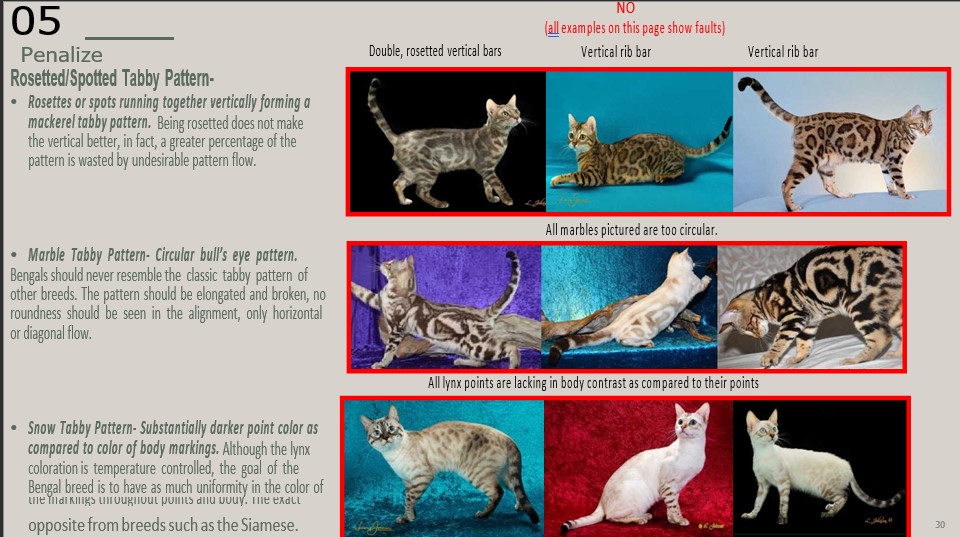
Disqualify:
Rosetted/ Spotted Tabby , Marble Tabby, Charcoal Tabby, Snow Tabby Patterns –
• Belly not patterned. Any distinct locket on neck, chest, abdomen, or anywhere else. Lockets are
not a form of “white expression”. Countershading / white expression is the paling of the ventral sides of the cat, while still exhibiting normal pattern elements such as spotting on the belly, markings on the neck and inside of the legs.
• Kinked, or otherwise deformed tail.
Because Bengal tails are to be thick and muscular, they are often able to mimic tension faults and hold their tail tips stiffly. Evaluations of the tail should be done from a relaxed position with all four feet on the table. Visible kinks should always be disqualified. Palpable irregularities are not an issue which impacts the health or function of the cat.
• Cowhocking.
This a structural fault with a serious impact on function, it will impact the cat’s range of motion and quality of life.
• Crossed eyes.
Most apparent with the seal series , this also impacts vision.
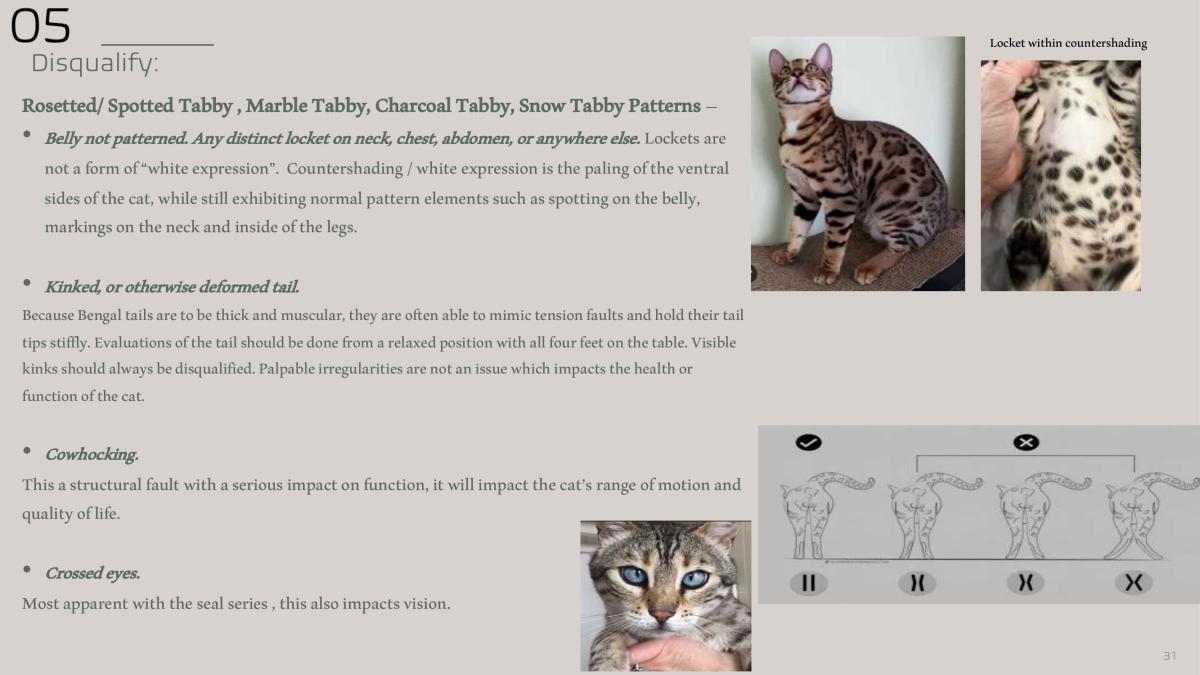
Acknowledgements and Full Credits to: https://cfa-files.s3.us-east-2.amazonaws.com/breed-presentations/Bengal.pdf
Exhibition Handling
• Clear the judging space : Bengals are a long and energetic breed; they are likely to knock things over in a frenzy for the judging toy.
• Use a toy! Bengals need that distraction to perform at their best. Especially with the kitten class, they need to have positive association with coming out on the table.
• Giving the cat all four feet on the table allows them to feel secure and relaxed, also aids in checking the tail conformation as they will be more apt to relax.
• Feeling the tail: A judge should be able to ascertain an obvious tail fault within 2-3 swipes down a cat’s tail. Rolling, pinching, and digging at the tail to find a fault will irritate the cat, give a negative association with handling on the judge’s table and is greatly discouraged.
Acknowledgements and Full Credits to: https://cfa-files.s3.us-east-2.amazonaws.com/breed-presentations/Bengal.pdf
The Bengal Timeline
1961
Jean Mill imports an ALC female. Later, in 1963, she crosses it with a solid black DSH male. The project is abandoned when Mill is widowed.
1980
Dr. Willard Centerwall, who was researching the ALC's possible natural immunity to Feline Leukemia gives Mill the F1 hybrids that are the foundation of the breed as we know it.
1982
Millwood Tory of Delhi is imported for
from India, introduces the gene glitter into the breed. His sister, Tasha was imported at the same time and although not glittered, she likely carried the gene.
1985
Mill began showing her Bengals in the new breed category of TICA, later her 2nd generation queen Penny Ante captivated audiences with her friendly temperament. Also in 1985, CFA retracted Mill's Indian Mau registrations as the pressure mounted against her wild hybrids.
1987
A new kind of Bengal is born,
the marble pattern... Mill credits these cats with contributing the 'outlining gene' and the first rosettes were born from descendants.
1992
TICA acceptance:
TICA admitted the breed into championship status, cats four generations removed from outcrosses are considered domestic and able to be shown.
1990s
After official recognition the Bengal breed is the fastest growing breed over the next decade.
1993
Marble Bengals were accepted into TICA and the snows/seal series in the subsequent years
2016
Accepted for Miscellaneous Status in CFA. Cats must be 6 generations removed to be eligible for registration and exhibition.
2018
Bengals accepted in CFA. After 1 year in the Miscellaneous class, CFA's executive board votes to accept Bengals as a Championship breed in CFA.
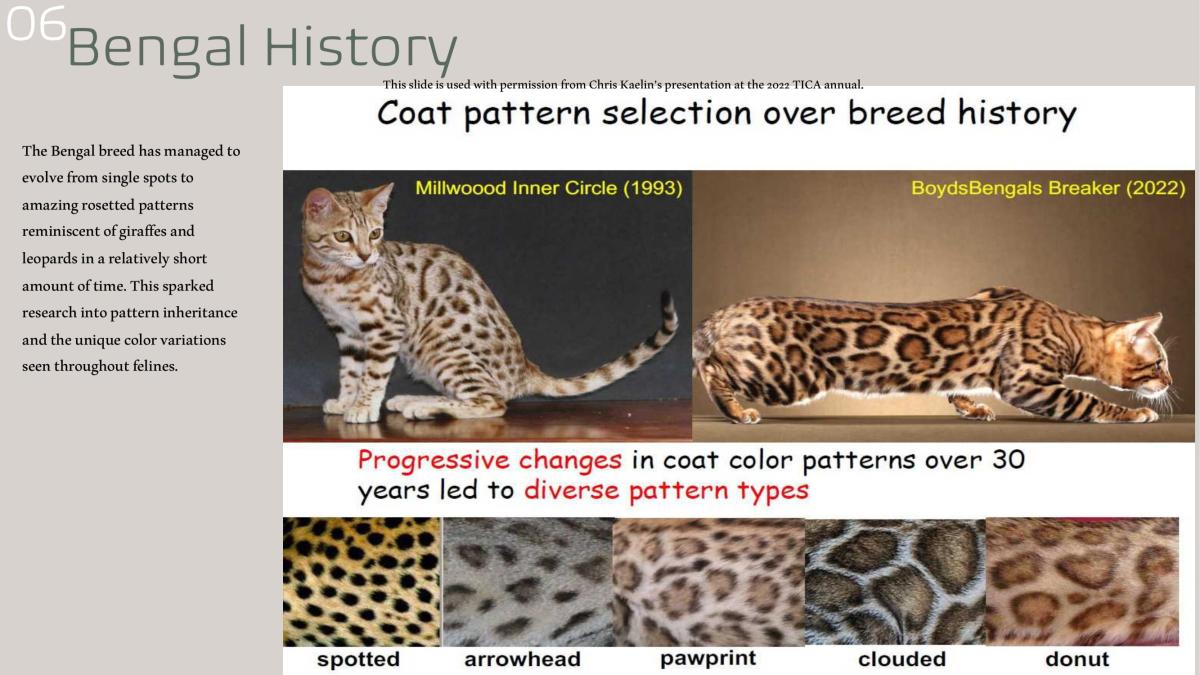
Bengal History
The Bengal breed has managed to evolve from single spots to amazing rosetted patterns reminiscent of giraffes and leopards in a relatively short amount of time. This sparked research into pattern inheritance and the unique color variations seen throughout felines.
Coat pattern selection over breed history
- Millwoood Inner Circle (1993)
- Boyds Bengals Breaker (2022)
Progressive changes in coat color patterns over 30 years led to diverse pattern types
- spotted
- arrowhead
- pawprint
- clouded
- donut
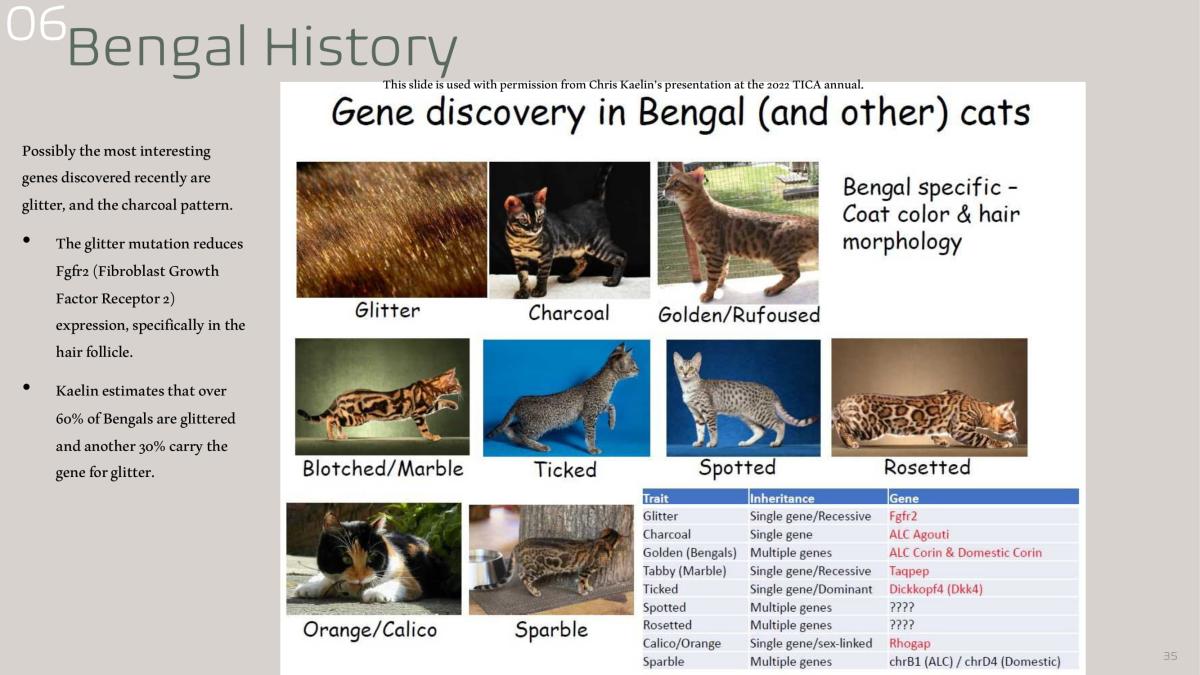
Bengal History
Possibly the most interesting genes discovered recently are glitter, and the charcoal pattern.
- The glitter mutation reduces Fgfr2 (Fibroblast Growth Factor Receptor 2) expression, specifically in the hair follicle.
- Kaelin estimates that over 60% of Bengals are glittered and another 30% carry the gene for glitter.
Gene discovery in Bengal (and other) cats
Bengal specific - Coat color & hair morphology
- Glitter
- Charcoal
- Golden/Rufoused
- Blotched/Marble
- Ticked
- Spotted
- Rosetted
- Orange/Calico
- Sparble
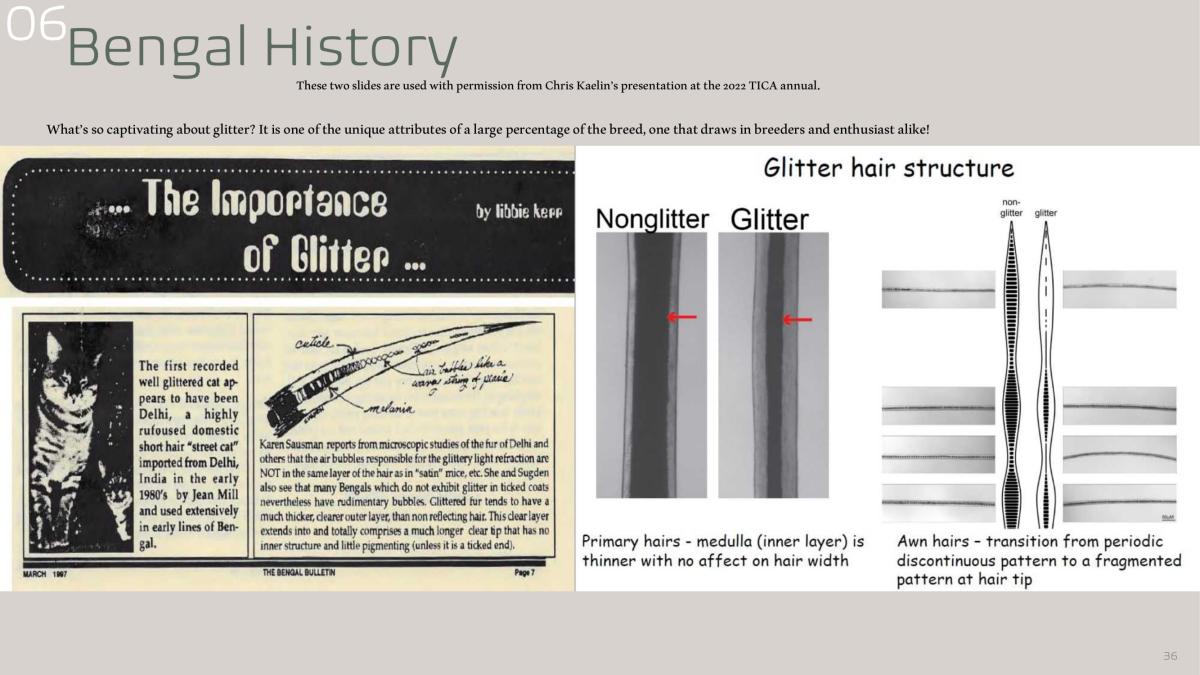
Bengal History
What's so captivating about glitter? It is one of the unique attributes of a large percentage of the breed, one that draws in breeders and enthusiast alike!
The Importance of Glitter ...by libbie kepp
The first recorded well glittered cat ap- pears to have been Delhi, a highly rufoused domestic short hair "street cat" imported from Delhi, India in the early 1980's by Jean Mill and used extensively in early lines of Bengal.
Karen Sausman reports from microscopic studies of the fur of Delhi and others that the air bubbles responsible for the glittery light refraction are NOT in the same layer of the hair as in "satin" mice, etc. She and Sugden also see that many Bengals which do not exhibit glitter in ticked coats nevertheless have rudimentary bubbles. Glittered fur tends to have a much thicker, clearer outer layer, than non reflecting hair. This clear layer extends into and totally comprises a much longer clear tip that has no inner structure and little pigmenting (unless it is a ticked end).
Glitter hair structure
- Primary hairs - medulla (inner layer) is thinner with no affect on hair width
- Awn hairs - transition from periodic discontinuous pattern to a fragmented pattern at hair tip
Acknowledgements and Full Credits to: https://cfa-files.s3.us-east-2.amazonaws.com/breed-presentations/Bengal.pdf
BENGAL BREED GROUP (BG/BGL)
Updated 04/27/20 Bengal Breed Group Standard, 05/01/2020
HEAD ……………………………………………………………. 35 points
Shape ……………………………………………………………........ 6
Ears ………………………………………………………………... 6
Eyes ………………………………………………………………... 5
Chin ………………………………………………………………... 3
Muzzle …………………………………………………….................. 4
Nose …………………………………………………………………... 2
Profile ……………………………………………………………........ 6
Neck …………………………………………………………………… 3
BODY ……………………………………………………………. 30 points
Torso ………………………………………………………………….. 5
Legs ……………………………………………………………….. 4
Feet ………………………………………………………………... 4
Tail …………………………………………………………………….. 5
Boning …………………………………………………….................. 6
Musculature …………………………………………………………... 6
COAT/COLOR/PATTERN …………………………………….. 35 points
Texture …………………………………………………………… 10
Pattern ……………………………………………………........... 15
Color ……………………………………………………………… 10
CATEGORIES: All DIVISIONS: Tabby, Silver/Smoke.
COLORS: Brown Tabby, Seal Sepia Tabby, Seal Mink Tabby, Seal Lynx
Point, Black Silver Tabby, Seal Silver Sepia Tabby, Seal Silver Mink
Tabby, Seal Silver Lynx Point, Spotted, marbled, charcoal spotted and
charcoal marbled patterns ONLY.
PERMISSIBLE OUTCROSSES: None.
HEAD:
BG Shape: Broad modified wedge with rounded contours. Longer than it is wide. Slightly small in proportion to body, but not to be taken to extreme. The skull behind the ears makes a gentle curve and flows into
the neck. Allowance to be made for jowls in adult males. Overall look of the head should be as distinct from the domestic cat as possible.
BGL Shape: Broad modified wedge with rounded contours. Longer than it is wide. Slightly small in proportion to body, but not to be taken to extreme. The skull behind the ears makes a gentle curve and flows into the neck. Allowance to be made for jowls in adult males. Feathering behind the ears and into ruff, giving a frontal effect of roundness framing the head is desirable. A mane is acceptable but not required. Overall look of the head should be as distinct from the domestic cat as possible.
BG Ears: Medium to small, relatively short, with wide base and rounded tops. Set as much on side as top of head, following the contour of the face in the front view, and pointing forward in the profile view. Light horizontal furnishings acceptable; lynx tipping undesirable.
BGL Ears: Medium to small, relatively short, with wide base and rounded tops. Set as much on side as top of head, following the contour of the face in the front view, and pointing forward in the profile view.
Horizontal furnishings are acceptable. Lynx tipping is permissible.
Eyes: Oval, almost round. Large, but not bugged. Set wide apart, back into face, and on slight bias toward base of ear. Eye color independent of coat color except in the lynx points. The more richness and depth of color the better.
Chin: Strong chin, aligns with tip of nose in profile.
Muzzle: Full and broad, with large prominent whisker pads and high, pronounced cheekbones. Slight muzzle break at the whisker pads.
Nose: Large and wide; slightly puffed nose leather.
Profile: Curve of the forehead should flow into the bridge of the nose with no break. Bridge of nose extends above the eyes; the line of the bridge extends to the nose tip, making a very slight, to nearly straight,
concave curve.
Neck: Long substantial, muscular; in proportion to the head and body.
BODY:
Torso: Long and substantial, not oriental or foreign. Medium to large (but not quite as large as the largest domestic breed).
BG Legs: Medium length, slightly longer in the back than in the front.
BGL Legs: Medium length, slightly longer in the back than in the front. Britches should be medium to short Toe hair is acceptable.
Feet: Large, round, with prominent knuckles.
BG Tail: Medium length, thick, tapered at the end with a rounded tip.
BGL Tail: Medium length, thick, tapered at the end with a rounded tip. The tail hair should be long and voluminous. Allowance for shorter tail hair in kittens.
Boning: Sturdy, firm; never delicate.
Musculature: Very muscular, especially in the males, one of the most distinguishing features.
COAT/COLOR/PATTERN:
BG Length: Short to medium. Allowance for slightly longer coat in kittens.
BGL Length: The coat should be medium to long in length lying close to the body, with furnishings. Allowance for slightly shorter coat in kittens.
Texture: Dense and luxurious, close-lying, unusually soft and silky to the touch.
Patterns: Spotted, Marbled, Charcoal Spotted, Charcoal Marbled.
Spotted: Spots shall be random or aligned horizontally. Rosettes showing two distinct colors or shades, such as paw print shaped, arrowhead shaped, doughnut o half-doughnut shaped or clustered are
preferred to single spotting, but not required. Contrast with ground color must be extreme, giving distinct pattern and sharp edges. Strong bold chin strap and mascara markings desirable. Virtually white undersides and belly desirable. Blotchy horizontal should streaks, spotted legs, and spotted or rosetted tail are desirable. Belly must be spotted. Marbled: See TICA Uniform Color Description (74.1.1.2.1).
Charcoal Spotted/Marbled: See TICA Uniform Color Description (71.8.3).
Brown Tabby: All variations of brown are allowed. Markings various shades of brown to black. Light spectacles encircling the eyes and a virtually white ground color on the whisker pads, chin, chest, belly and
inner legs are desirable. Seal Sepia Tabby, Seal Mink Tabby, and Seal Lynx Point Tabby: Pattern can be various shades of brown. There should be very littledifference between the color of the body (pattern) markings and poin tcolor.
GENERAL: The goal of the Bengal breeding program is to create adomestic cat which has physical features distinctive to the small forestdwelling wildcats, and with the loving, dependable temperament of the
domestic cat. Keeping this goal in mind, judges shall give special merit to those characteristics in the appearance of the Bengal which are distinct from those found in other domestic cat breeds. A Bengal cat is an athletic animal, alert to its surroundings; a friendly, curious, confident cat with strength, agility, balance and grace. It is a medium to large which exhibits a very muscular and solid build. Its wide nose with prominent whisker pads and large oval, almost round eyes in a slightly small head enhance the wild appearance and expressive nocturnal look. Its very slight, to nearly straight, concave profile and relatively short ears with wide base and rounded tips add to the Bengal’s distinctive and unique appearance. The short, dense coat has a uniquely soft and silky feel. The coat may be glittered or not glittered, with neither type to be given preference. A thick,low-set, medium-length tail adds balance to the cat.
ALLOWANCES: Smaller size, in balanced proportion of females. Slightly longer coat in kittens. Jowls in adult males. Eyes slightly almond shaped. Mousy undercoat. Paw pads not consistent with color group description.
PENALIZE: Spots on body running together vertically forming a mackerel tabby pattern on spotted cats; circular bulls-eye pattern on marbled cats; substantially darker point color (as compared to color of body markings) in Seal Sepia, Seal Mink, or Seal Lynx Point cats EXCEPT in the case of any Charcoal Sepia, Charcoal Mink or Charcoal Lynx Point cats. Any distinct locket on the neck, chest, abdomen or any other area.
WITHOLD ALL AWARDS (WW): Belly not patterned. Temperament must be unchallenging; any sign of definite challenge shall disqualify. The cat may exhibit fear, seek to flee, or generally complain
aloud but may not threaten to harm. In accordance with Show Rules,
ARTICLE SIXTEEN, the following shall be considered mandatory
disqualifications: a cat that bites (216.9), a cat showing evidence of
intent to deceive (216.10), adult whole male cats not having two
descended testicles (216.11), cats with all or part of the tail missing ,
except as authorized by a board approved standard (216.12.1), cats with
more than five toes on each front foot and four toes on each back foot,
unless proved the result of an injury or as authorized by a board approved
standard (216.12.2), visible or invisible tail faults if Board approved
standard requires disqualification (216.12.4), crossed eyes if Board
approved standard requires disqualification (216.12.5), total
blindness (216.12.6), markedly smaller size, not in keeping with the breed
(216.12.9), and depression of the sternum or unusually small diameter of
the rib cage itself (216.12.11.1). See Show Rules, ARTICLE SIXTEEN for
more comprehensive rules governing penalties and disqualifications.
While you can train a Bengal to have "good manners", they are an active, inquisitive cat that loves to be up high. If you don't like a cat to leave the floor, a Bengal is probably not the right cat for you. Bengals are busy by nature. They are very affectionate and can be a "lap cat" whenever THEY want to be, but in general their idea of fun is playing, chasing, climbing and investigating. When a Bengal is in full play mode, it's rather like trying to hold on to running water! They'll often save the cuddle time for when they want to sleep. Many Bengals enjoy water and may join you in brushing your teeth or taking a shower. Some Bengals are vocal while others are more quiet and selective about using their voice.
Bengals will also, in general, ALWAYS want to be where you are. After all, that's where the action is! And Bengals are all about "The Action". When given the choice of a static toy, and one that does wild, unpredictable things, Bengals will always choose the "wild" one! For individuals or families who enjoy rambunctious, funny, beautiful and dynamic feline companionship, consider the Bengal.
This was the first effort to use hybrid offspring to create a breed of domestic cat with the loving nature of a favored fireside tabby and the striking look associated with Leopards, Ocelots and Jaguars. The modern Bengal breed traces to cats bred by Mrs. Mill beginning in the early 1980's. The breed's name is a reference to the scientific name of the Asian Leopard Cat, Prionailurus bengalensis. The hybrid crosses are registered as Foundation (F1, F2 & F3) Bengals that are not eligible for show and only the females are used for breeding. Accepted as a new breed in TICA in 1986, Bengals gained championship status in 1991. They are now one of the most frequently exhibited breeds in TICA. An enthusiastic group of breeders around the world have successfully fulfilled the goal of creating a docile, civilized house cat that wears the richly patterned coat of the jungle cats and has some of the arresting features that have inspired and aroused humanity for centuries.
Loved by those who appreciate its inquisitive and loving nature, the Bengal is a medium to large cat renowned for its richly colored, highly contrasted coat of vivid spots or distinctive marbling. Originally developed from crosses between the domestic cats and the Asian Leopard Cat, the Bengal is the only domestic cat that can have rosettes like the markings on Leopards, Jaguars and Ocelots. Today's domestic Bengal cat comes only from breeding Bengals to other Bengals and requires no specialized care. Since their beginnings in 1986, the Bengal's regal beauty and alluring charm have quickly made it one of the most popular breeds. Employing scientific insights and a cooperative spirit, Bengal breeders continue to develop these stunning cats with careful selection for temperament, health and beauty. Bengals participate in TICA shows throughout the world and have a devoted following of happy pet owners who couldn't imagine sharing their lives with anything other than these feline beauties.
2016 Bengal Breed Seminar
A Brief History
The first Asian Leopard Cat documented by Western Europeans (Kerr, 1792) was captured swimming in the Bay of Bengal (hence the Latin name). That cat was taken back to camp and was bred to Kerr's domestic cat resulting in the first documented hybrids 1871 Crystal Palace Cat show featured F1 Asian Leopard Cat X domestic hybrids shown as "Hybrids"
Paul Leyhausen hybridized Leopard Cat X domestic at Germany's Max Plank Instittue 1945-1960. Dr. Leyhausen created F1 X domestic backcross (2nd generation). Leyhausen theorized the Siamese Cat descended from ALC crosses based non-African Wild Cat confirmation and ALC-like behavior and vocalizations Jean Mill was the first to cross a domestic cat with an Asian Leopard Cat (Prionailurus bengalensis) in the US, 1963. Asian Leopard Cat X Domestic Cat hybrids were shown in CFA and ACFA during the 1970s
Jean Mill's effort was a departure and success because of:
- Emphasis on creating a domestic cat NOT hybrid
- Anti-Pyramid Plans - Encourage Collaboration, Encourage Passion focus, Emphasis on Collective Accomplishment, Di
- Model and Encourage unrestrictive contracts
Bengals show in Championship in TICA, GCCF, FIFE, ACFA, CFA (2017/2018?) as well as Australian & South African Cat Fancy Organizations
The Bengal in TICA
• First Bengal registered with TICA, shortly after TICA's inception in 1982 - An F1 previously shown in ACFA
• 1986 Jean Mill registered 33 "Leopardettes" of her breeding with TICA
• Bengals showed in NBC for five years
• 1991 Brown Spotted Bengals become championship
1993 Marble pattern and Seal Lynx Point, Seal Mink & Seal Sepia colors were granted Championship
#1 in registrations, #1 exhibitions since 1992
• More Bengals registered than all but 5 breeds combined (2016 Board Agenda)
•NO Bengal has EVER been the registry's BEST Cat, Kitten or Alter
•Jean Mill credits TICA as providing the forum for validating the breed's legitimacy internationally.
•TICA took the Bengal to the world
•How can TICA registration, TICA show and TICA Memberships help the Bengal Cat Community breed BETTER Bengals?
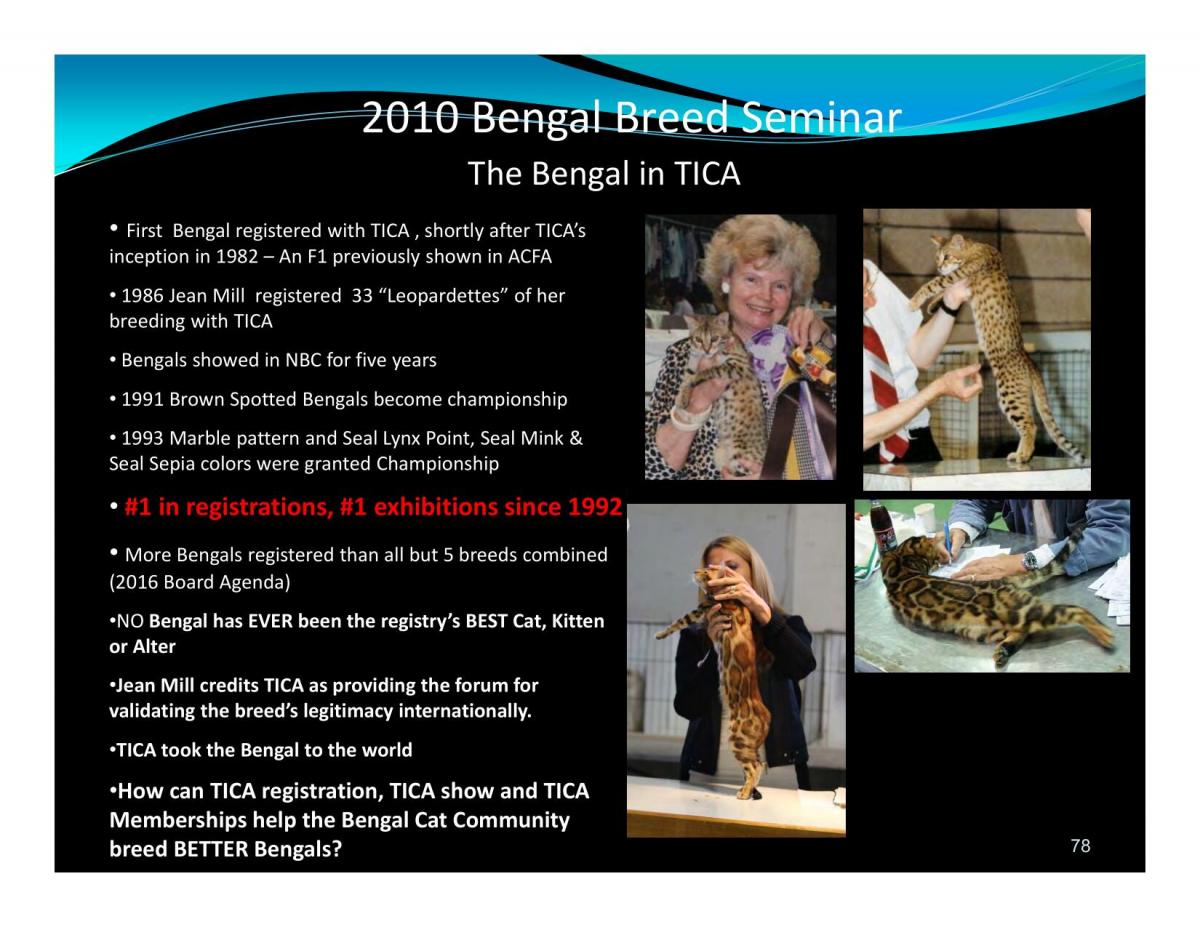
What will a Show Quality look like in the future...
based on the selection, finals and accepances now? How can we make the Bengal Cat Better?
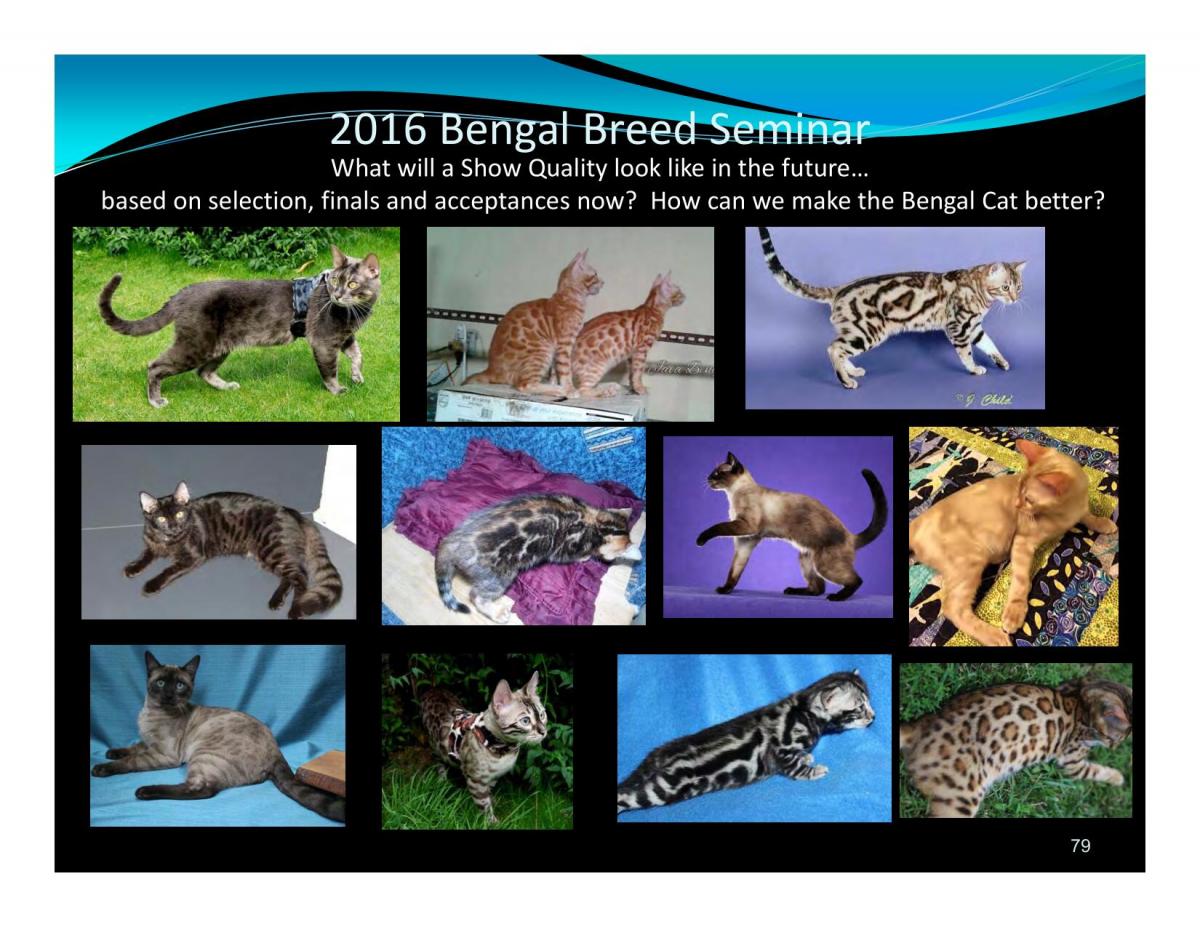
Bengals for Fun, Show and More
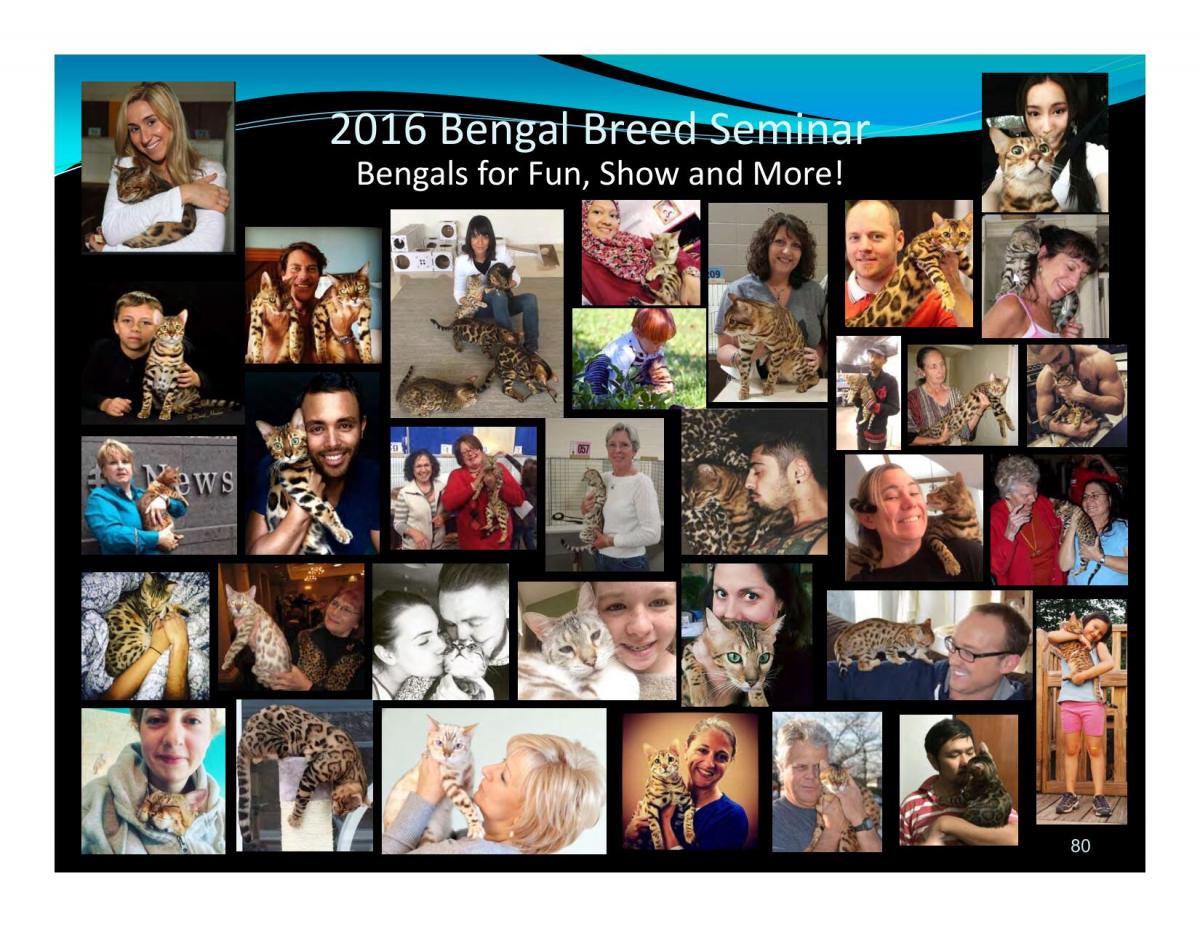
Bengal Cat Community & Science
The Bengal Cat community has been actively engaged with the scientific community since the very beginning. Many Bengal Cats have been part of the research to improve understanding, increase appreciation and innovate selection in cats, mammals and all life. They should be applauded
Charcoal in existing Championship Bengal Cat Colors & Patterns
- Brown (black) Tabby
- Black Silver Tabby
- Seal Albino Series Tabby
ASIP Discordance
ANIMAL GENETICS
Charcoal Seal Lynx and Brown Charcoal siblings
8 Open Access Creative Commons
Short Communication
Who's behind that mask and cape? The Asian leopard cat's Agouti (ASIP) allele likely affects coat colour phenotype in the Bengal cat breed
LC. Gershony, M. C. T. Penedo, B. W. Davis, W. J. Murphy, C. R. Helps, LA. Lyons
First published: 20 August 2014 Full publicatory
These two cats are littermates produced from a melanistic Jaguar father and lion mother. The dark cat is phenotypically similar in coloration to a charcoal Bengal. Because the Lion and Jaguar are likely to have an ASIP unique to their species, there was discordance in the amount of black pigment to be produced, creating the charcoal looking animal. It is not a true melanistic animal but not fully colored either.
Left to right, Seal Mink spotted, Charcoal Seal Mink Spotted and "Solid" Seal Mink spotted littermates
- CHARCOAL BENGAL
- SPOTTED PATTERNS
- ROSETTED NON-CHARCOAL BENGAL PATTERNS
- MARBLED
- CHARCOAL IS PRODUCED BY THE COMBINATION OF A DOMESTIC CAT NON-AGOUTI GENE AND AN ASIAN LEOPARD CAT AGOUTI GENE
- CONVENTIONAL TABBY FACE MARKINGS
- SPOTTED PATTERNS
- ROSETTED
- MARBLED
CHARCOAL BENGALS HAVE LITTLE OR NO RUFOUSING AND ARE DARKER AND GREYER THAN OTHER BENGALS. THEY ARE GREY-TONED RATHER THAN WARM BROWN TONED THEY TYPICALLY HAVE A "ZORRO MASK AND A CAPE (WIDE DARK DORSAL REGION) CHARCOAL BENGAL FACE MARKINGS "ZORRO MASK"
Charcoal illustration by Sarah Hartwell, messybeast.com
Understanding Agouti- Briefly
Recent genetic analysis has discovered several cat species have evolved unique ASIP, Agouti Signaling Protein, this protein signals to each hair on a cat's body to produce pigment alternating pigment or no pigment at all in a specific manner and to create an overall marking pattern. Closely related species that have melanistic forms have developed unique ASIP to create the same phenotype - a melanistic cat.
Understanding Agouti - Briefly
- Wild Cat Felis sylvestris (lybica & sylvestris)
- Asian Leopard Cat Prionailurus bengalensis
- Leon Emanuel
•All domestic cat color and pattern (pigment distribution and arrangement) is based on Felis sylvestris ASIP - the gene telling each hair when to produce the alternating bands of black & yellow pigment. Identified as A or a
•Asian Leopard Cats have their own ASIP-Apb or A2, instructing that species on pigment distributions and arrangement in each hair.
•Notice the amount of black pigment in each species and what parts of the body are the darkest. Can you visually see a degree of difference in the amount pigment variation (lightest and darkest hairs in each species? That is the morphological/phenotypical difference in their ASIP.
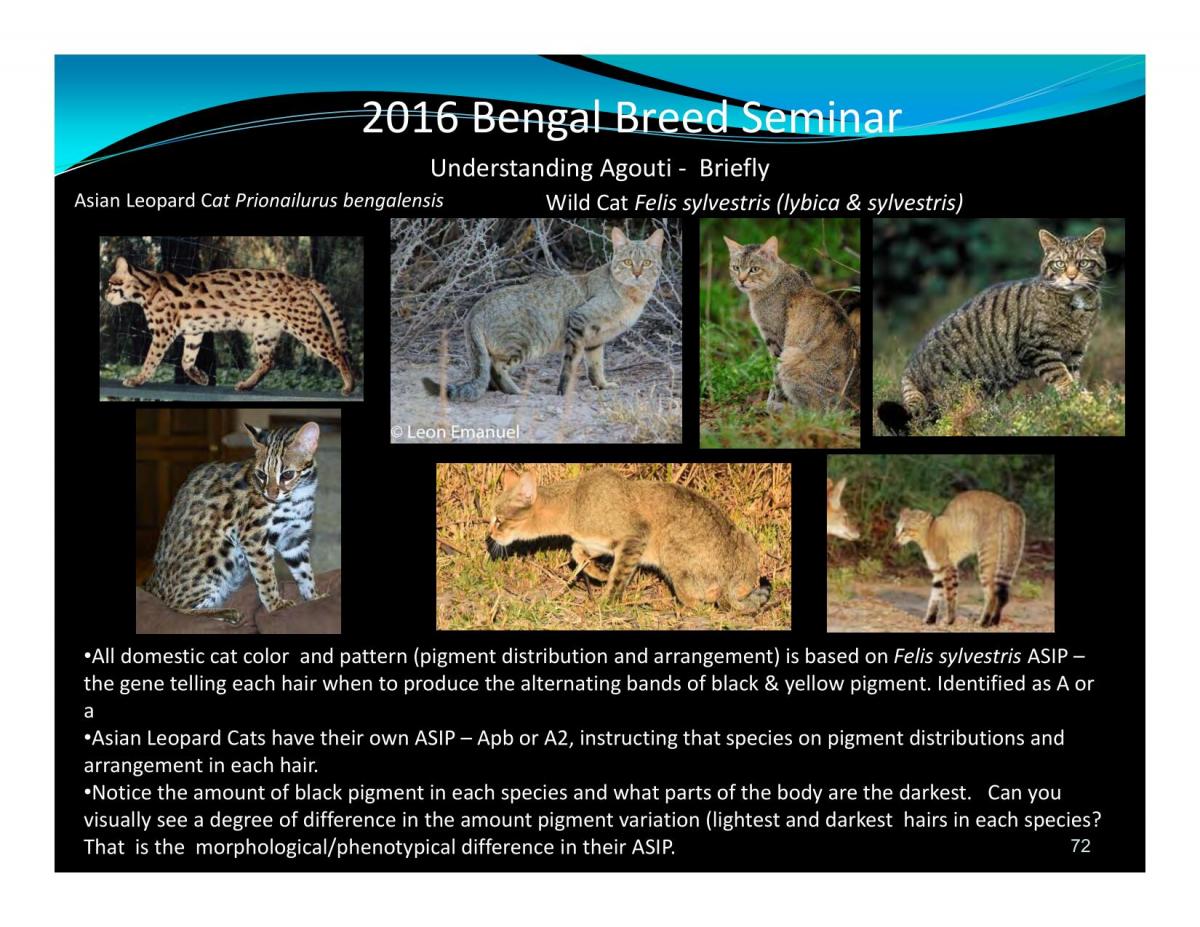
Apb - Agouti Prionailurus bengalensis
Charcoal is produced when there is a DISCORDANCE in the agouti signal different "instructions" for the cat's pigment producing mechanism. One copy of the Apb ASIP (to create A LOT of black pigment and pigment alternation like an ALC) and one copy of the Felis sylvestris ASIP a (to create Felis sylvestris amounts of black and pigment alternation)
Charcoal can also be produced when a cat inherits Apb/Apb or Apb/A2 ASIP. These cats lack the dark cap and dark cape, some lack the dark mask!
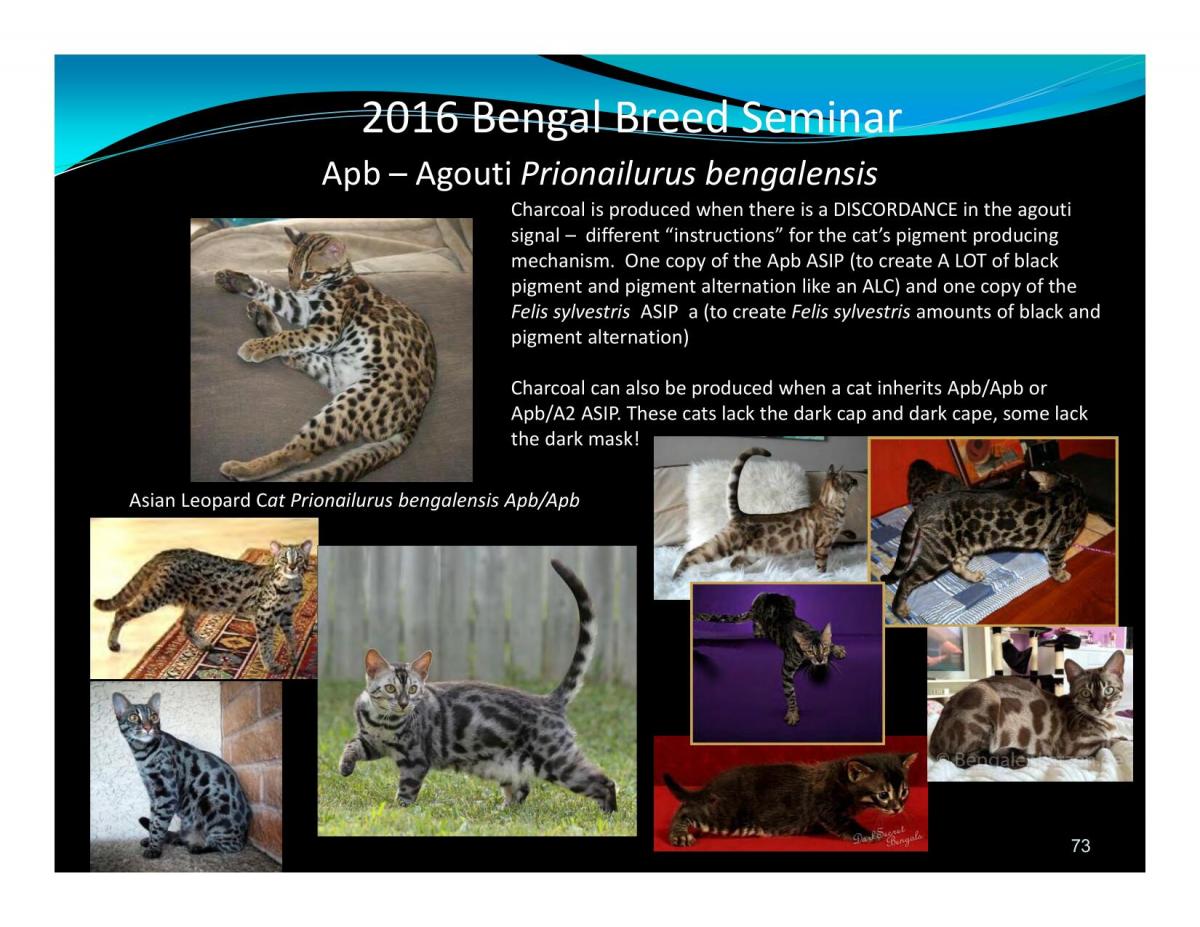
Bengal Cat Heritage - Domestic Cats
Domestic Cats of many breeds were used as outcrosses throughout the breed's history for temperament and special attributes.
1. Indian Mau (Millwood Tory of Delhi) - glitter, green eyes and bloodline
2. Egyptian Mau- mackeral spotting, silver, "solid" black, green eyes
3. Ocicat - genetic diversity, robust size, dilute colors, classic tabby pattern & lynx point
4. Abyssinian - rufousing, increased ticking
5. Burmese - sepia and mink albino series genes
6. American Shorthair - silver, heavy boning and musculature, increased bull's eye classic & mackeral
7. Domestic Shorthair - good temperament, genetic diversity, long hair, mackeral and classic tabby & ?
Foundations-F1
- The Bengal Cat is derived from hybrids between the Asian Leopard Cat (Prionailurus bengalensis) and domestic cats. These cats are considered "Foundation Bengals" and are not eligible showing.
- First generation (or A1S), Second generation domestic backcrosses and third generation domestic backcrosses males are generally sterile and only females may be used in breeding programs.
- Foundation Bengals may require more specialized care
- Bengal Cat refers to SBT (studbook) registered Bengals at least three generations removed from the F1 hybrid
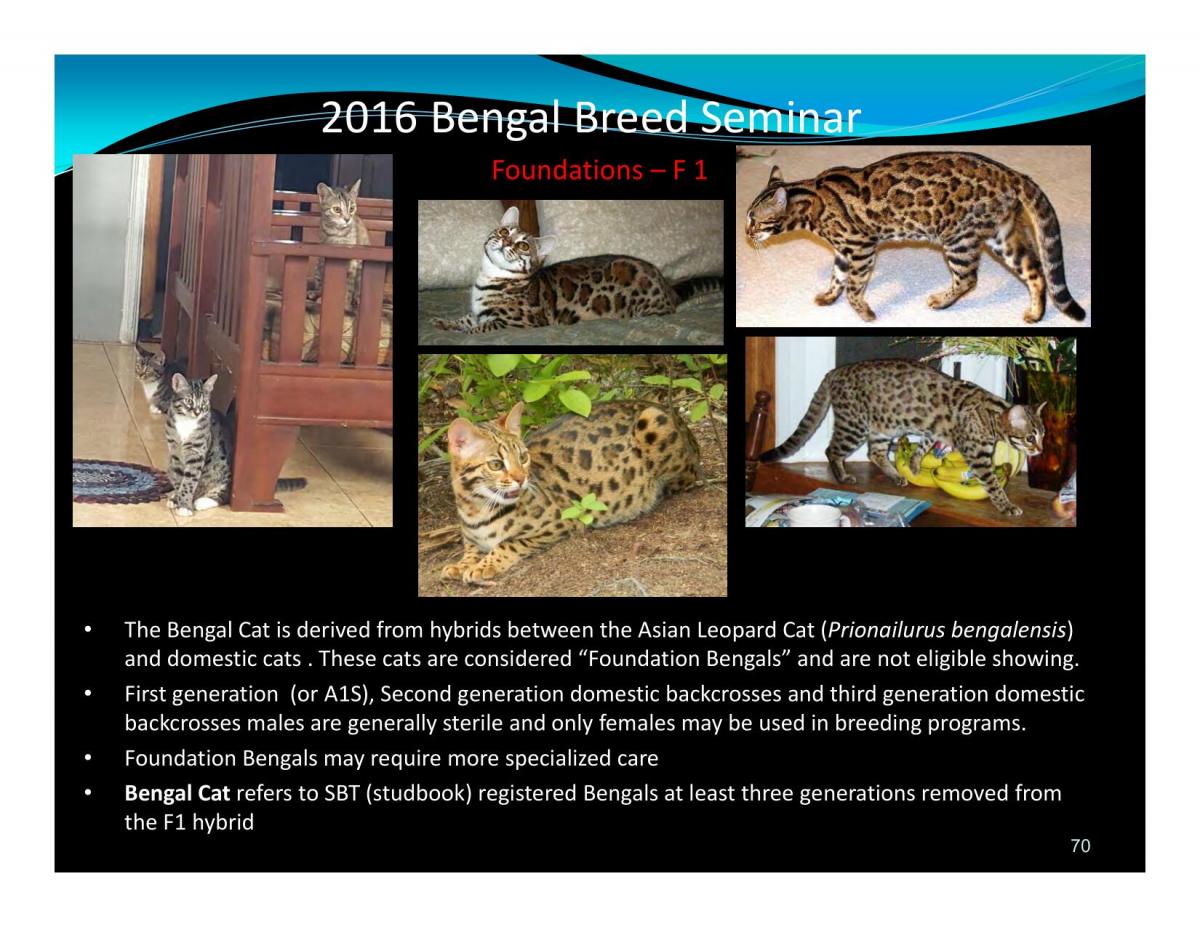
Bengal Breed Seminar Bengal Cat Breeding Strategy Paradigm
Use the terms second generation domestic backcross and third generation domestic backcross and NOT F2 & F3. In ALL FIELDS OF SCIENCE F2 generations are the result of F1 X F1 and F3 the result of F2 X F2. Incorrect terminology has caused scientific bodies and law enforcement agencies to disbelieve that Bengal Cats are domestic cats resulting in harmful policies and regulations
Bengal Heritage - The Asian Leopard Cat (Prionailurus bengalensis)
- Small wild cat species, from 5-15 lbs. living in Asia from the Amur region south to Indonesia, from Philippines west to Pakistan.
- Highly adaptable feline, living in tropical to temperate climates
- Noted and named for the striking, high contrast spotted coat of most subspecies that makes the cat resemble a smaller version of the Leopard (Panthera pardus)
- One subspecies is endangered though, this feline is among the most common of all Asian wild cats The Asian Leopard Cat is noted for being shy, easily frightened and retiring though it frequently lives near human settlements
Asian Leopard Cat (Prionailurus bengalensis) Variation
In 2016 all of these cats are considered the single species Asian Leopard Cats, Prionailurus bengalensis and represent distinct, often geographically distinctive subspecies. However, taxonomists (scientists specializing in classifying species), geneticists and zoologist continue to debate this fact. As recently as 2000 they were classified as four (4) distinctive species - The Asian Leopard Cat, Amur Leopard Cat, Tsushima Cat and Irimote Cat.
Recent genetic studies by Texas A & M has revealed:
•Southern Leopard Cat is more related and has had species introgression with Fishing Cats.
•Leopard Cats on the Indonesia Isles are more distinct genetically than other Leopard Cats
•The Tsushima, Irimote and Amur Leopard Cats are more closely related to one another than to other Asian Leopard Cats
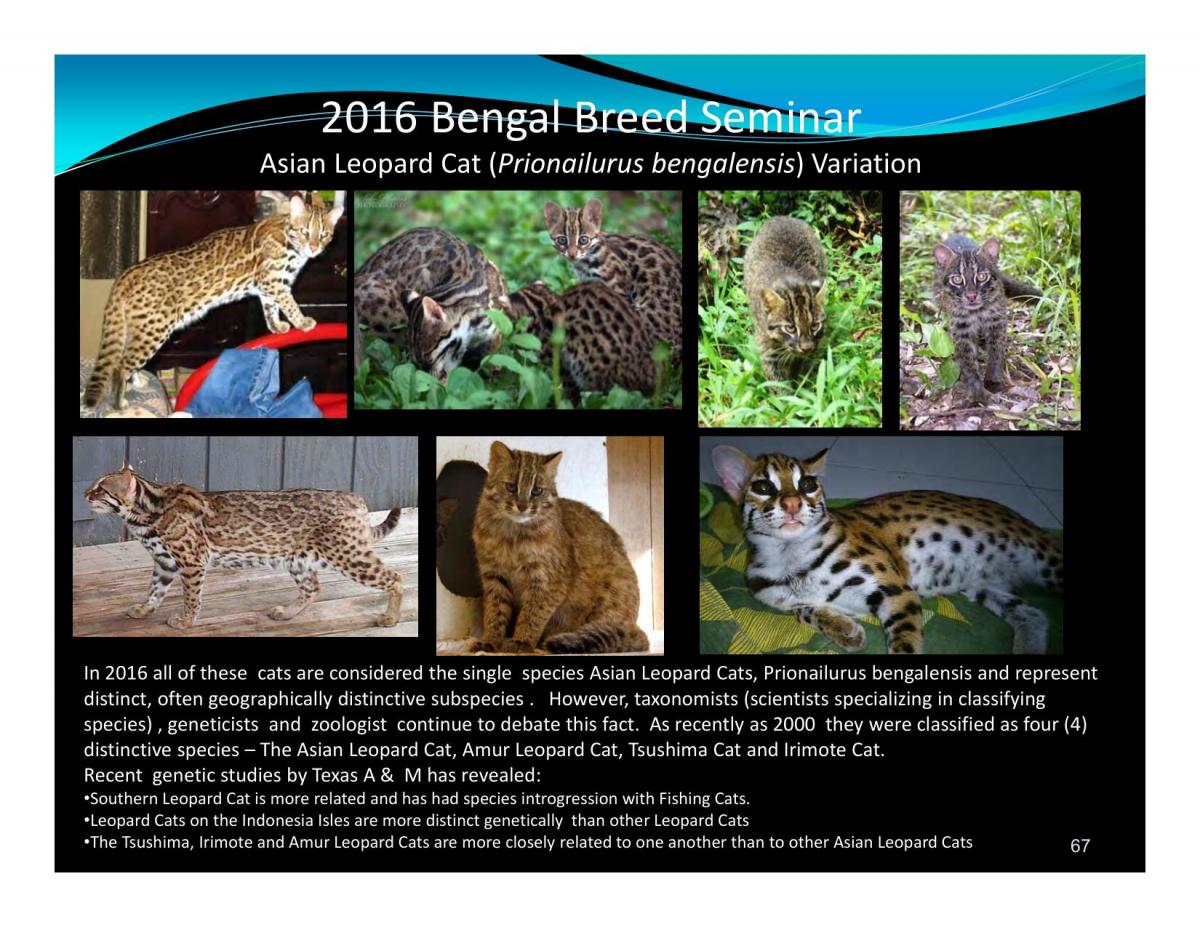
2016 Bengal Breed Seminar Handling & Temperament
Bengals revolutionized TICA by being the first breed to include the statement "Temperament must be unchallenging; any sign of definite challenge shall disqualify. The cat may exhibit fear, seek to flee, or generally complain aloud but may not threaten to harm", now included on all TICA standards. Bengal Cat breeders have demonstrated through painstaking selection that confident, relaxed and affectionate natures are inherited and may be increased or diminished through breeding choices.
Enthusiasts and Evaluators of Bengal Cats do justice by the Bengal Cat breed when timid, anxious and unaffectionate cats are removed from the breeding population and not rewarded with titles.
Handling a Bengal Cat requires no specialized training, instruction or demeanor than handling any domestic cat in a given situation. All cats respond to respectful caress, confident movement and minimal restraint.
Penalize
- Spots on body running together vertically forming a mackerel tabby pattern on spotted cats;
- Circular bulls - eye pattern on marbled cats;
Penalize and Withold All Awards
1. Substantially darker point color (as compared to color of body markings) in Seal Sepia, Seal Mink, or Seal Lynx Points cats.
2. Any distinct locket on the neck, chest, abdomen or any other area.
WITHHOLD ALL AWARDS: Belly Not Patterned
Allowances
1. Smaller size, in balanced proportion, of females.
2. Slightly longer coat in kittens.
3. Jowls in adult males.
4. Eyes slightly almond shaped.
Allowances
- Mousy undercoat.
- Paw pads not consistent with color group description
- Asian Leopard Cat
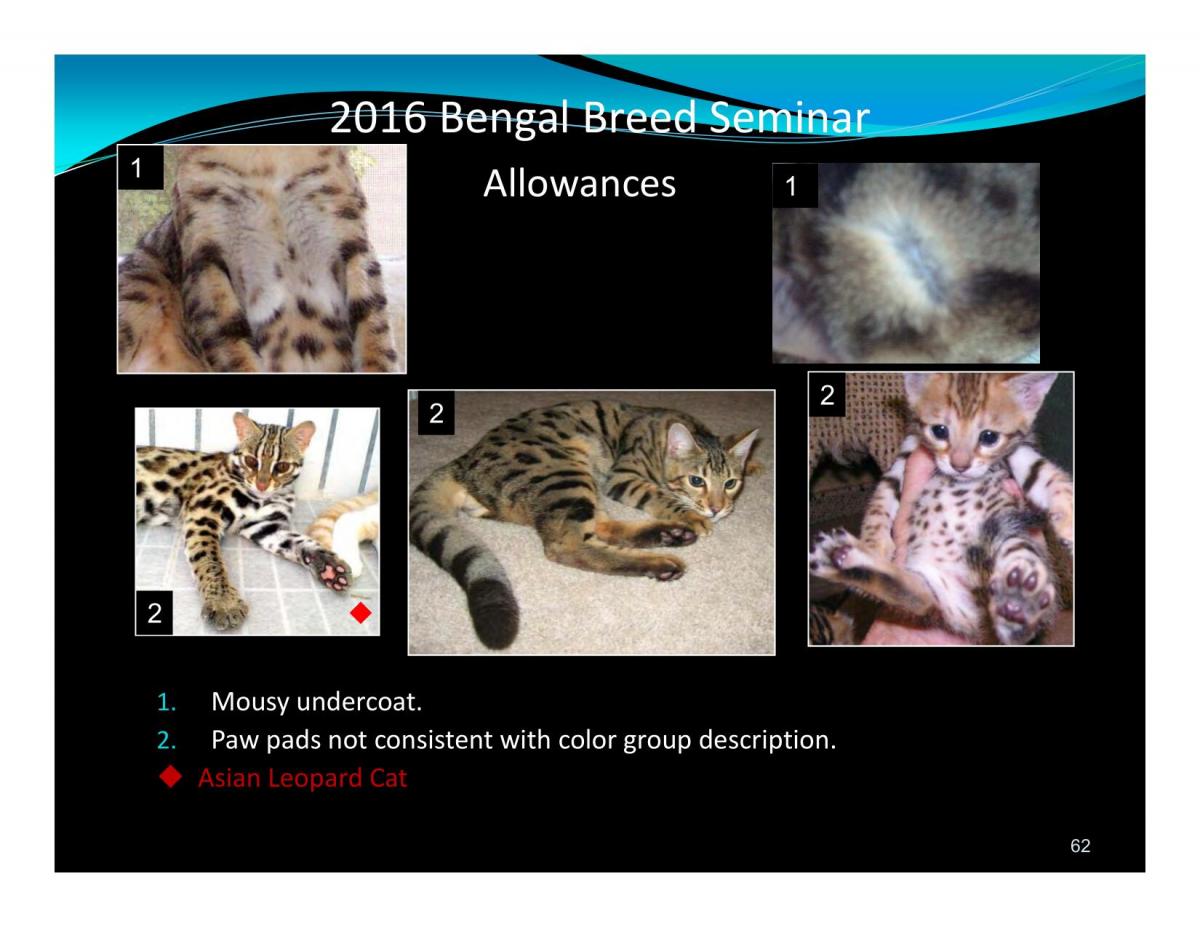
Pattern (Spotted)....................15
Spots shall be random, or aligned horizontally.
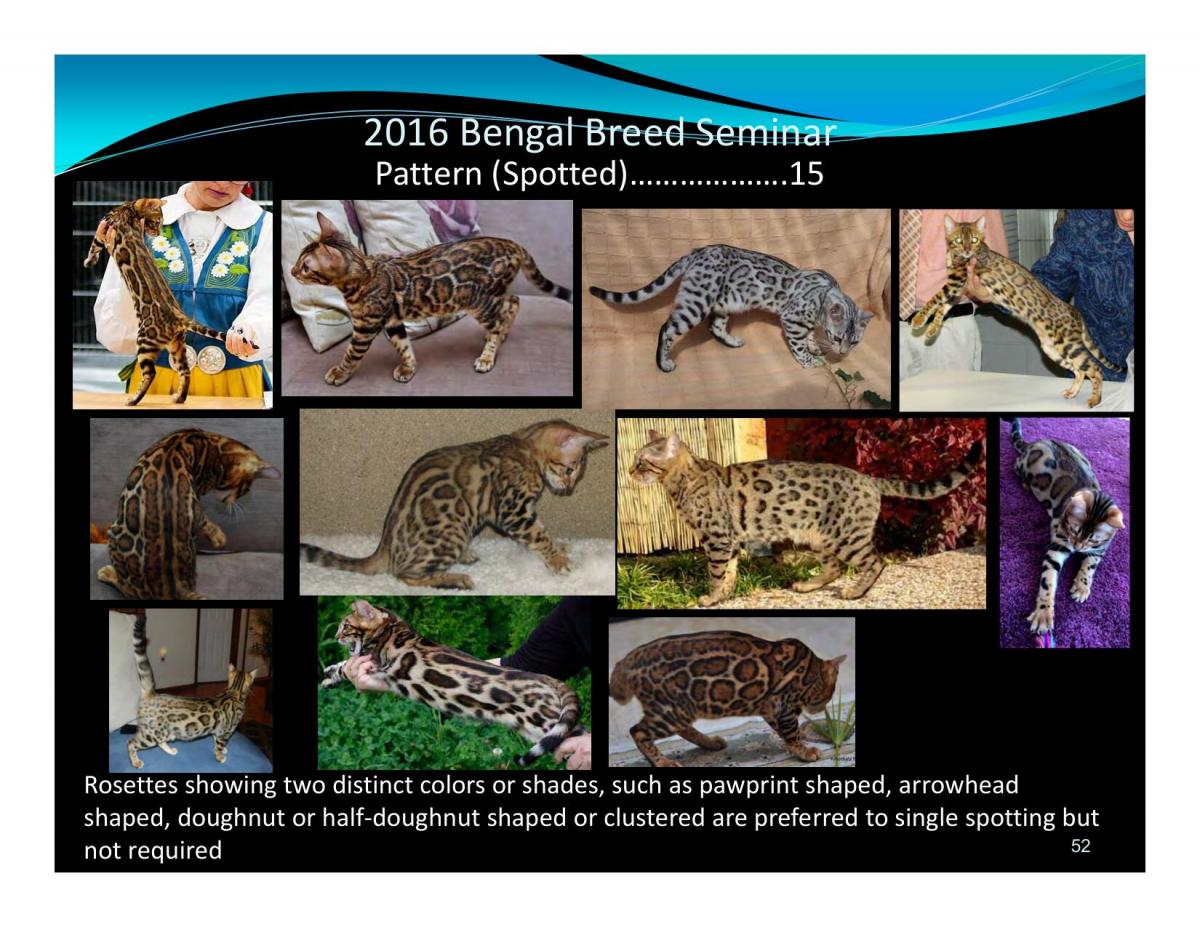
Bengal Breed Seminar Pattern (Spotted).................................................15
Rosettes showing two distinct colors or shades, such as pawprint shaped, arrowhead shaped, doughnut or half-doughnut shaped or clustered are preferred to single spotting but
not required
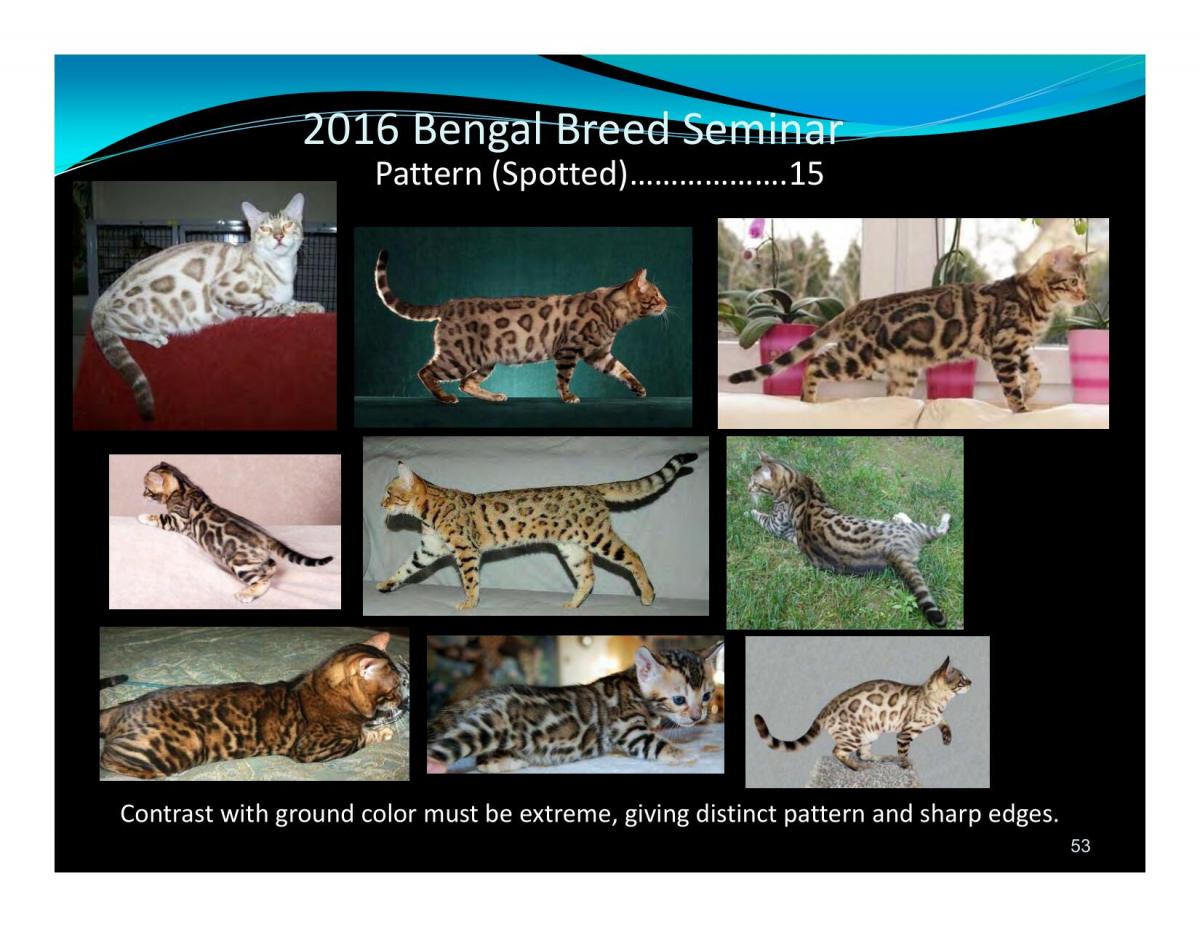
2016 Bengal Breed Seminar Pattern (Spotted)...............15
Contrast with ground color must be extreme, giving distinct pattern and sharp edges.
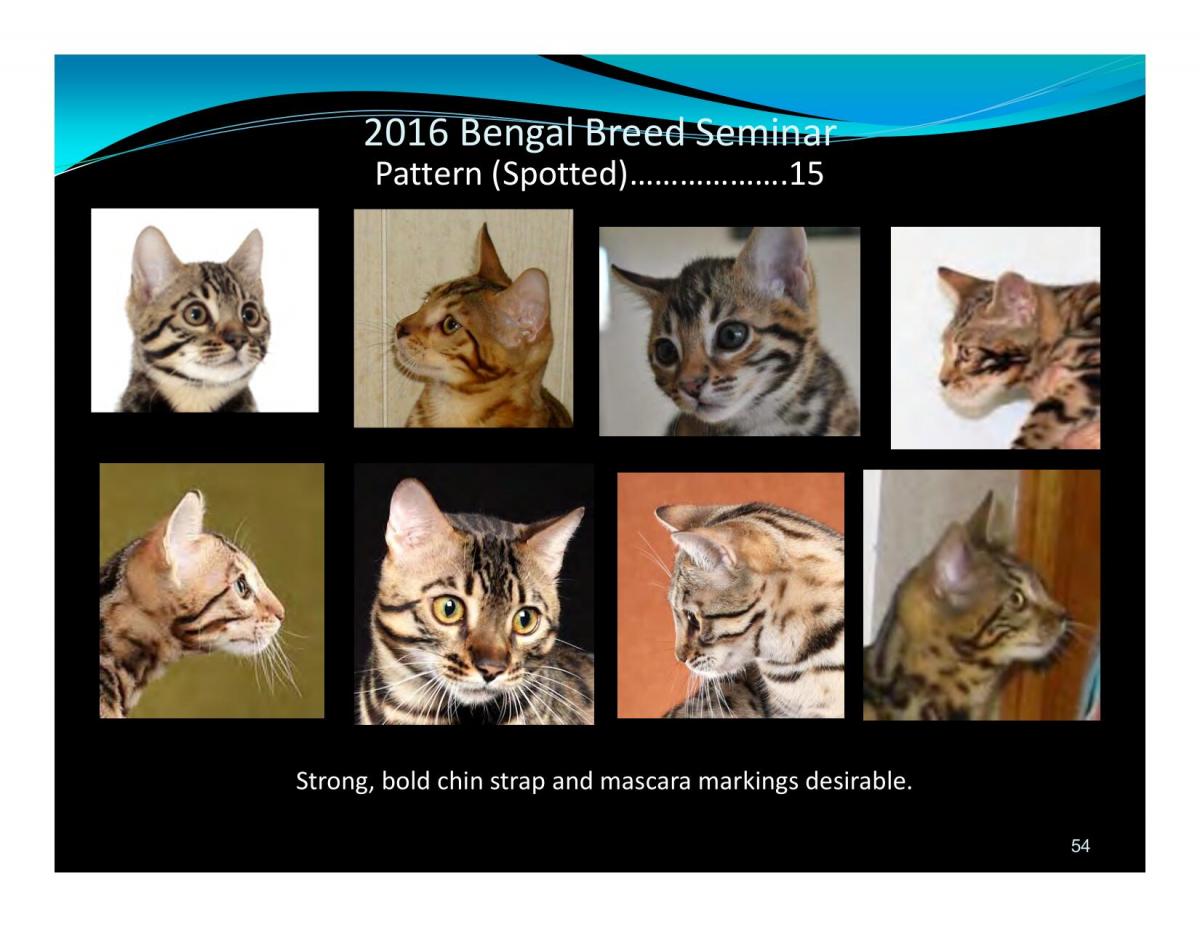
2016 Bengal Breed Seminar Pattern (Spotted)......................................................15
Strong, bold chin strap and mascara markings desirable.
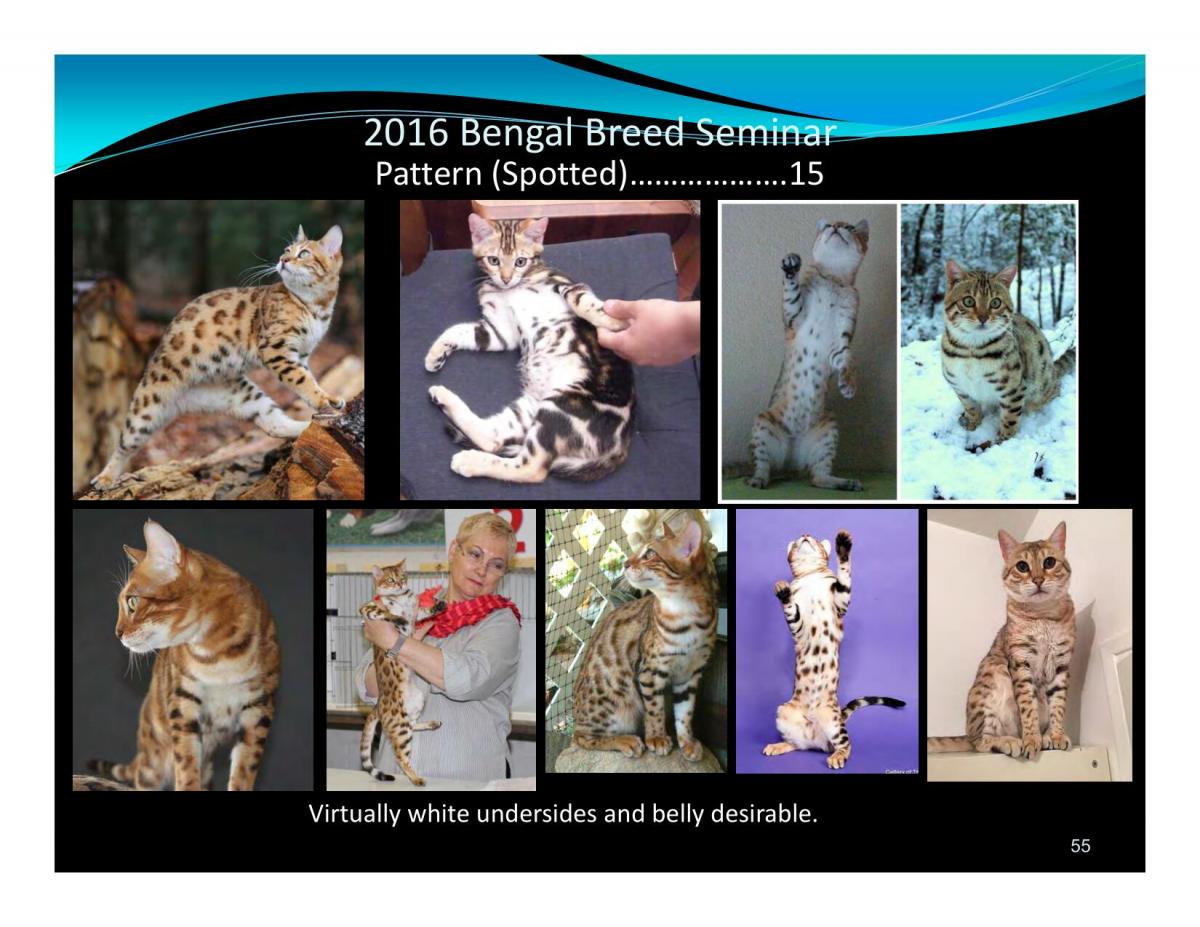
2016 Bengal Breed Seminar Pattern (Spotted)...................................15
Virtually white undersides and belly desirable.
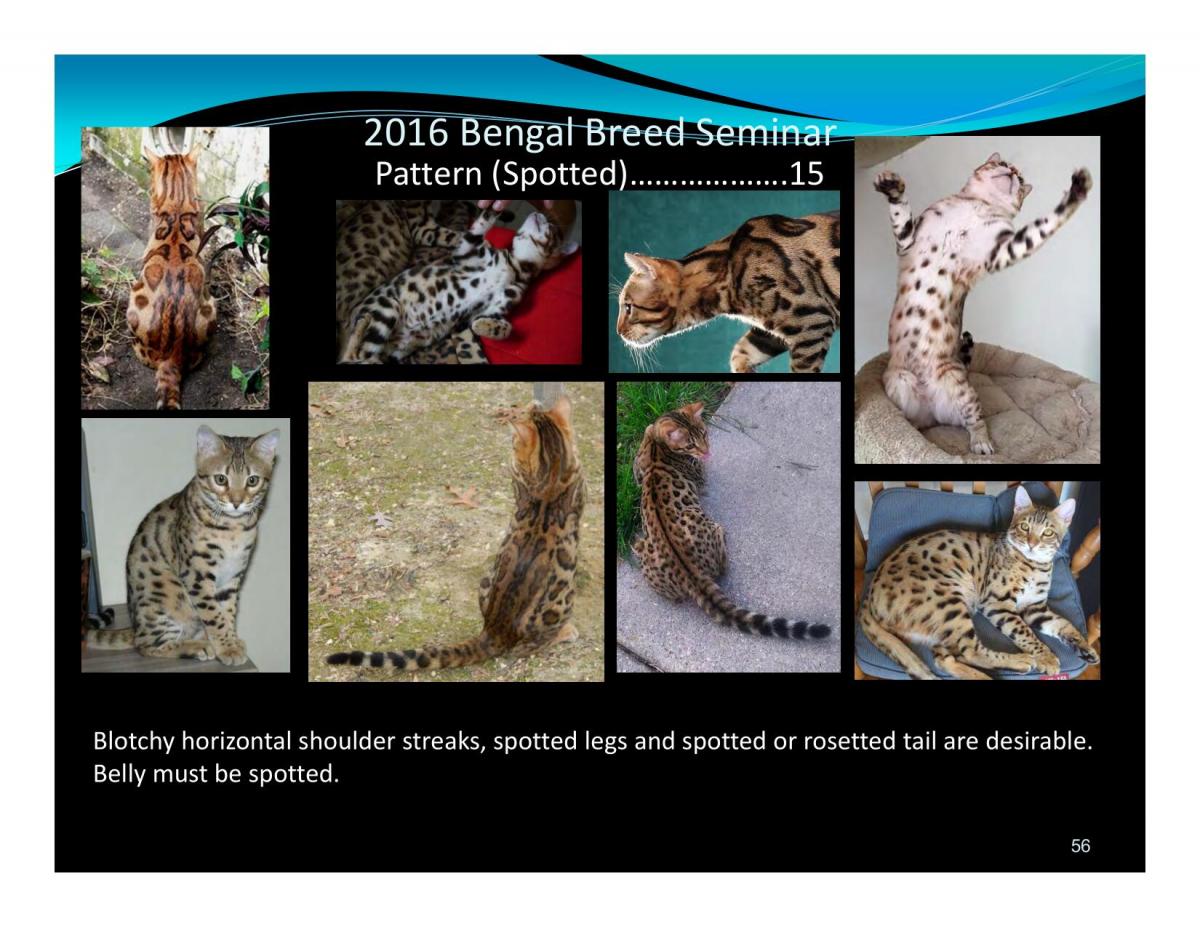
2016 Bengal Breed Seminar Pattern (Spotted)..........................................15
Blotchy horizontal shoulder streaks, spotted legs and spotted or rosetted tail are desirable.
Belly must be spotted.
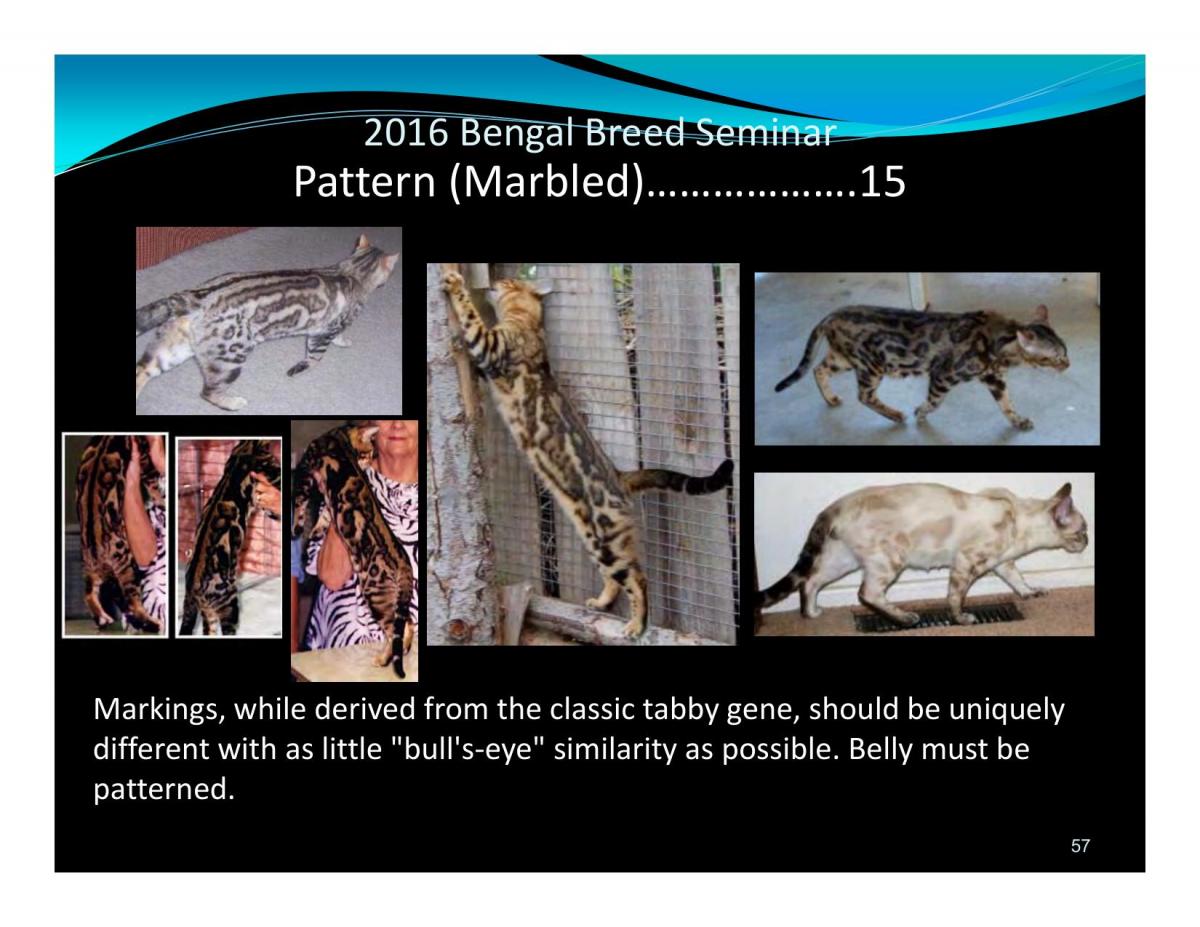
2016 Bengal Breed Seminar Pattern (Marbled)...................15
Markings, while derived from the classic tabby gene, should be uniquely different with as little "bull's-eye" similarity as possible. Belly must be patterned.
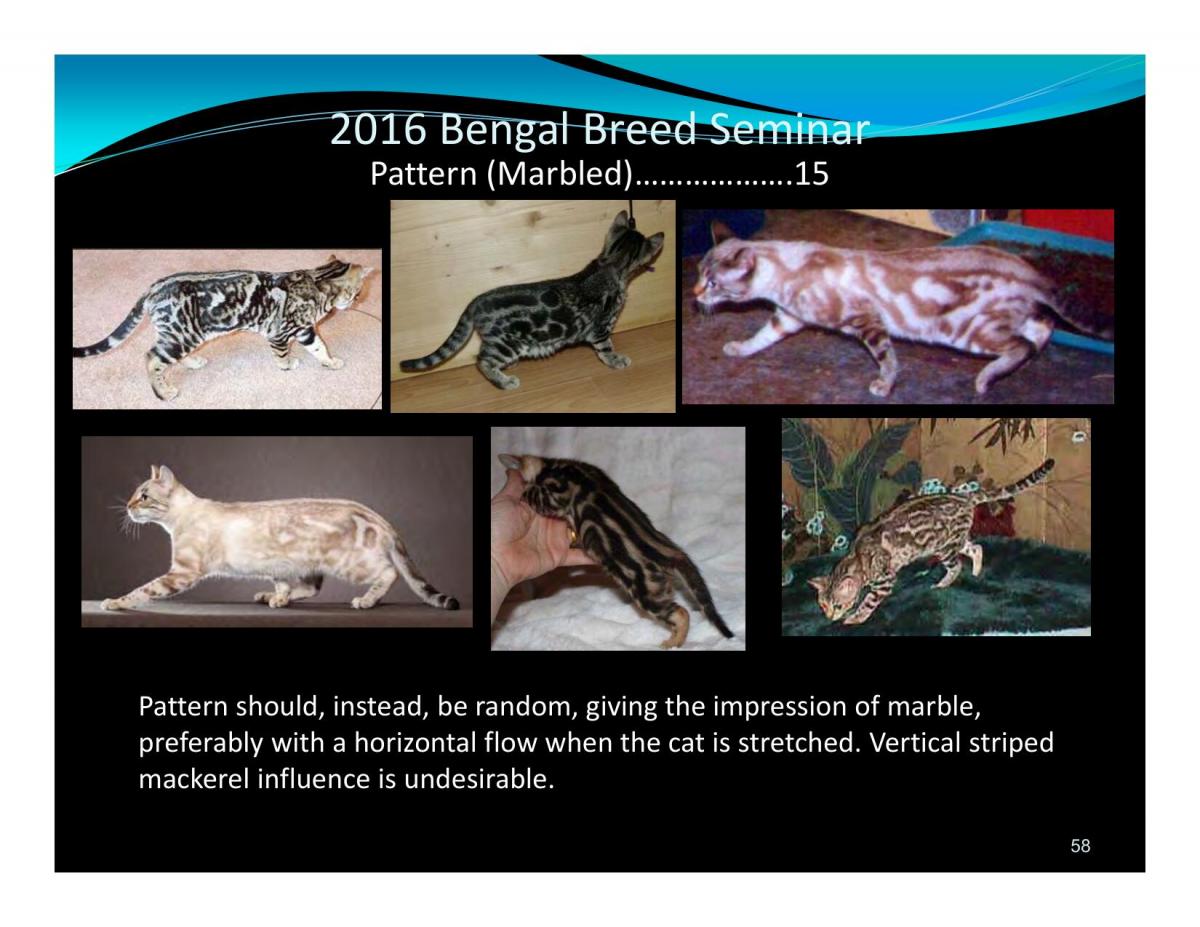
Pattern (Marbled).............................................15
Pattern should, instead, be random, giving the impression of marble, preferably with a horizontal flow when the cat is stretched. Vertical striped mackerel influence is undesirable.
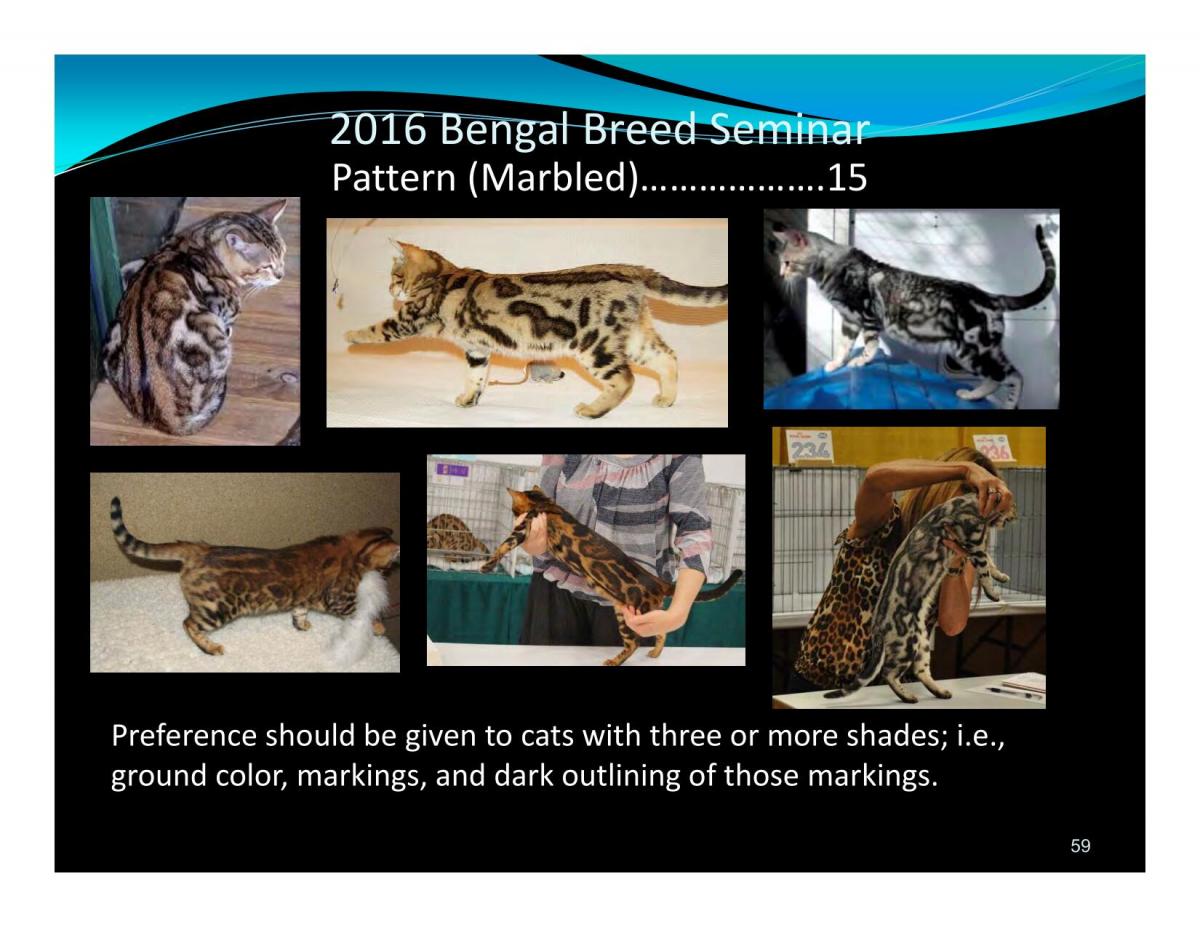
(Marbled)....15
Preference should be given to cats with three or more shades; i.e., ground color, markings, and dark outlining of those markings.
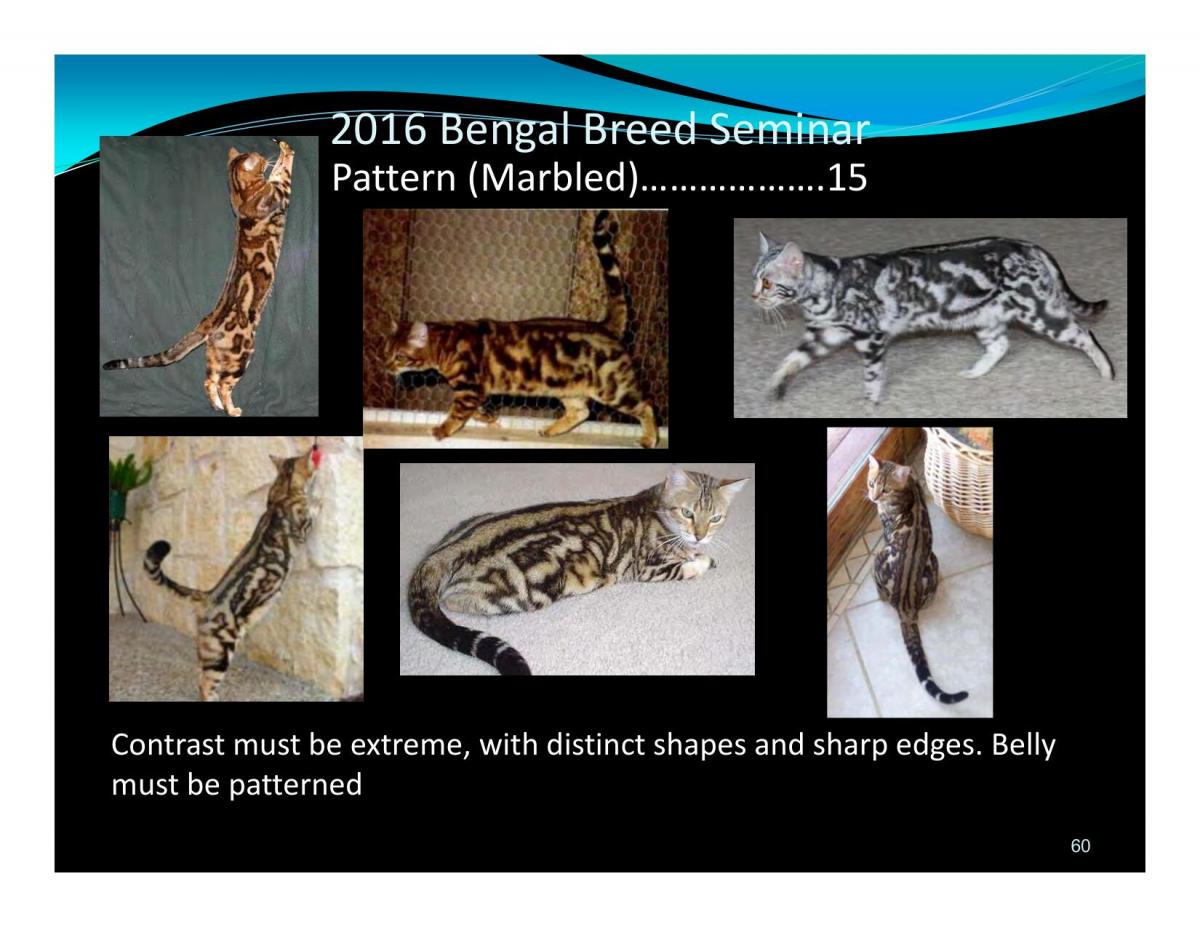
Pattern Marble .............. 15
Contras must be extreme, with distinct shapes and sharp edges. Belly must be patterned.
Coat/Color/Pattern
10 points Brown Tabby
All variations of brown are allowed. Markings various shades of brown to black. Light spectacles encircling the eyes and a virtually white ground color on the whisker pads, chin, chest, belly and inner legs is desirable
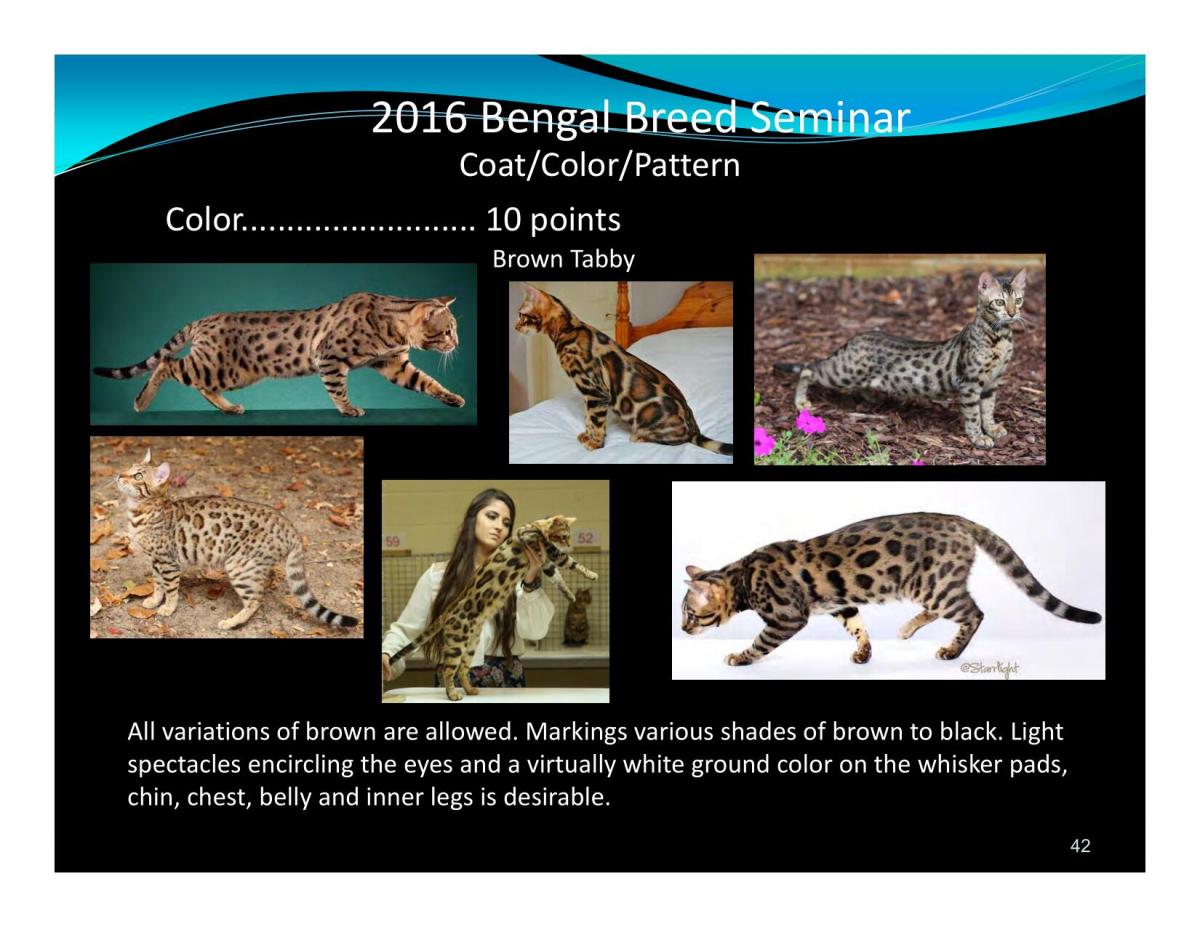
Coat/Color/Pattern
10 points Brown Tabby
All variations of brown are allowed. Markings various shades of brown to black. Light spectacles encircling the eyes and a virtually white ground color on the whisker pads, chin, chest, belly and inner legs is desirable.
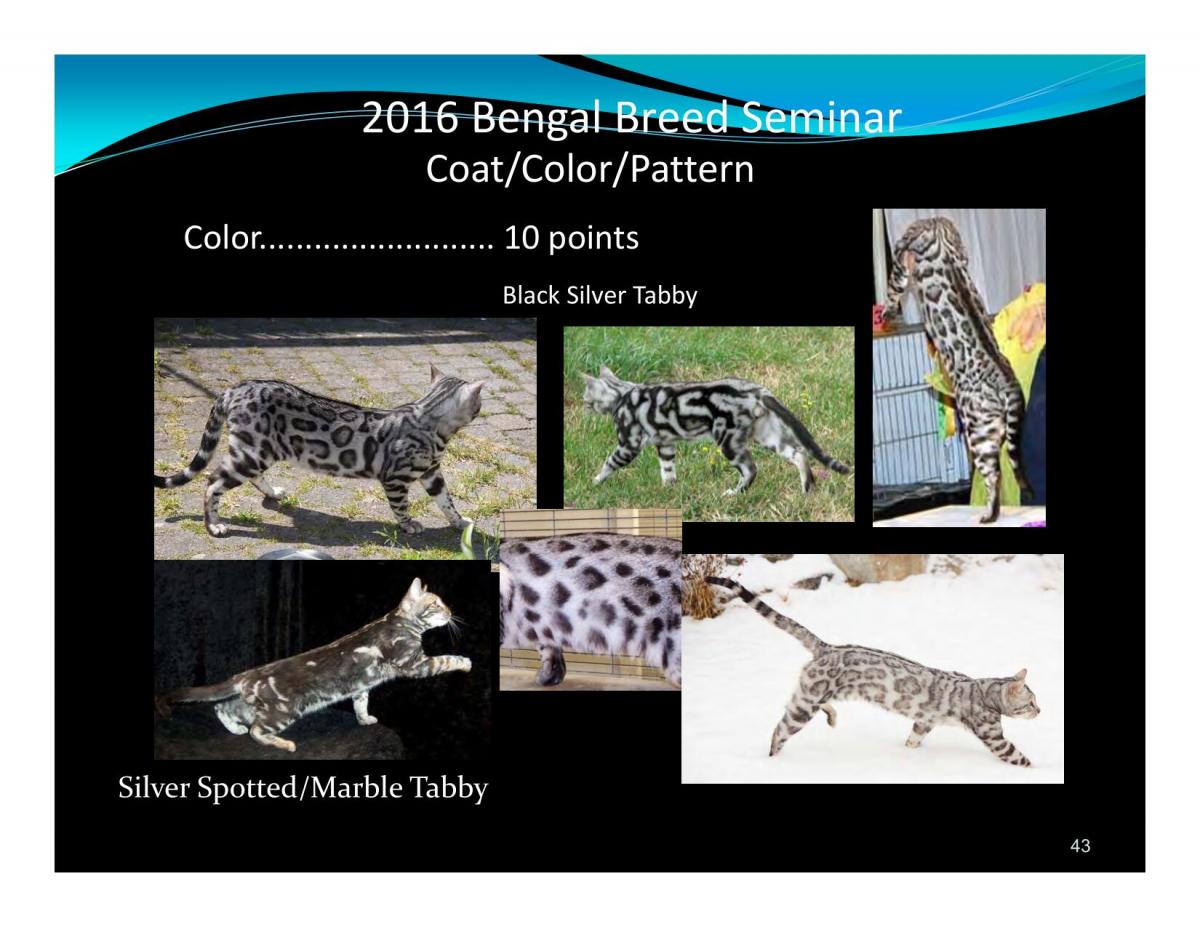
Coat/Color/Pattern
Color ... 10 points
Black Silver Tabby
Silver Spotted/Marble Tabby
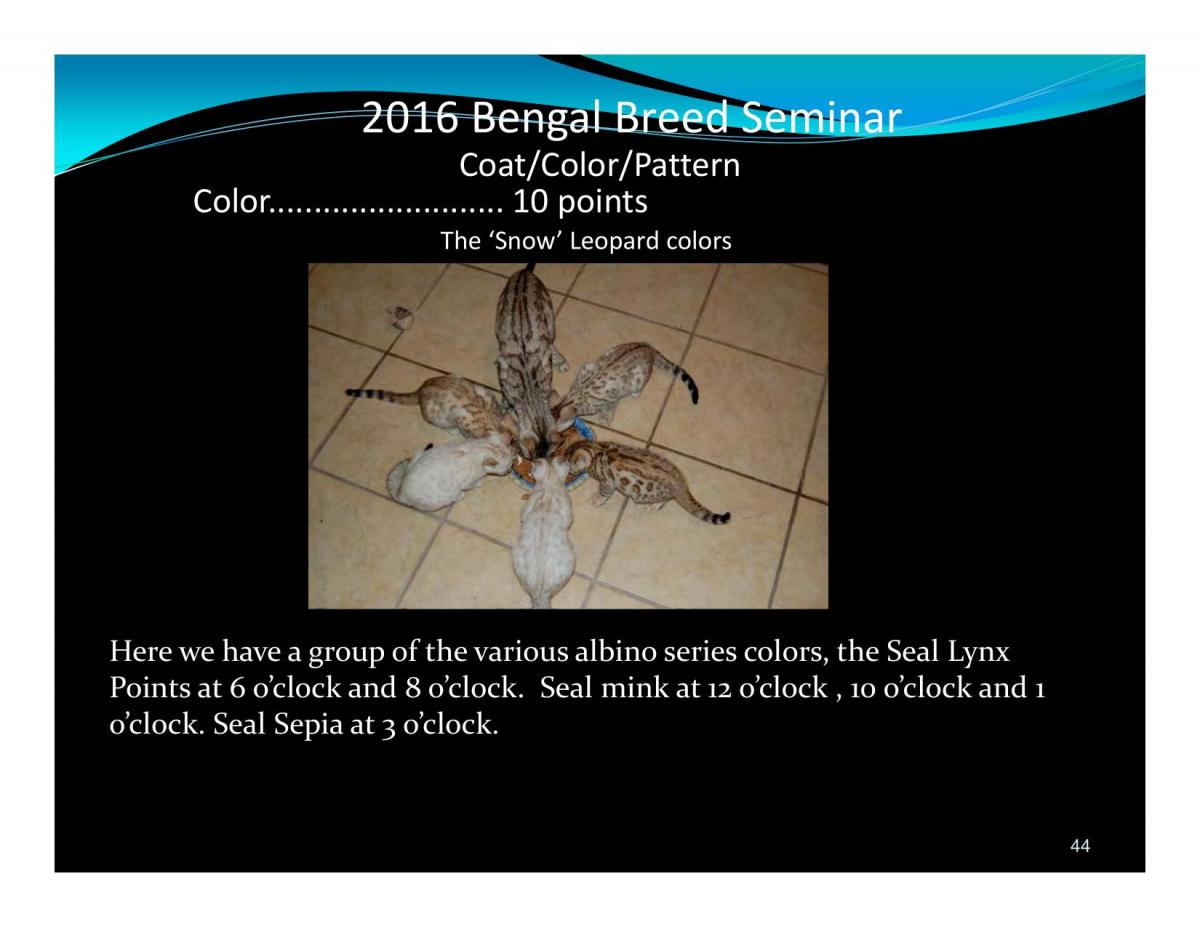
Coat/Color/Pattern
Color ... 10 points
The Snow Leopard Colors
Here we have a group of the various albino series colors, the Seal Lynx Points at 6 o clock and 8 o' clock. Seal mink at 12 o' clock, 10 o' clock and 1 o' clock. Seal Sepia at 3 o' clock
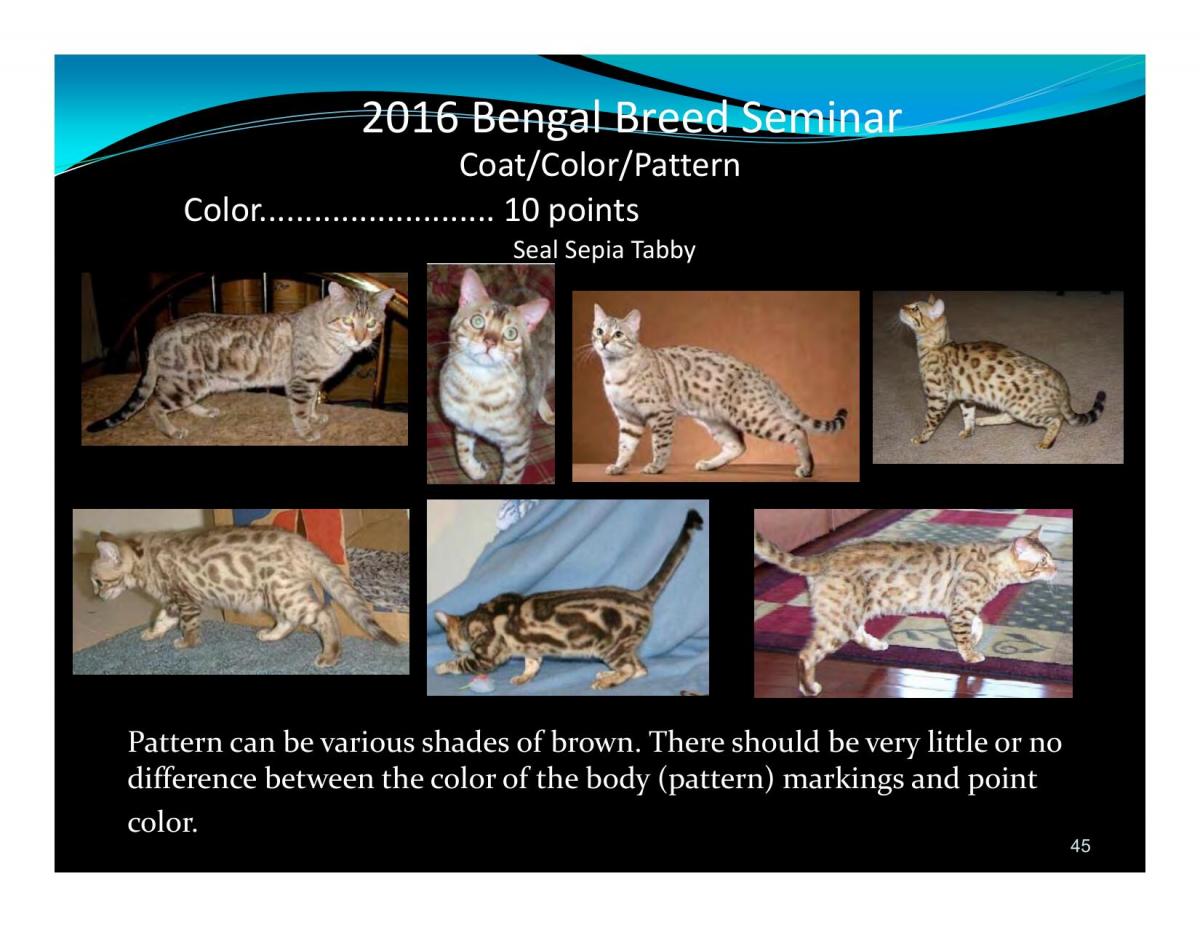
Coat/Color/ Pattern
Color .... 10 points
Seal Sepia Tabby
Pattern can be various shades of brown. There should be very little or no difference between the color of the body (pattern) markings and point color.
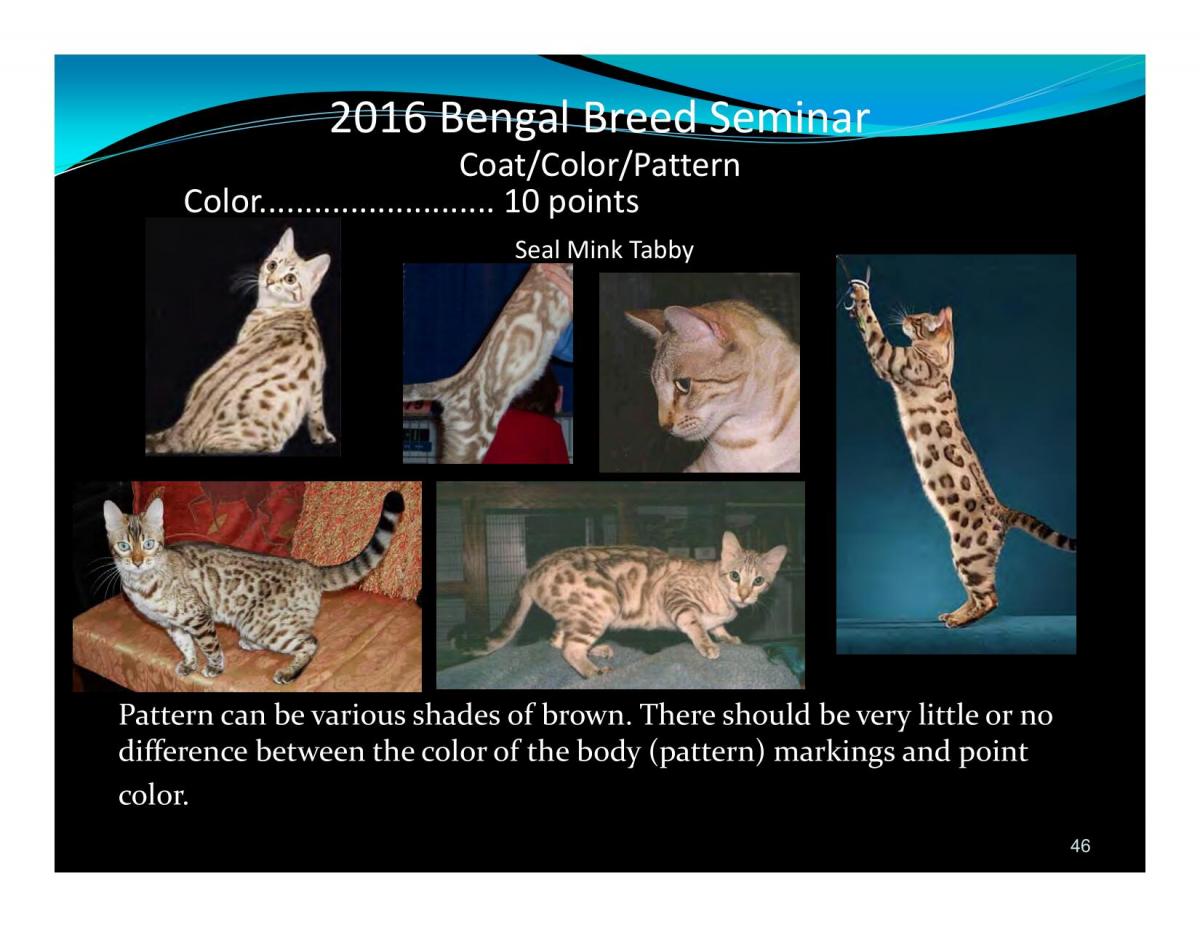
Coat/Color/Pattern
Color ... 10 points
Seal Mink Tabby
Pattern can be various shades of brown. There should be very little or no difference between the color of the body (pattern) markings and point color.
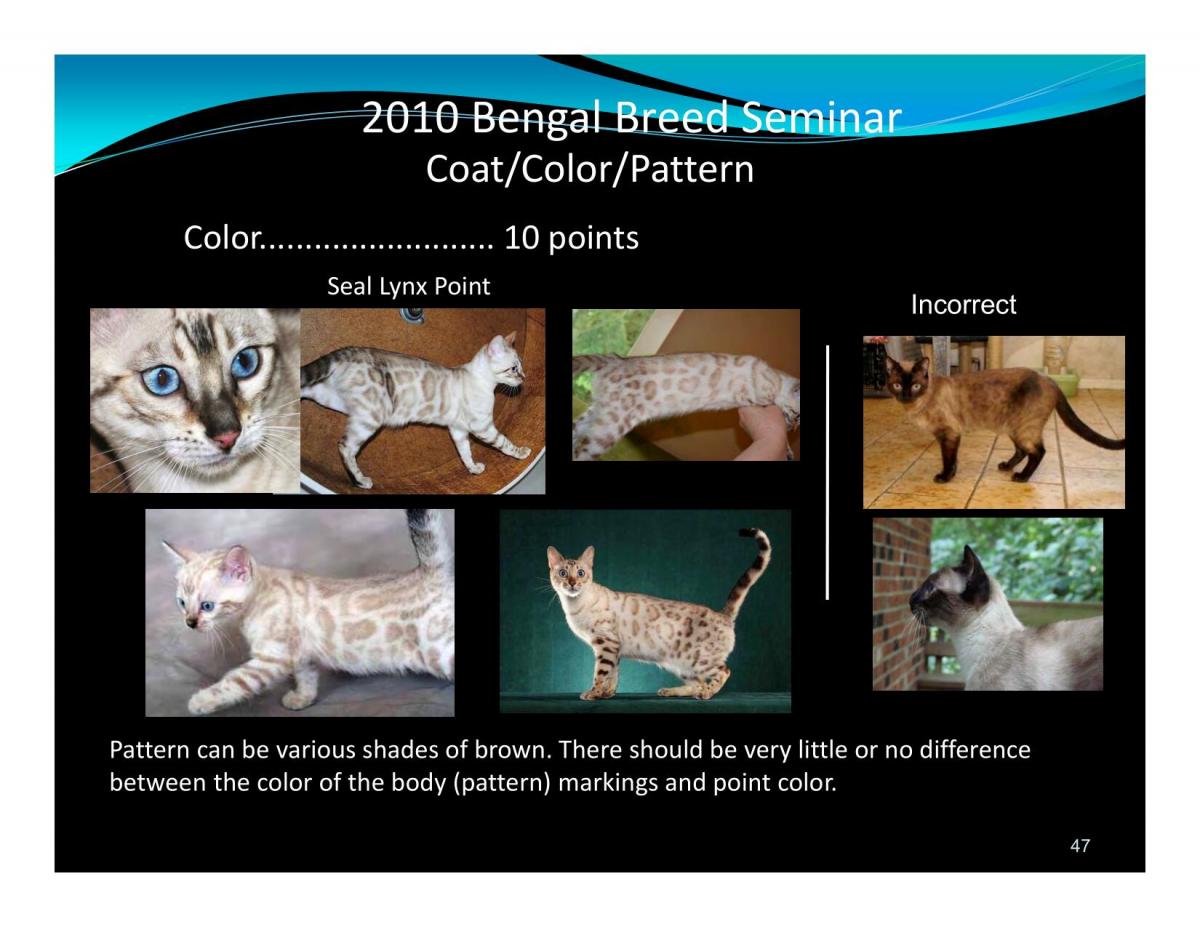
Coat/Color/Pattern
Color ... 10 points
Seal Lynx Point
Pattern can be various shades of brown. There should be very little or no difference between the color of the body (pattern) markings and point color.
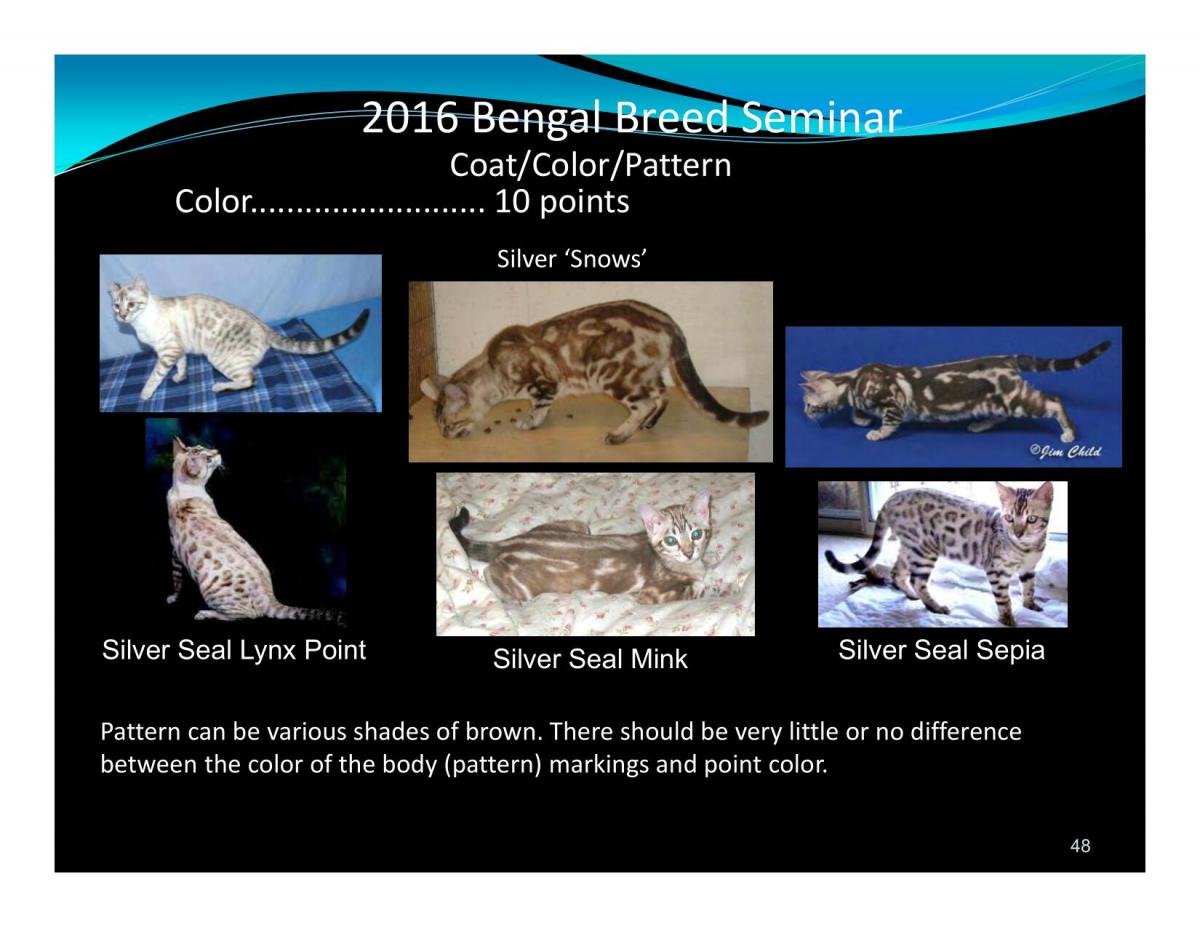
Coat/Color/Pattern
Color ... 10 points
Silver Snow
Pattern can be various shades of brown. There should be very little or no difference between the color of the body (pattern) markings and point color.
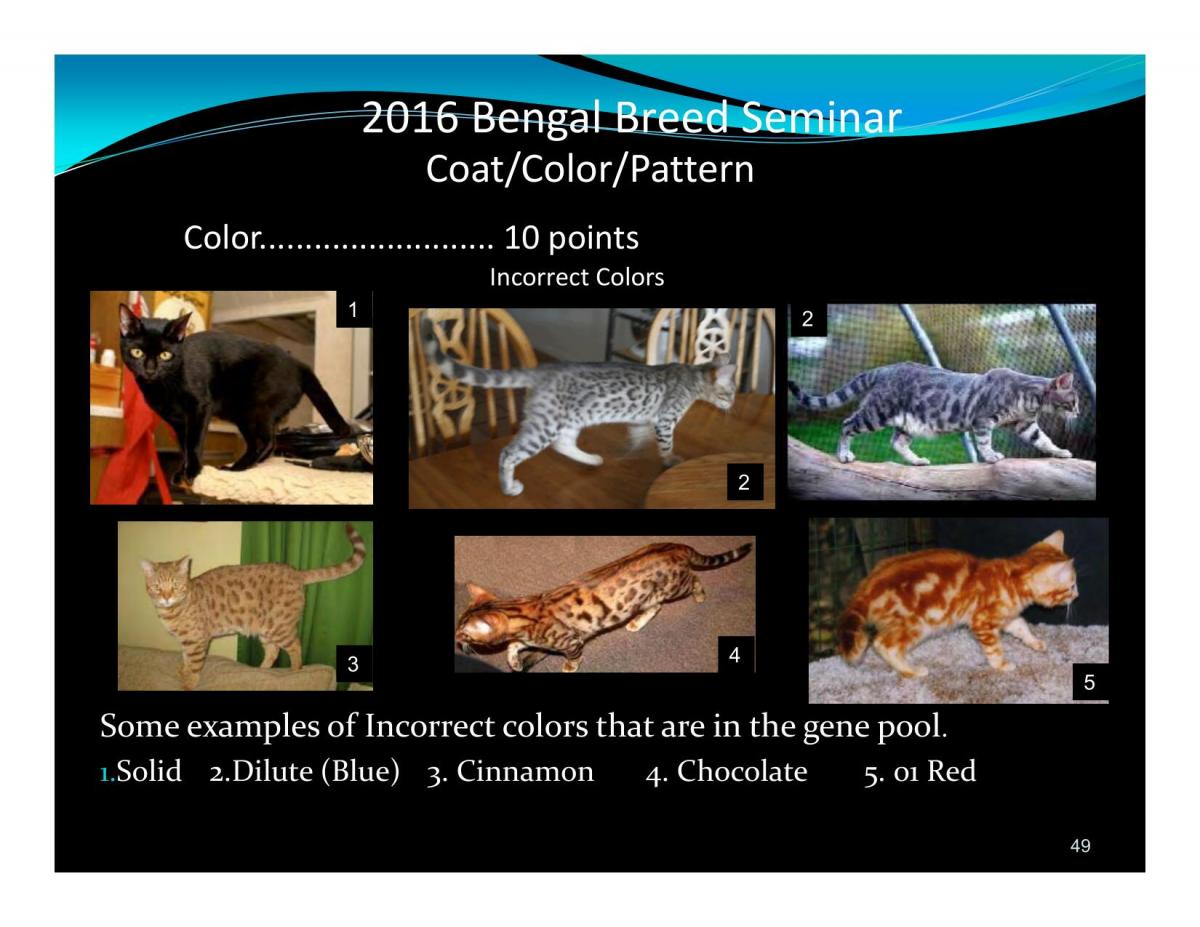
Coat/Color/Pattern
Color ... 10 points
Some examples of incorrect colors that are in the gene pool
1. Solid 2. Dilute (Blue) 3. Cinnamon 4. Chocolate 5. 01 Red
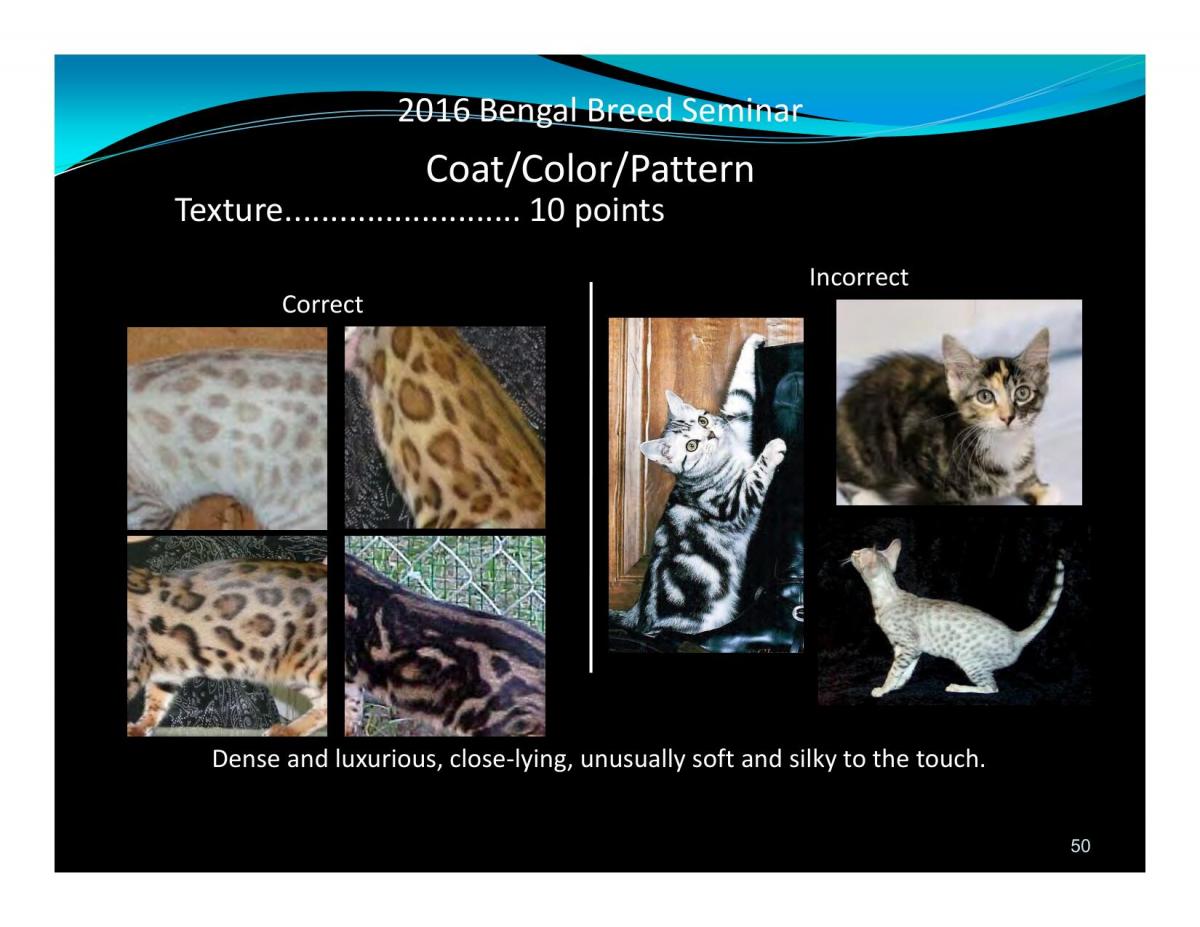
Coat/Color/Pattern
Texture... 10 points
Dense and luxurious, close lying, unusually soft and silky to be touch.
Body...30 points
Torso ..... 5
Legs........4
Feet........4
Tail........5
Boning......6
Musculature 6
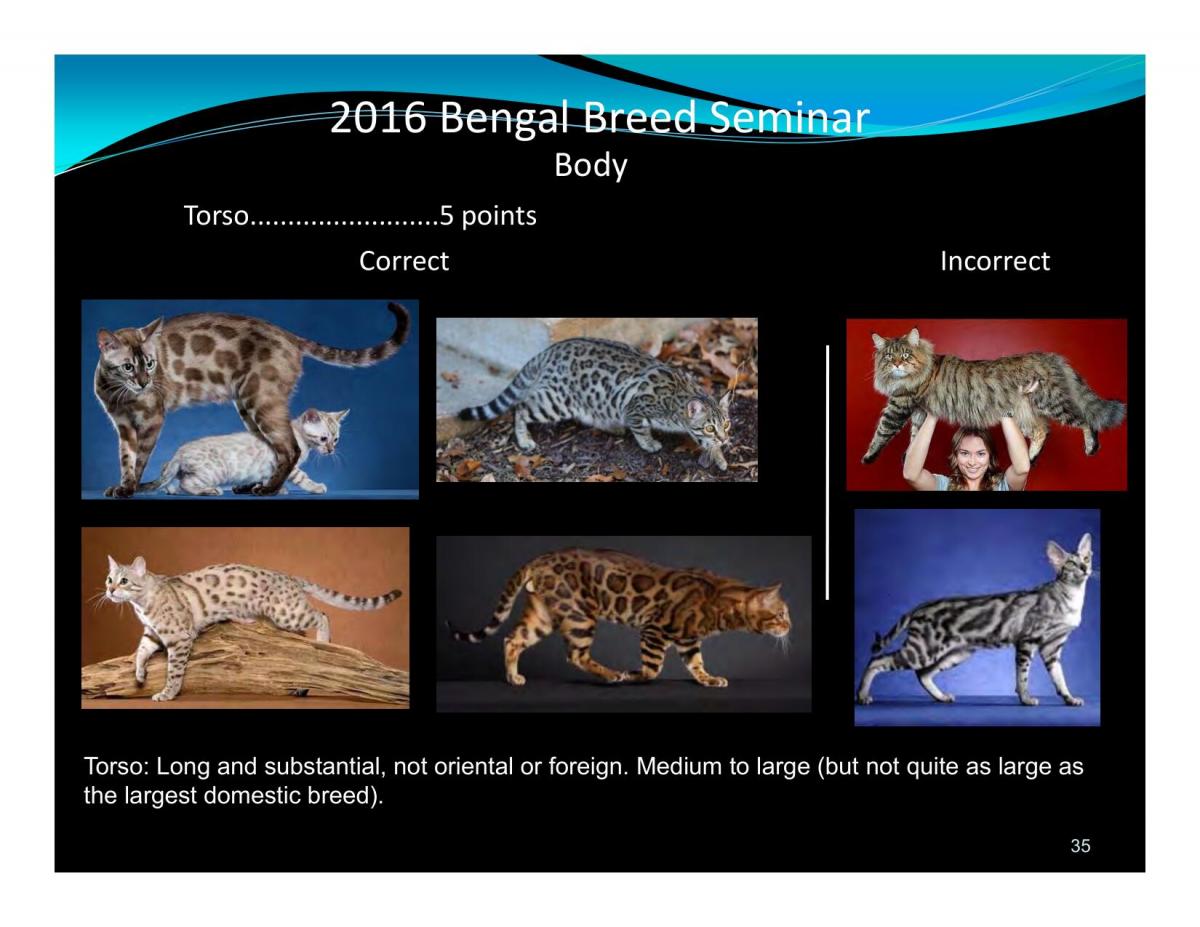
Body
Torso ..... 5 points
Torso: Long and substantial, not oriental or foreign. Medium to large (but not quite as large as the largest domestic breed).
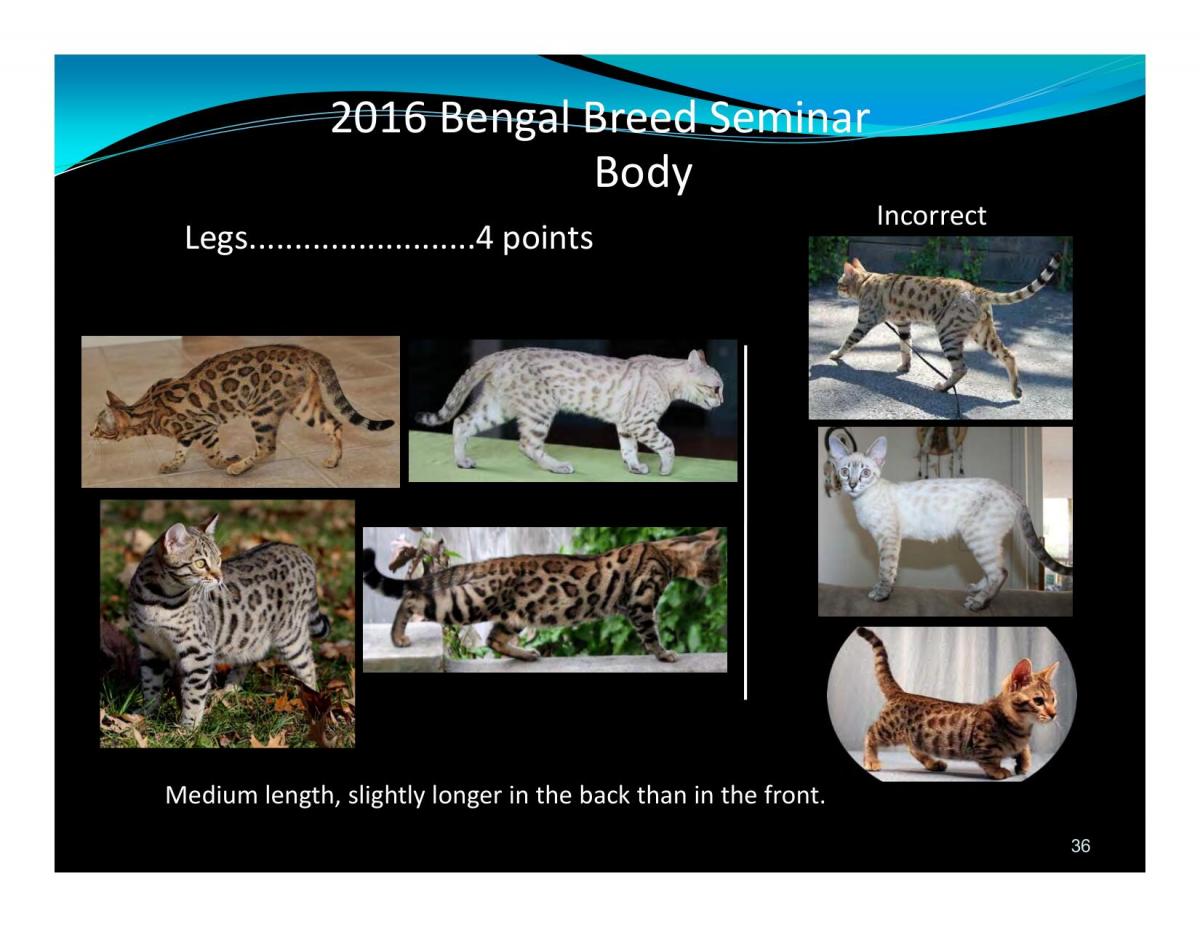
Body
Leg ... 4 points
Medium length, slightly longer in the back than in the front.
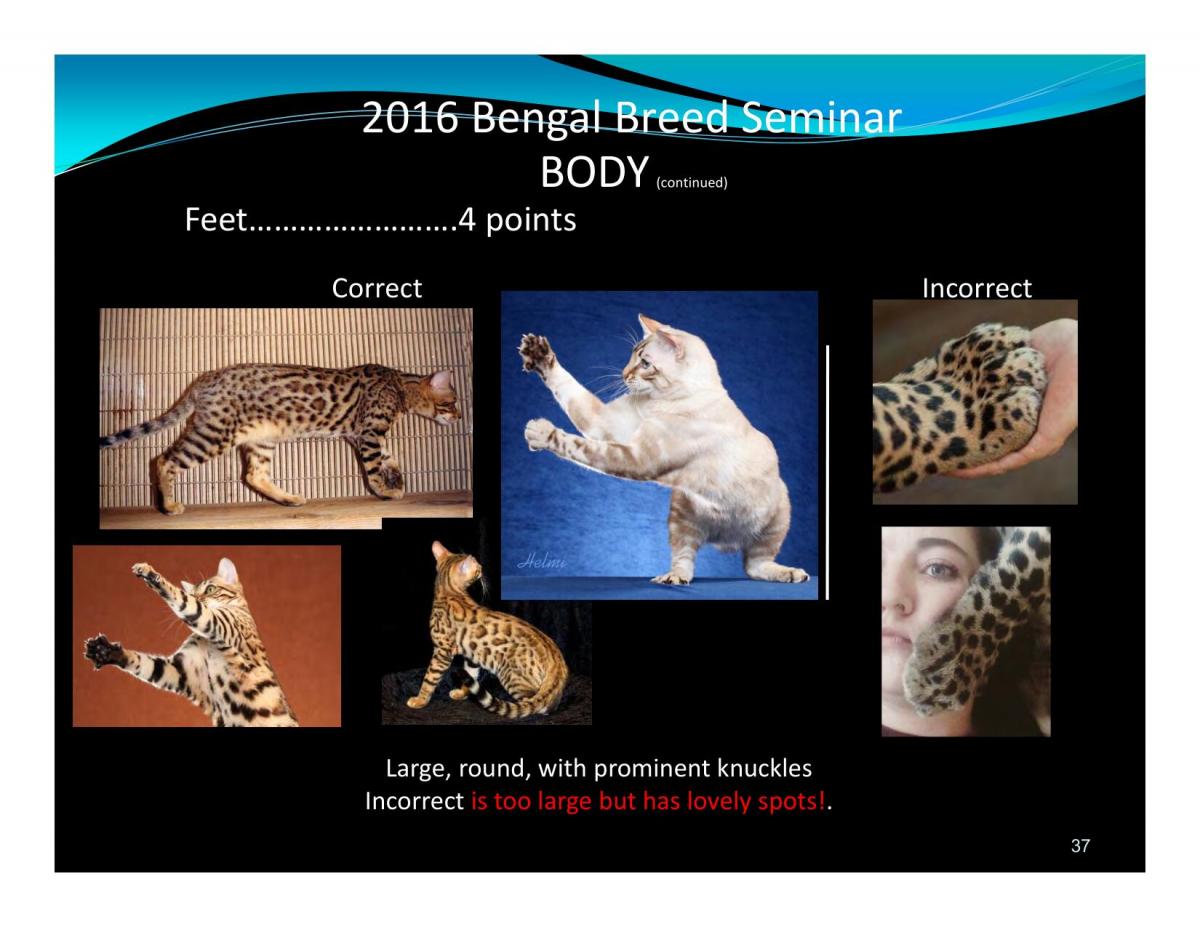
Body (continued)
Feet ... 4 points
Large, round, with prominent knuckles
Incorrect is too large but has lovely spots!
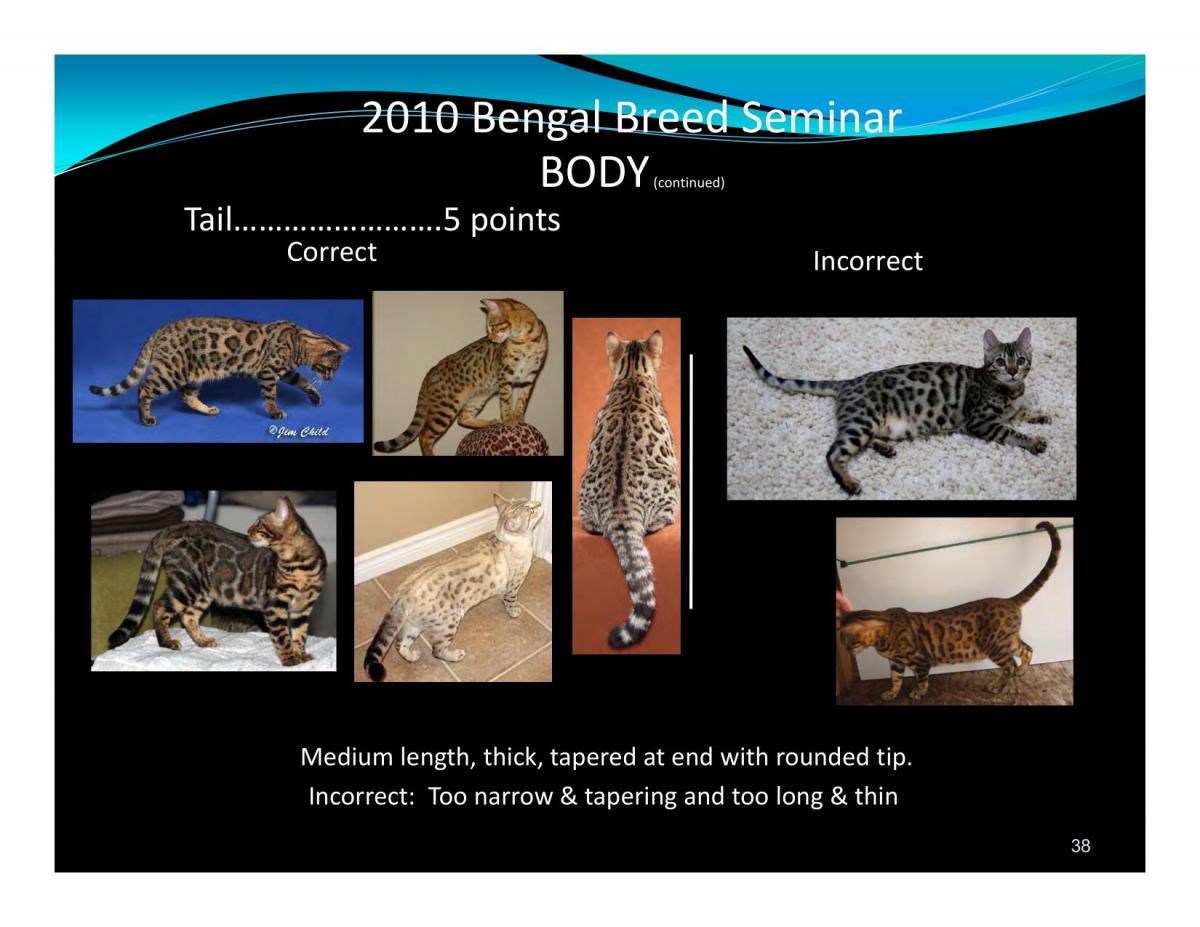
Body
Tail ..... 5 points
Medium length, thick, tapered at end with rounded tip.
Incorrect: Too narrow & tapering and too long & thin
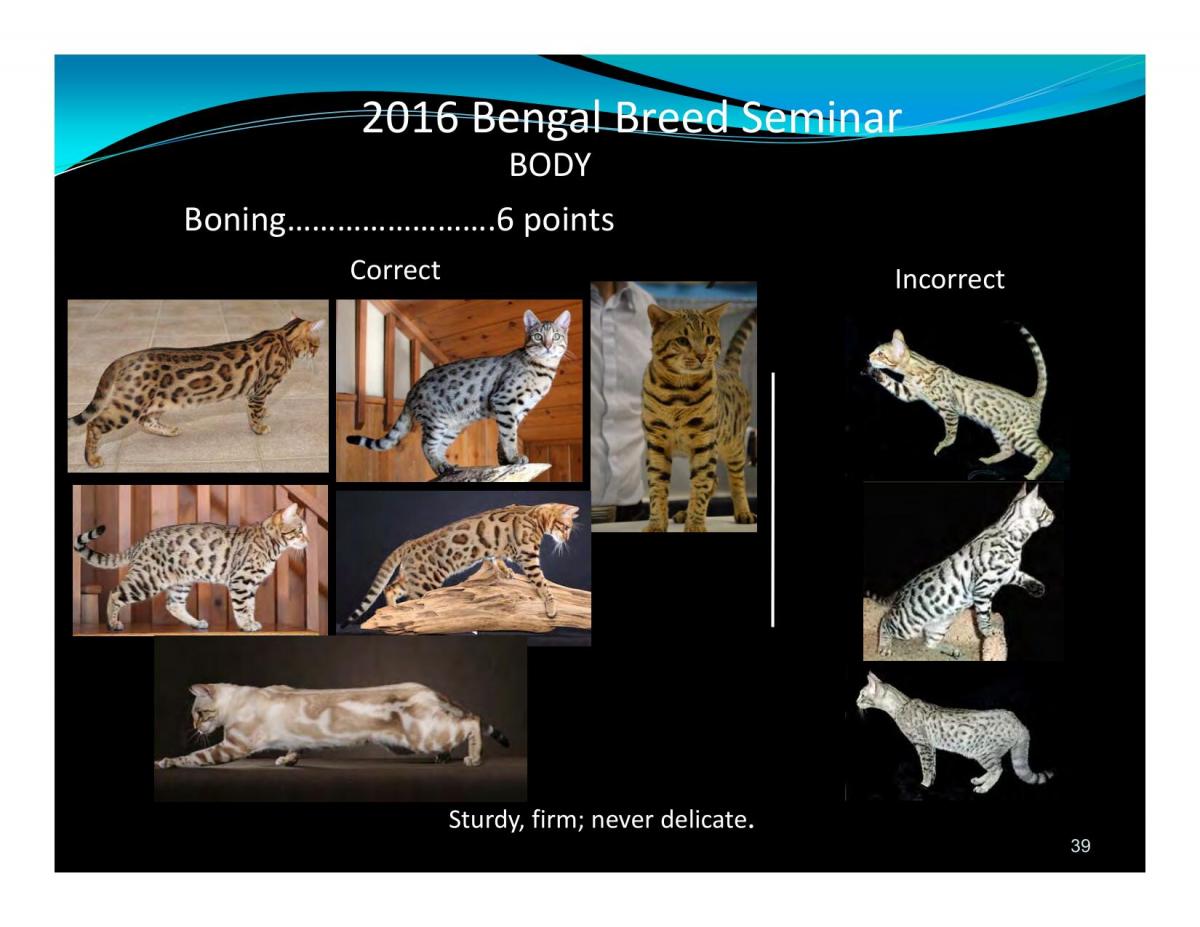
Boning .... 6 points
Sturdy, firm; never delicate.
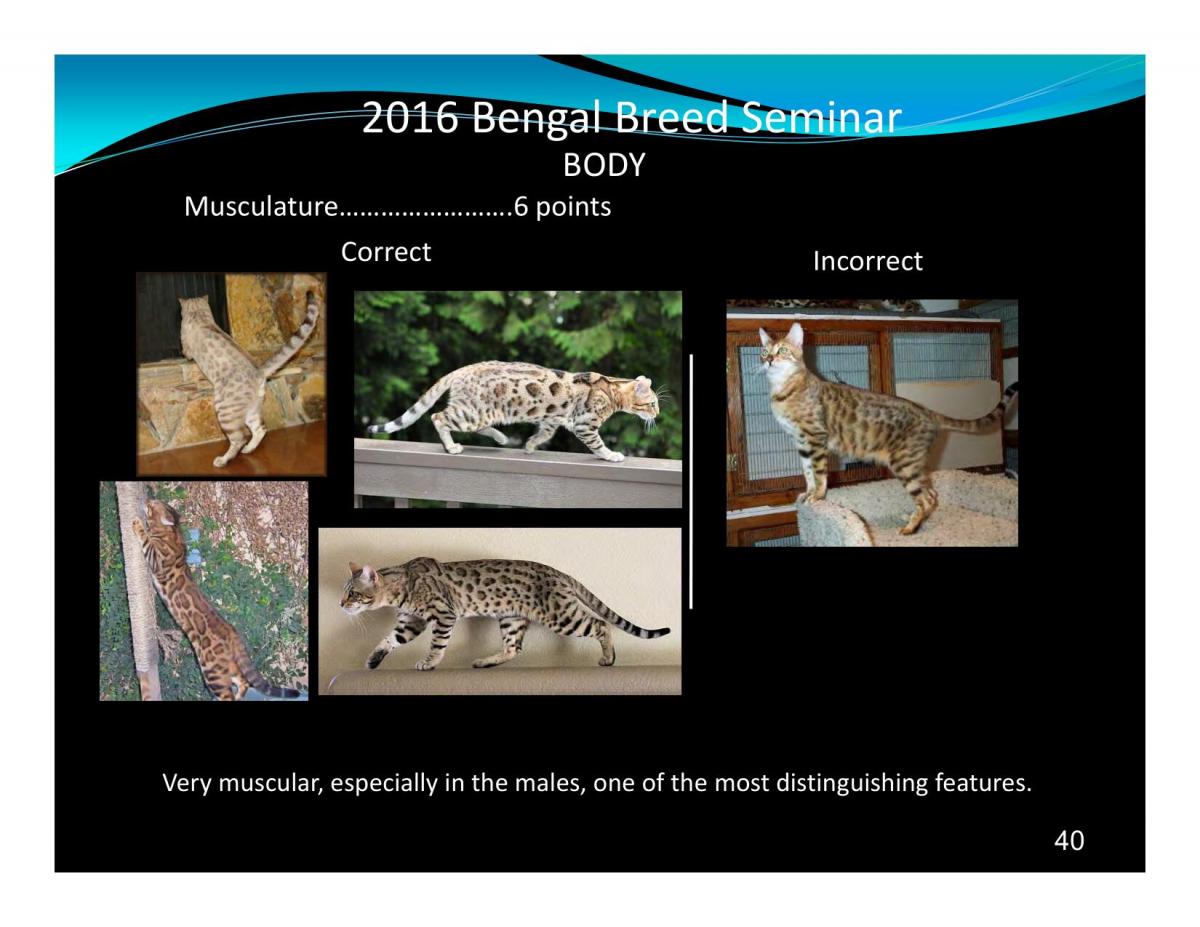
Musculature ..... 6 points
Very muscular, especially in the males, one of the most distinguishing features.
HEAD
HEAD..................35
Shape.................6
Ears..................6
Eye...................5
Chin..................3
Muzzle................4
Nose..................2
Profile...............6
Neck..................3
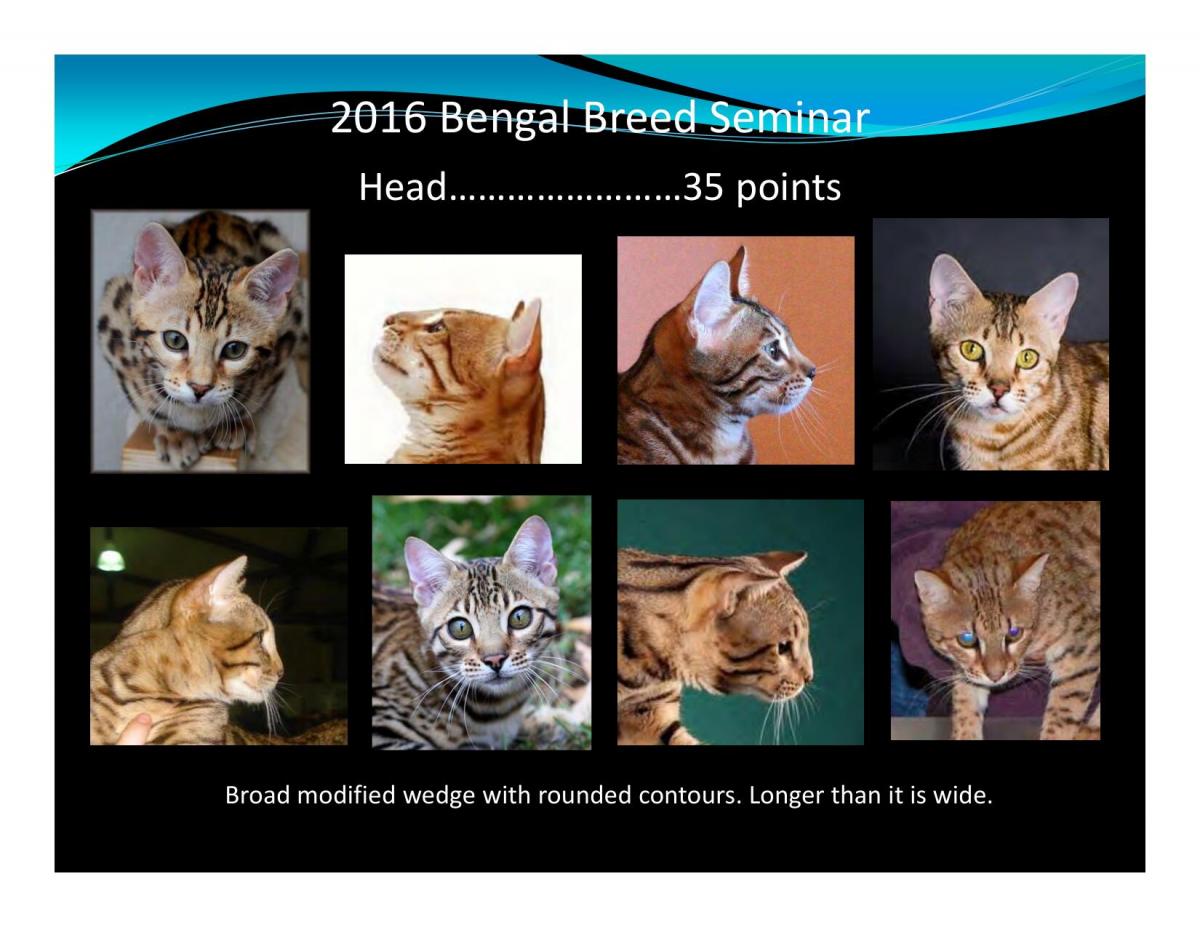
HEAD ........................... 35 points
Broad modified wedge with rounded contours. Longer that it is wide.
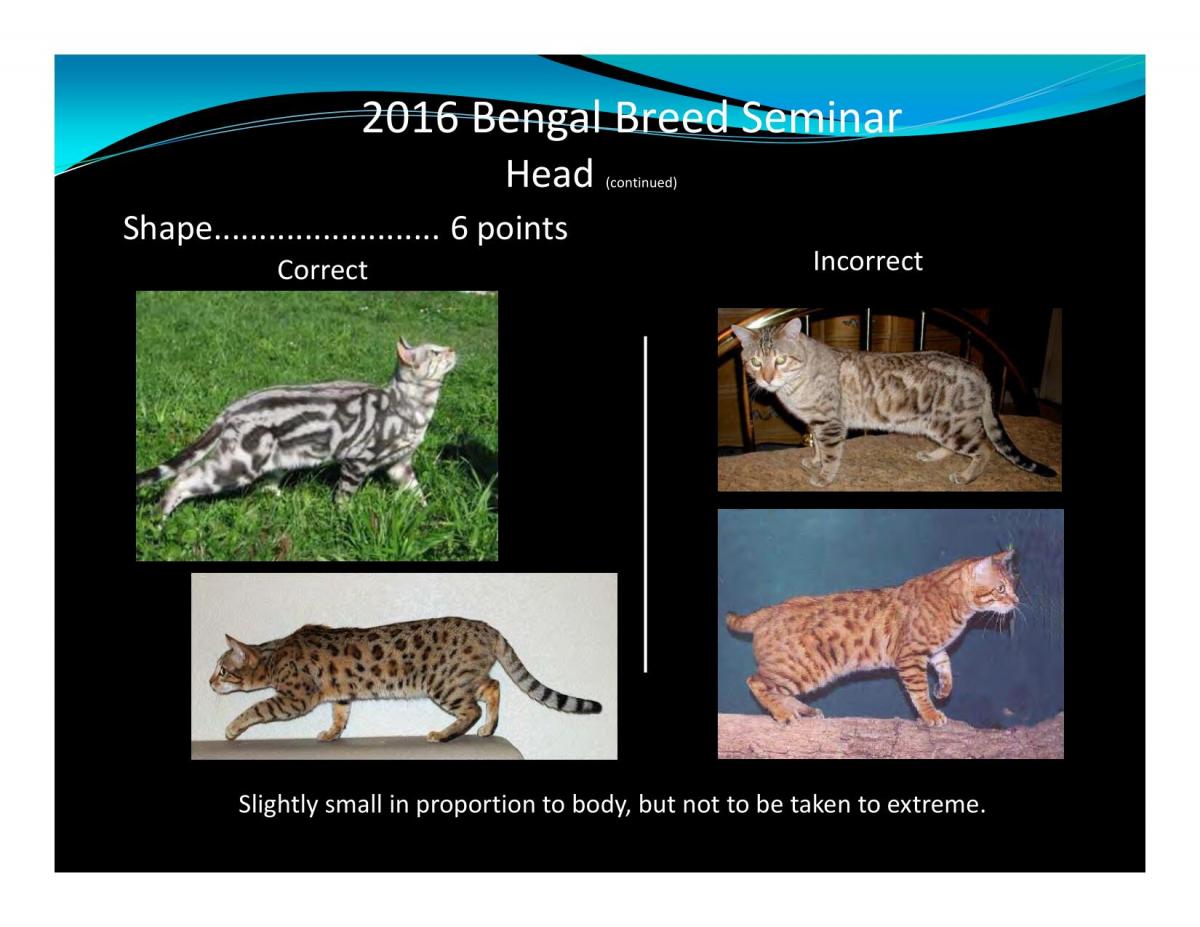
Head (continued)
Shape .......................... 6 points
Slightly small in proportion to body, but not to be taken to extreme
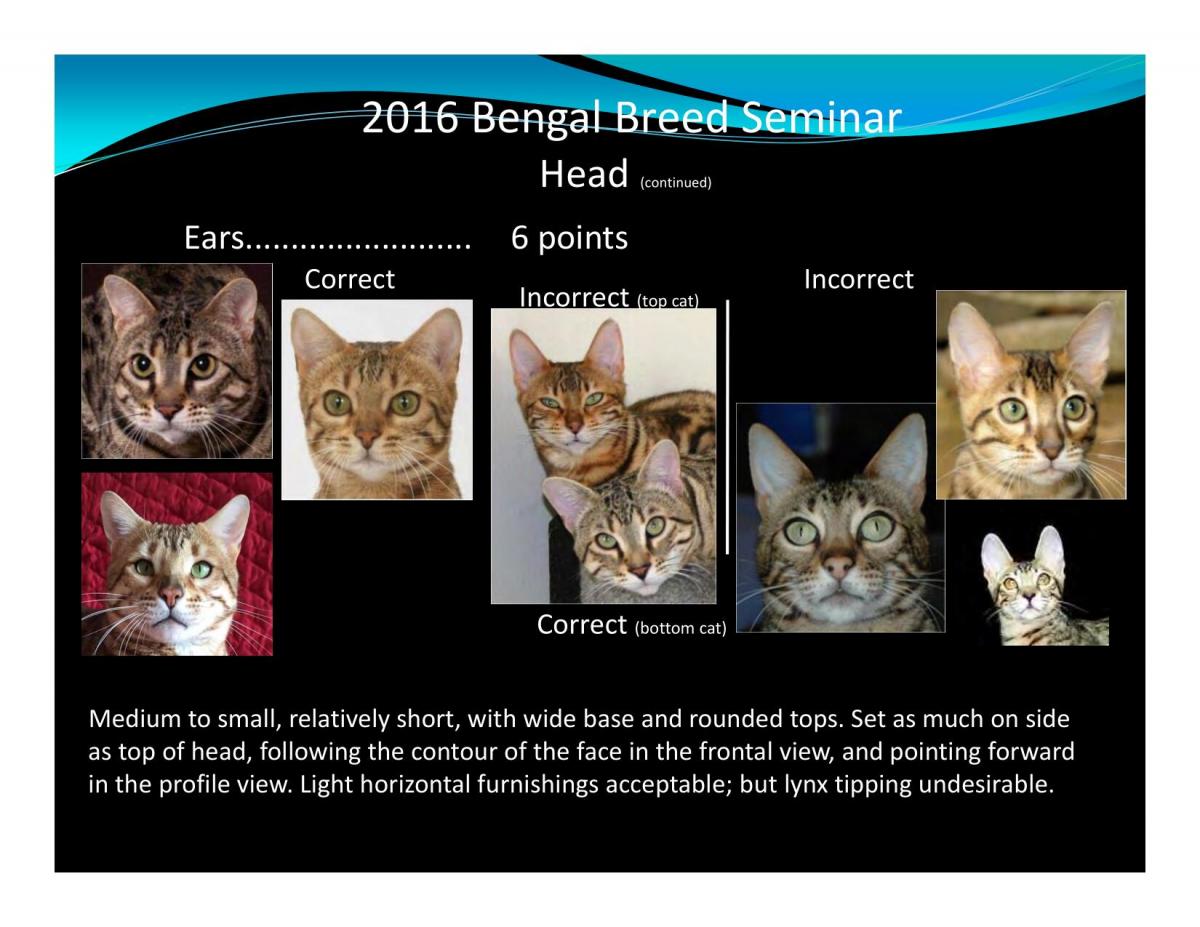
Head (continued)
Ears ...................................... 6 points
Medium to small, relatively short, with wide base and rounded tops. Set as much on side as top of head, following the contour of the face in the frontal view, and pointing forward in the profile view. Light horizontal furnishings acceptable; but lynx tipping undesirable.

Chin
This slide is used with permission from Robyn Paterson's presentation at the 2022 TICA Annual.
How the Forest shaped the Chin?
The Chin is the bottom attachment point of the jaw muscles. Bengal chin muscles are sometimes visible when the chin muscles are relax and drop forward.
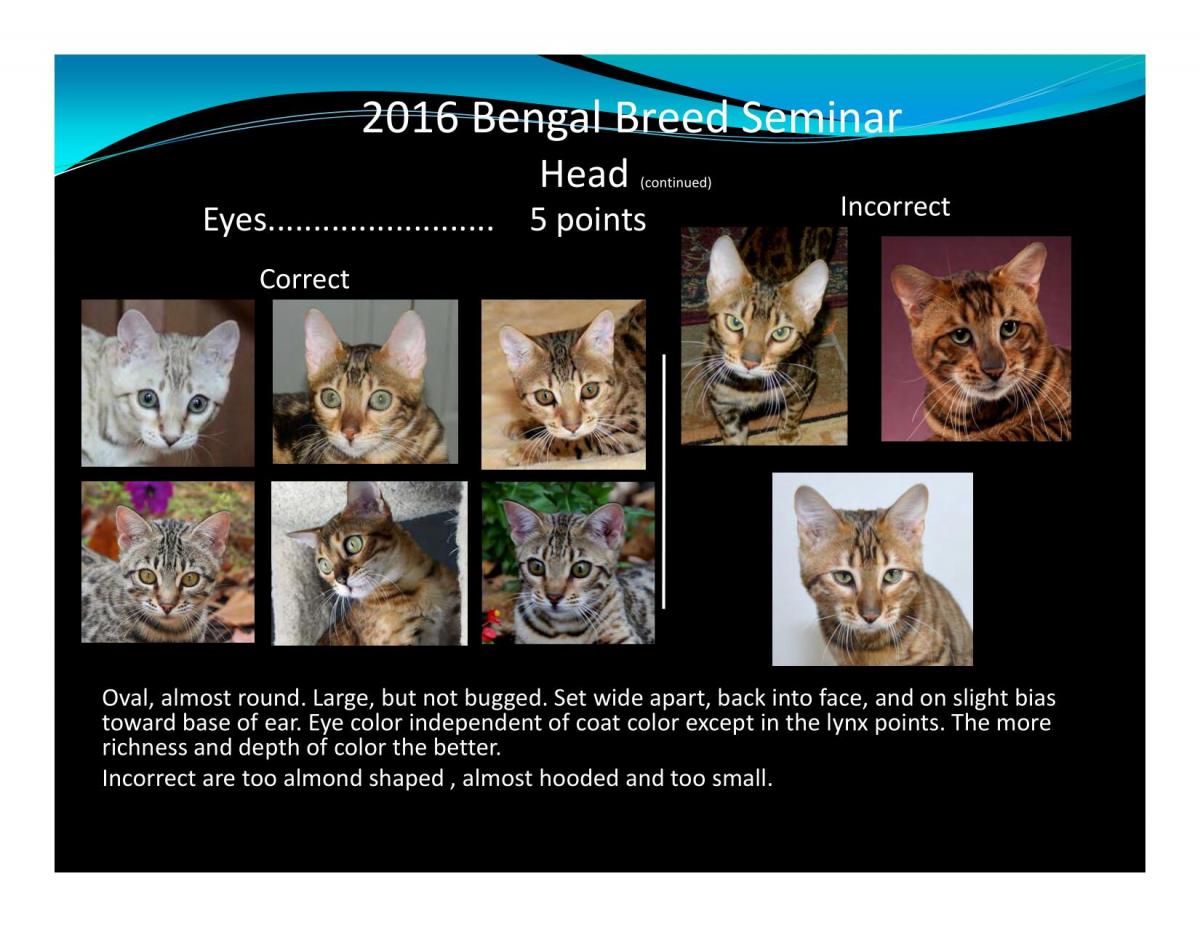
HEAD (continued)
Eyes .................................. 5 points
Oval, almost round. Large, but not bugged. Set wide apart, back into face, and on slight bias toward base of ear. Eye color independent of coat color except in the lynx points. the more richness and depth of color the better.
Incorrect are too almond shaped, almost hooded and too small.
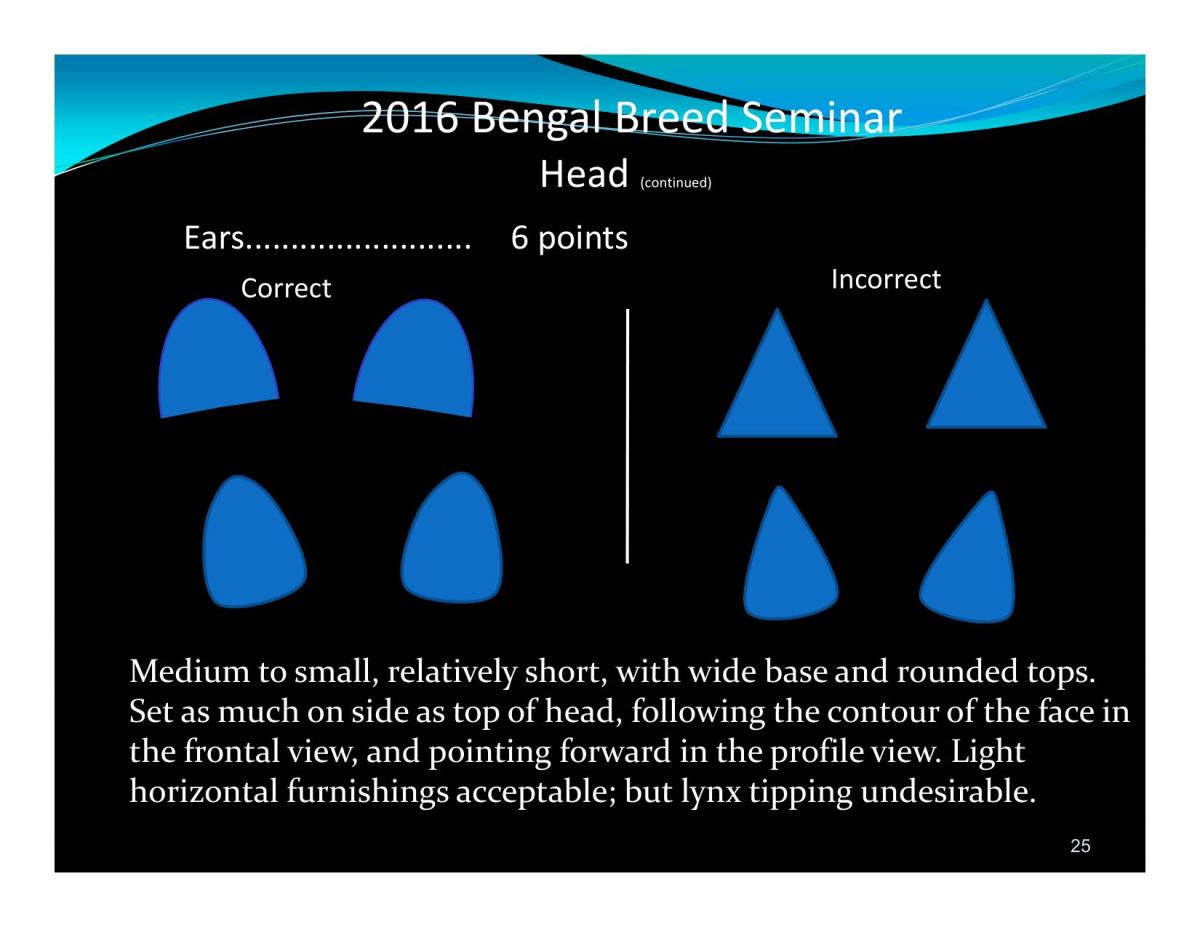
HEAD (continued)
Ears.................................... 6 points
Medium to small, relatively short , with wide base and rounded tops. Set as much on side as top of head, following the contour of the face in the frontal view, and pointing forward in the profile view. Light horizontal furnishings acceptable; but lynx tipping undesirable.
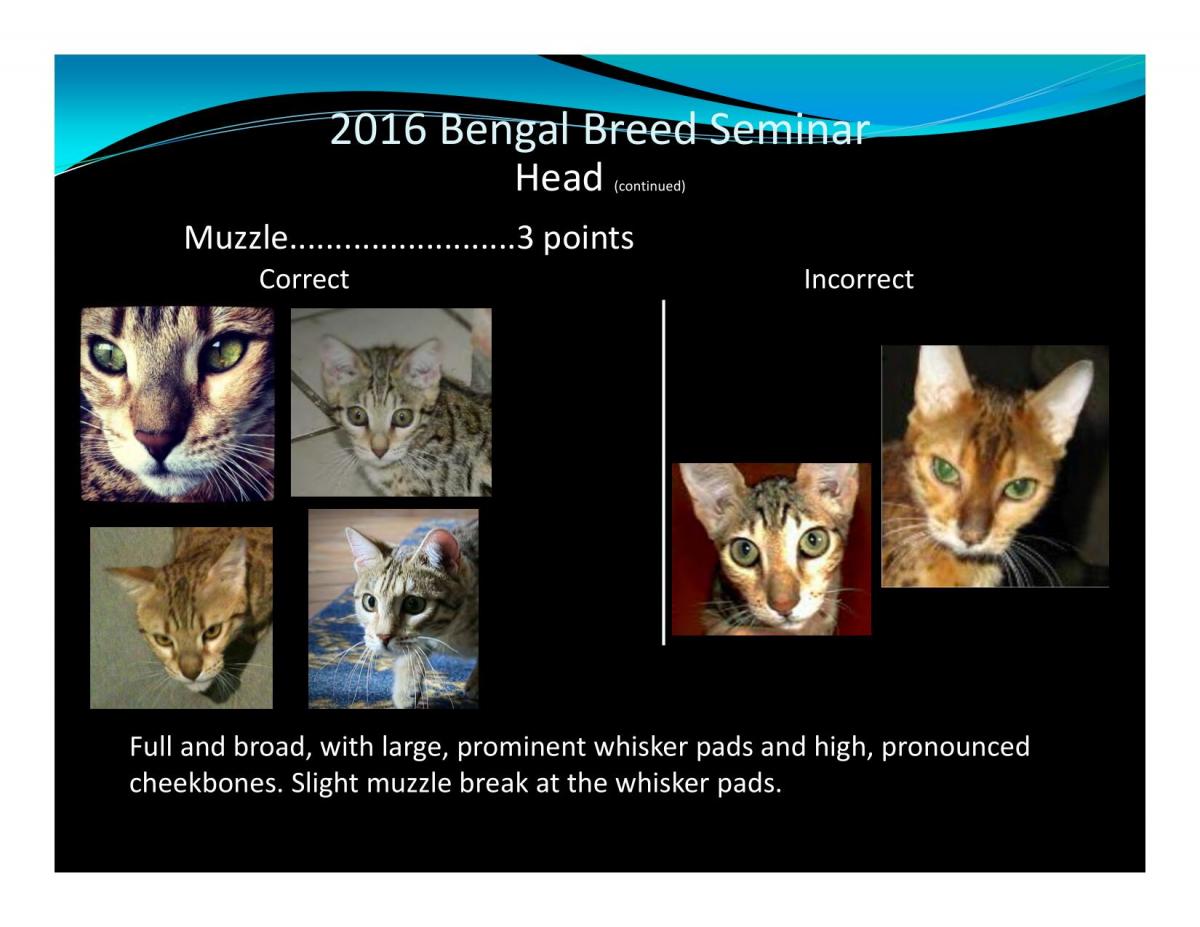
Head (continued)
Muzzle ............................................... 3 points
Full and broad, with large, prominent whisker pads and high, pronounced cheekbones. Slight muzzle break at the whisker pads.
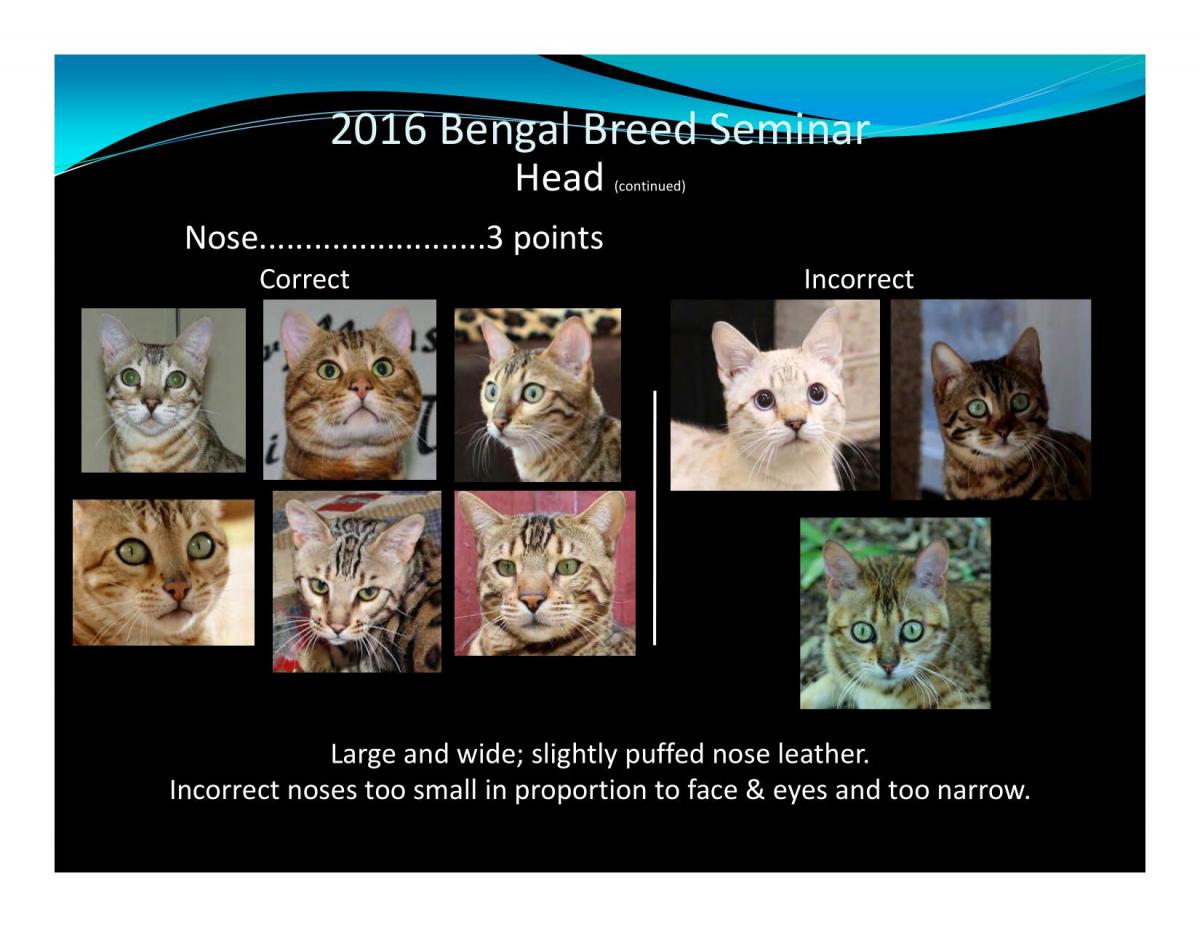
Head (continue)
Nose ......................................... 3 points
Large and wide; slightly puffed nosed leather. Incorrect nosed too small in proportion to face & eyes and too narrow.
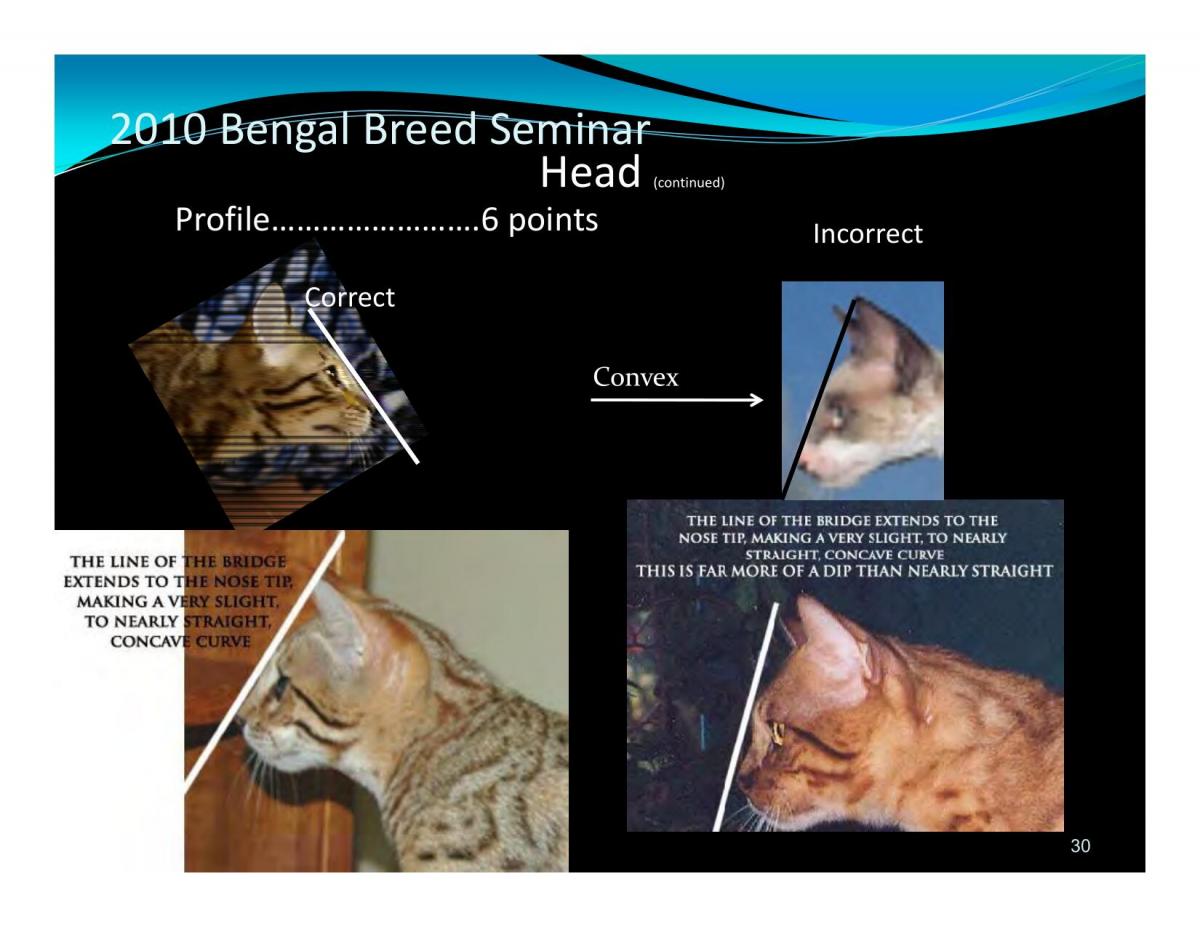
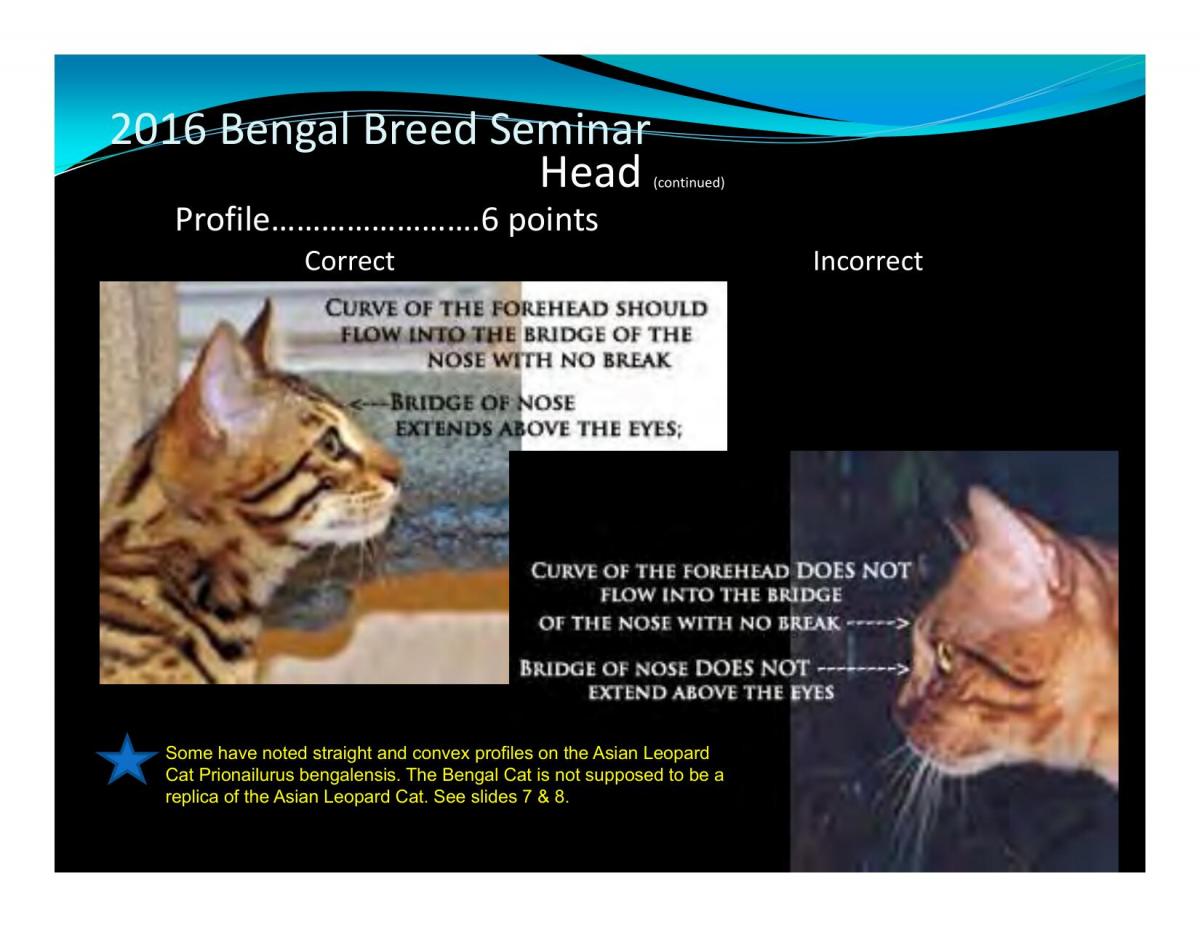
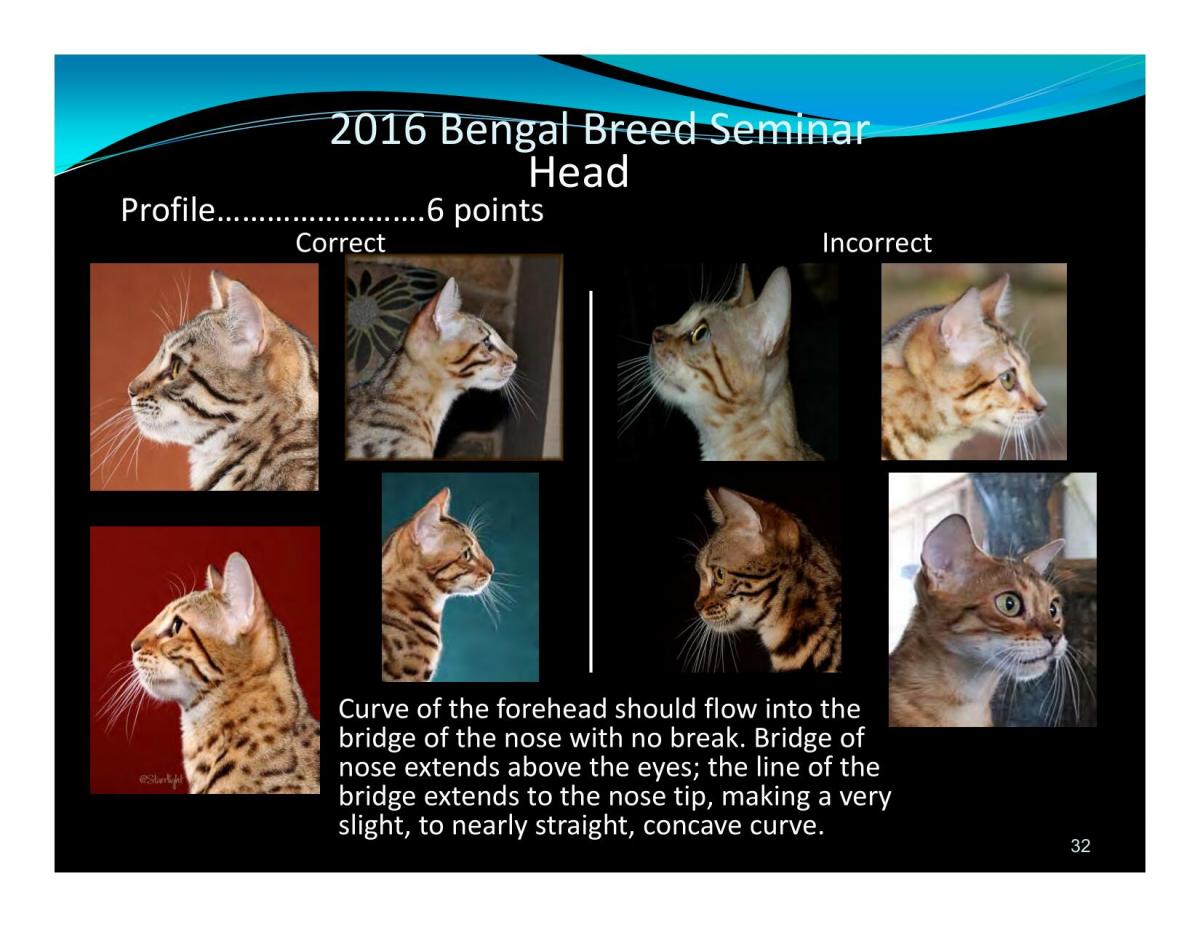
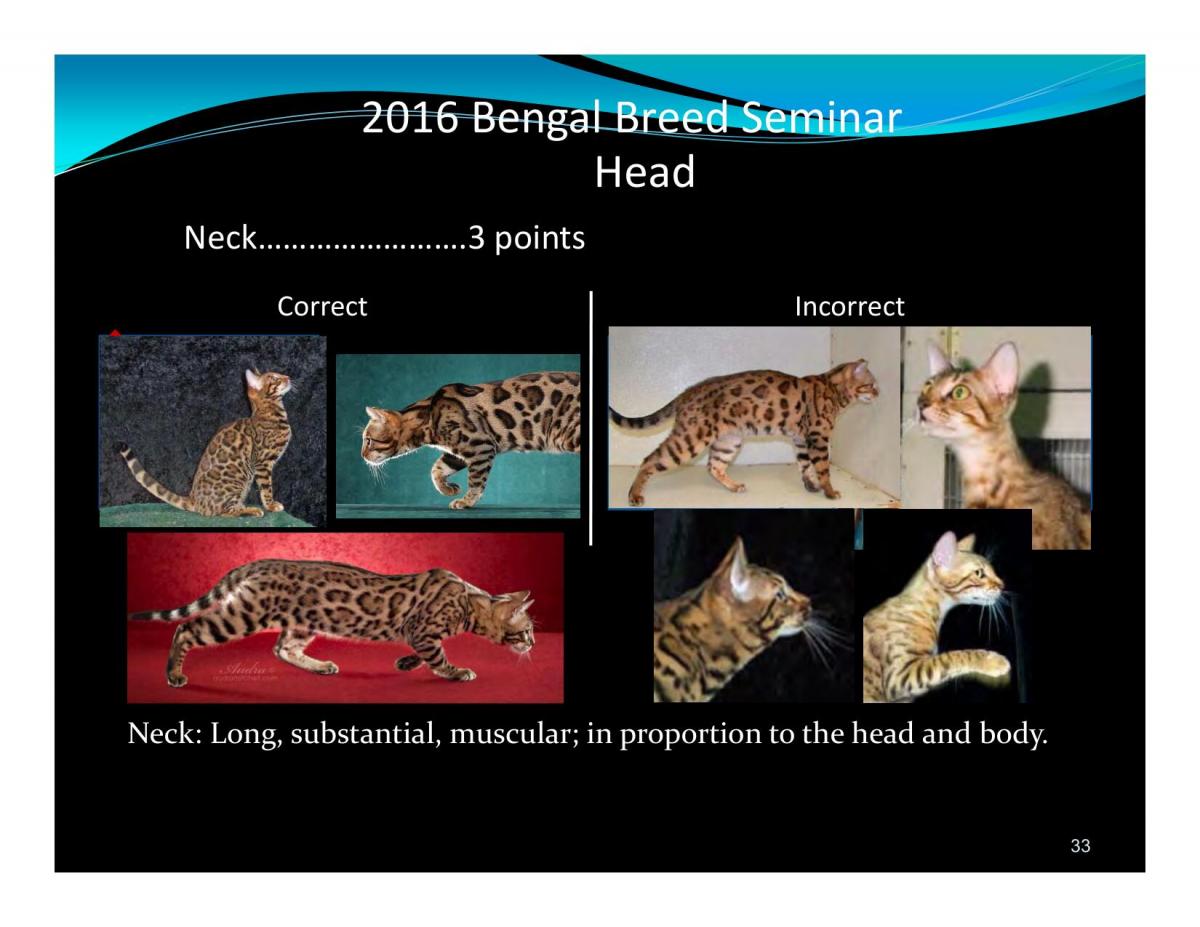
2016 Bengal Breed Seminar General Description
The goal of the Bengal breeding program is to create a domestic cat which has physical features distinctive to the small forest-dwelling wildcats, and with the loving, dependable temperament of the domestic cat.
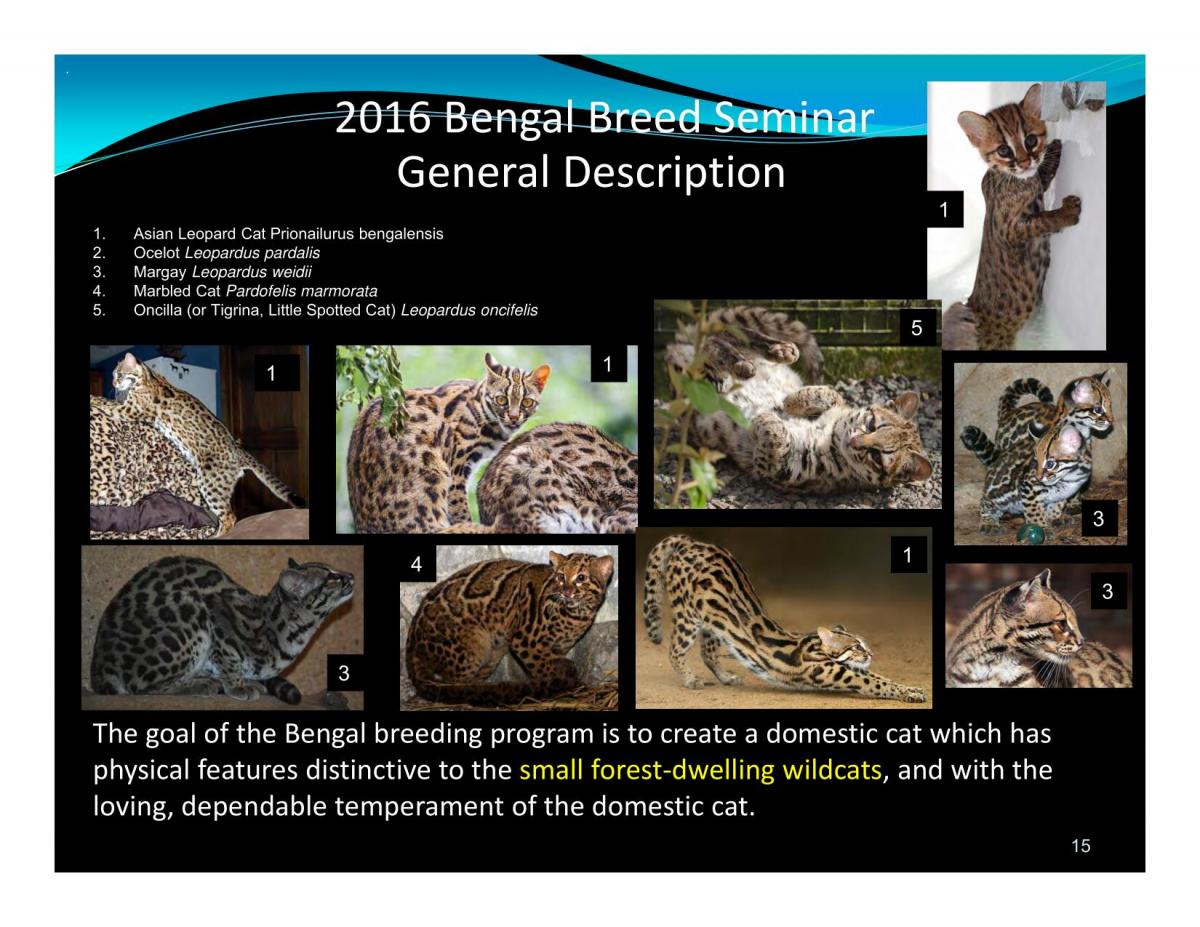
General Description
1.Asian Leopard Cat Prionailurus bengalensis
2.Ocelot Leopardus pardalis
3.Margay Leopardus weidii
4.Marbled Cat Pardofelis marmorata
5.Oncilla (or Tigrina, Little Spotted Cat) Leopardus oncifelis
The goal of the Bengal breeding program is to create a domestic cat which has physical features distinctive to the small forest-dwelling wildcats, and with the loving, dependable temperament of the domestic cat.
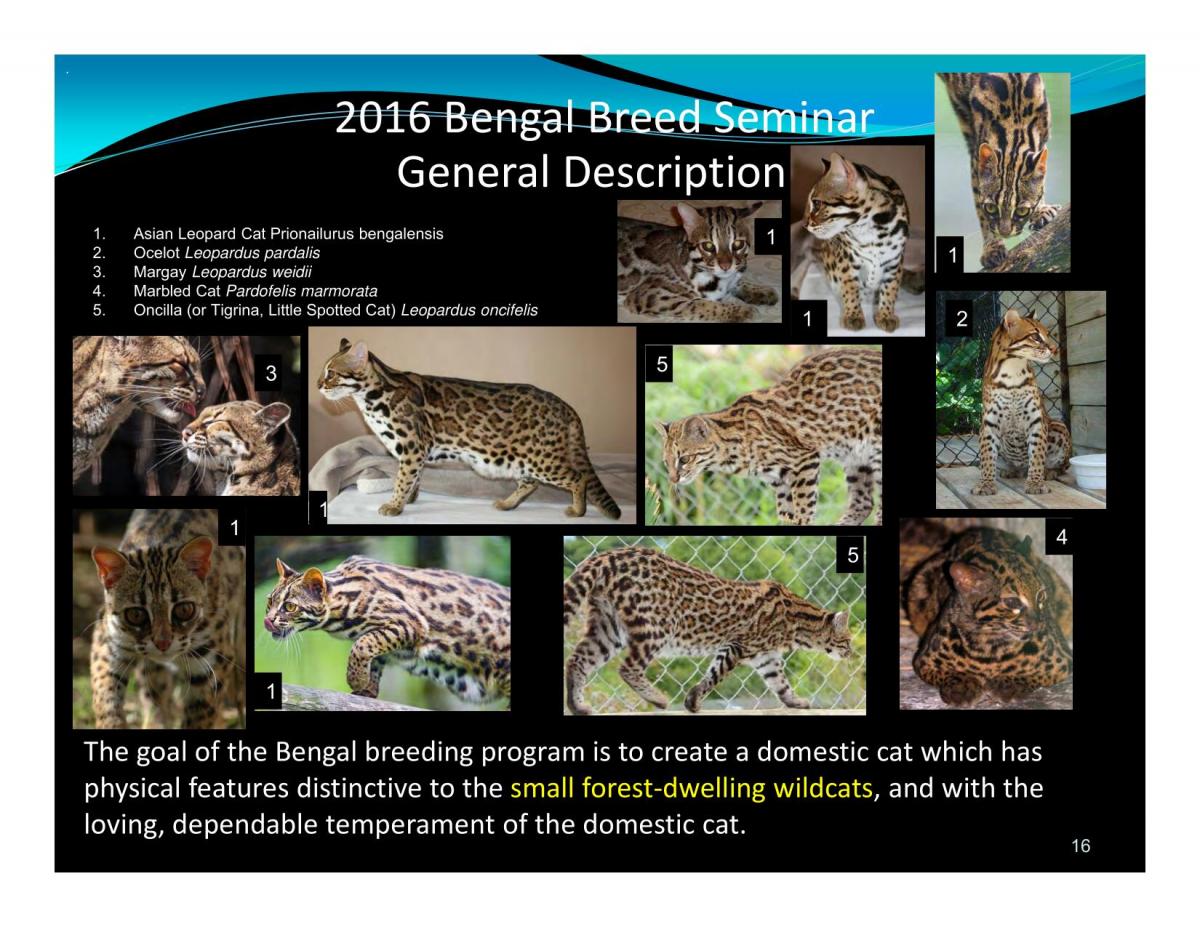
Bengal Breed Seminar General Description
Keeping this goal in mind, judges shall give special merit to those characteristics in the appearance of the Bengal which are distinct from those found in other domestic cat breeds. A Bengal cat is an athletic animal, alert to its surroundings; a friendly, curious, confident cat with strength, agility, balance and grace.
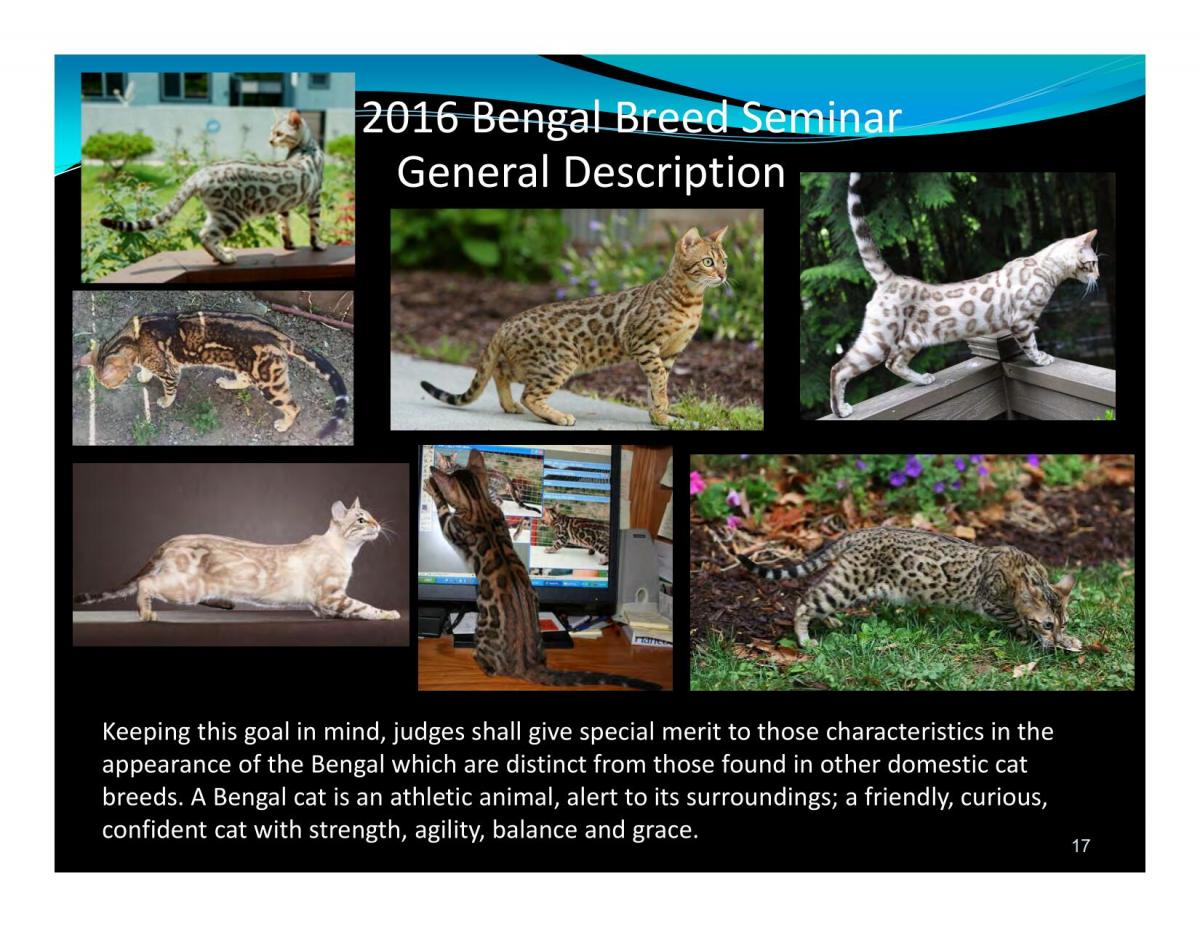
It is a medium to large cat which exhibits a very muscular and solid build. Its wide nose with prominent whisker pads and large oval, almost round eyes in a slightly small head enhance the wild appearance and expressive nocturnal look. Its very slight, to nearly straight, concave profile and relatively short ears with wide base and rounded tips add to the Bengal's
distinctive and unique appearance.
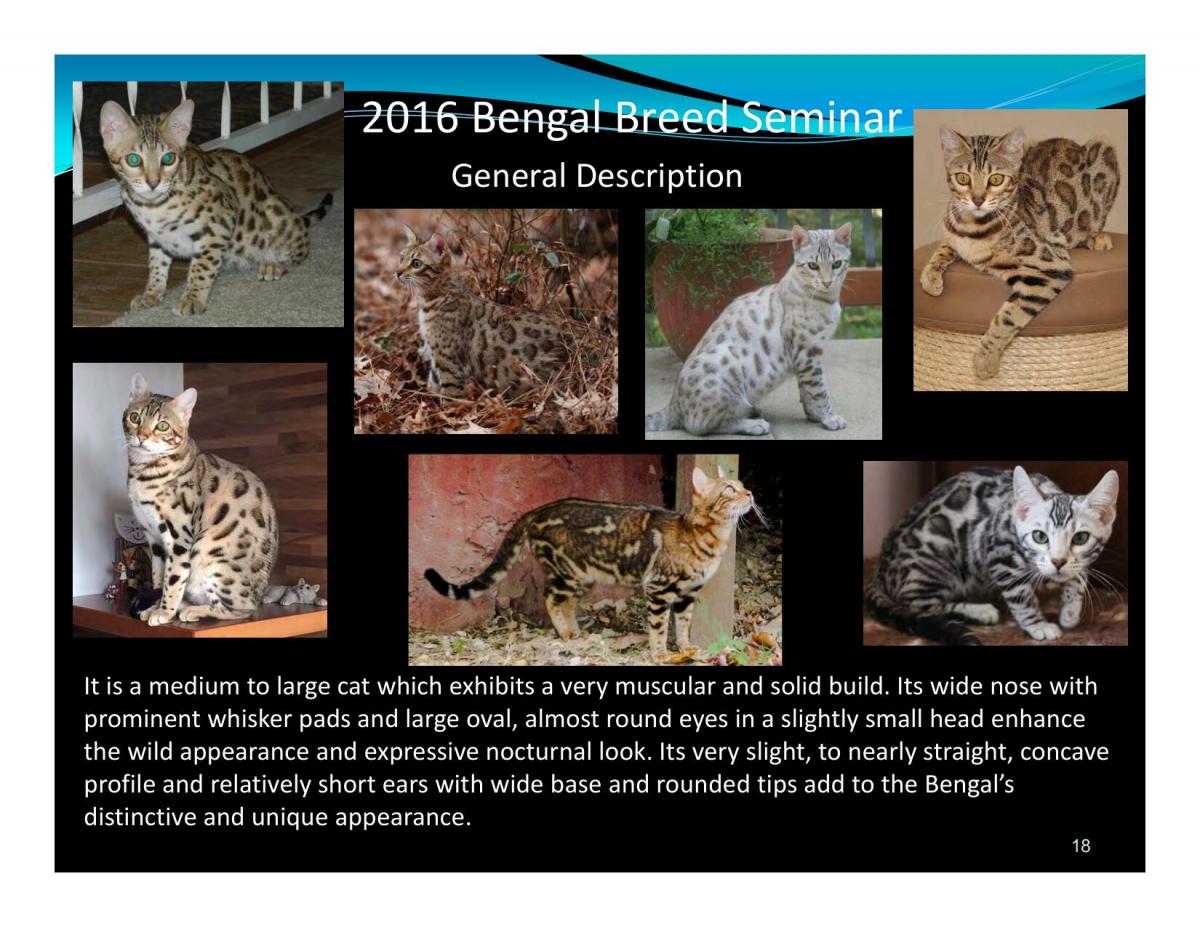
The short, dense coat has a uniquely soft and silky feel. The coat may be glittered or not glittered, with neither type to be given preference. A thick, low-set, medium- length tail adds balance to the cat.
Identifies glitter
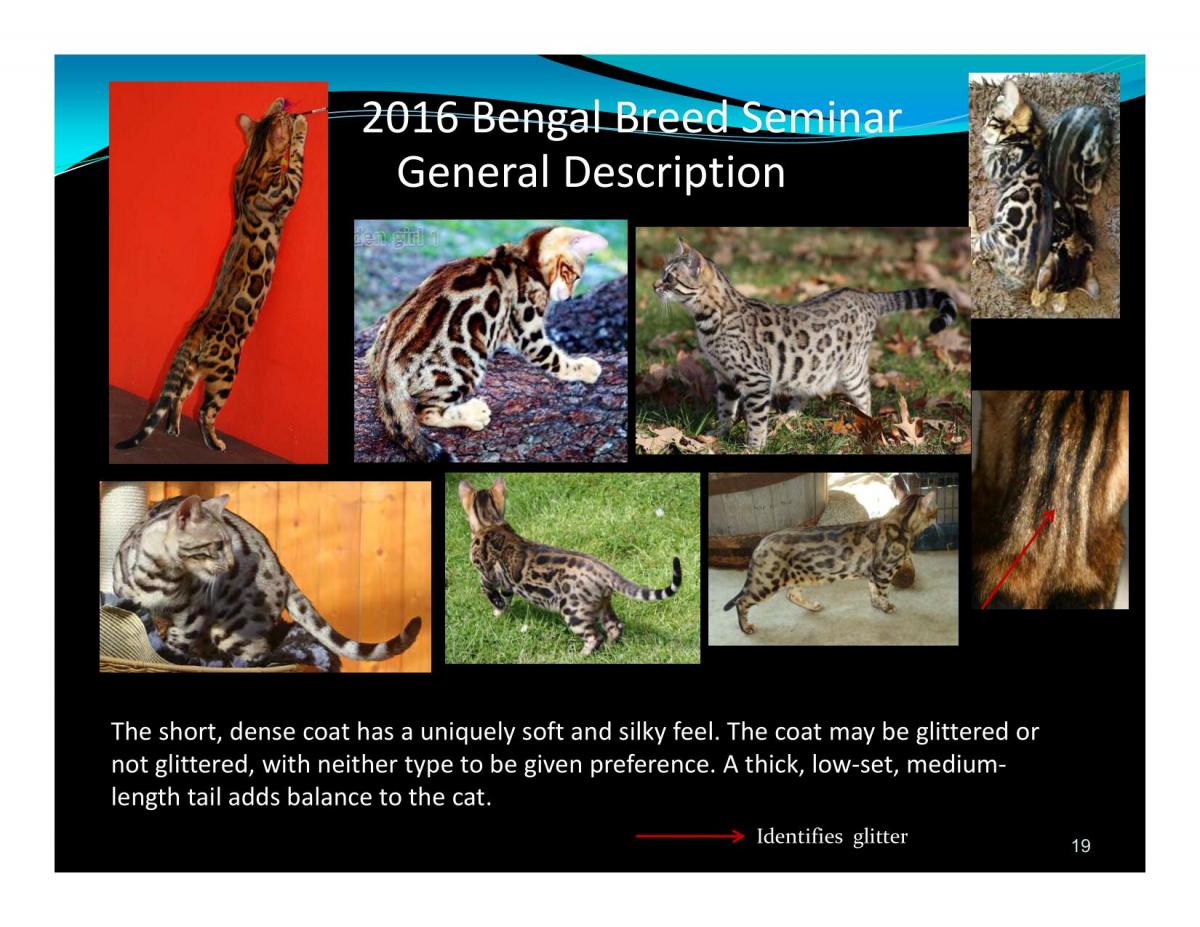
What is the Wild look?
The Bengal Cat Breed Committee was conflicted?
Show Non-Domestic Cats (wild) to demonstrate traits to breeders & judges who don't look at them often.
Do NOT show Non-Domestic Cats (wild) so breeders and judges can SEE the ideal traits already in the domestic Bengal population.
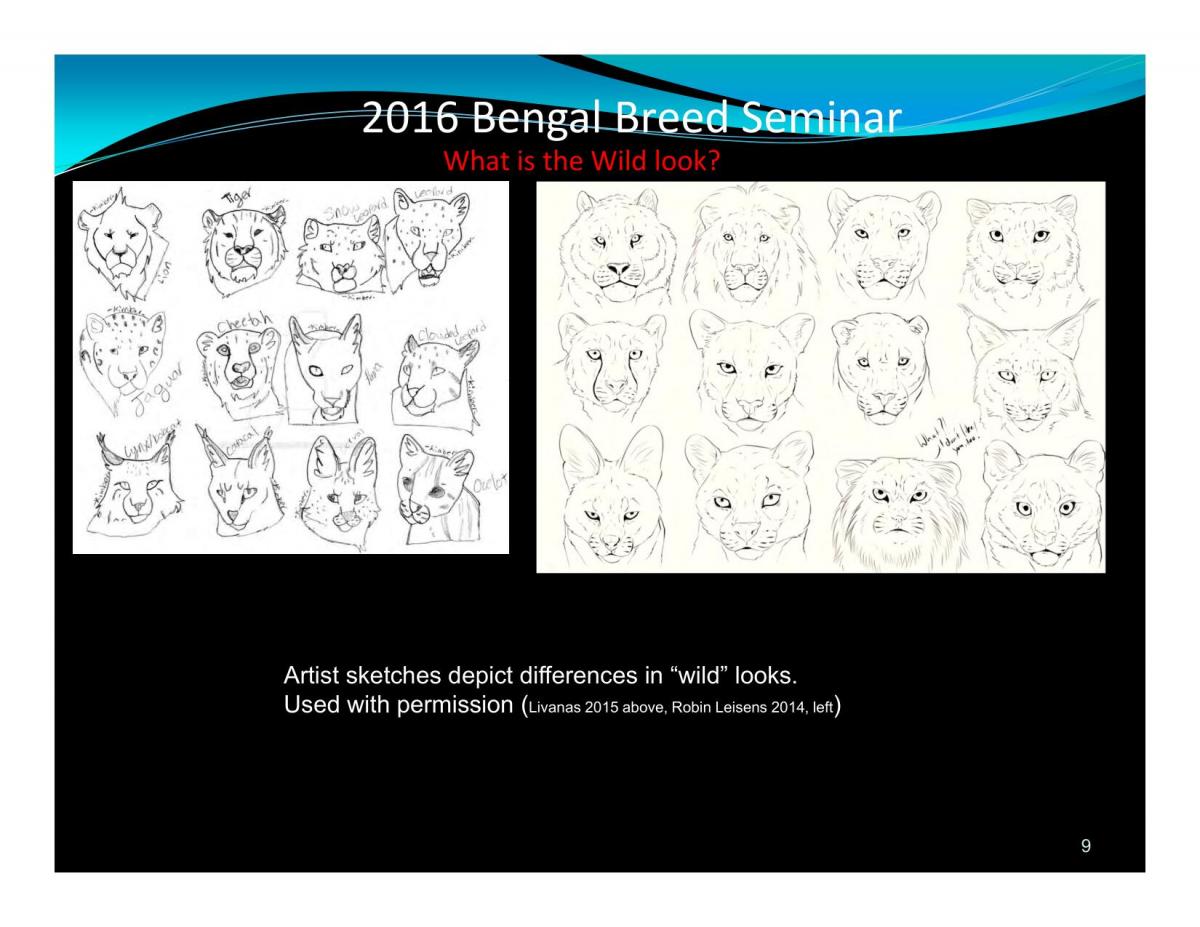
What is the Wild look?
Artist sketches depict differences in "wild" looks. Used with permission (Livanas 2015 above, Robin Leisens 2014, left)
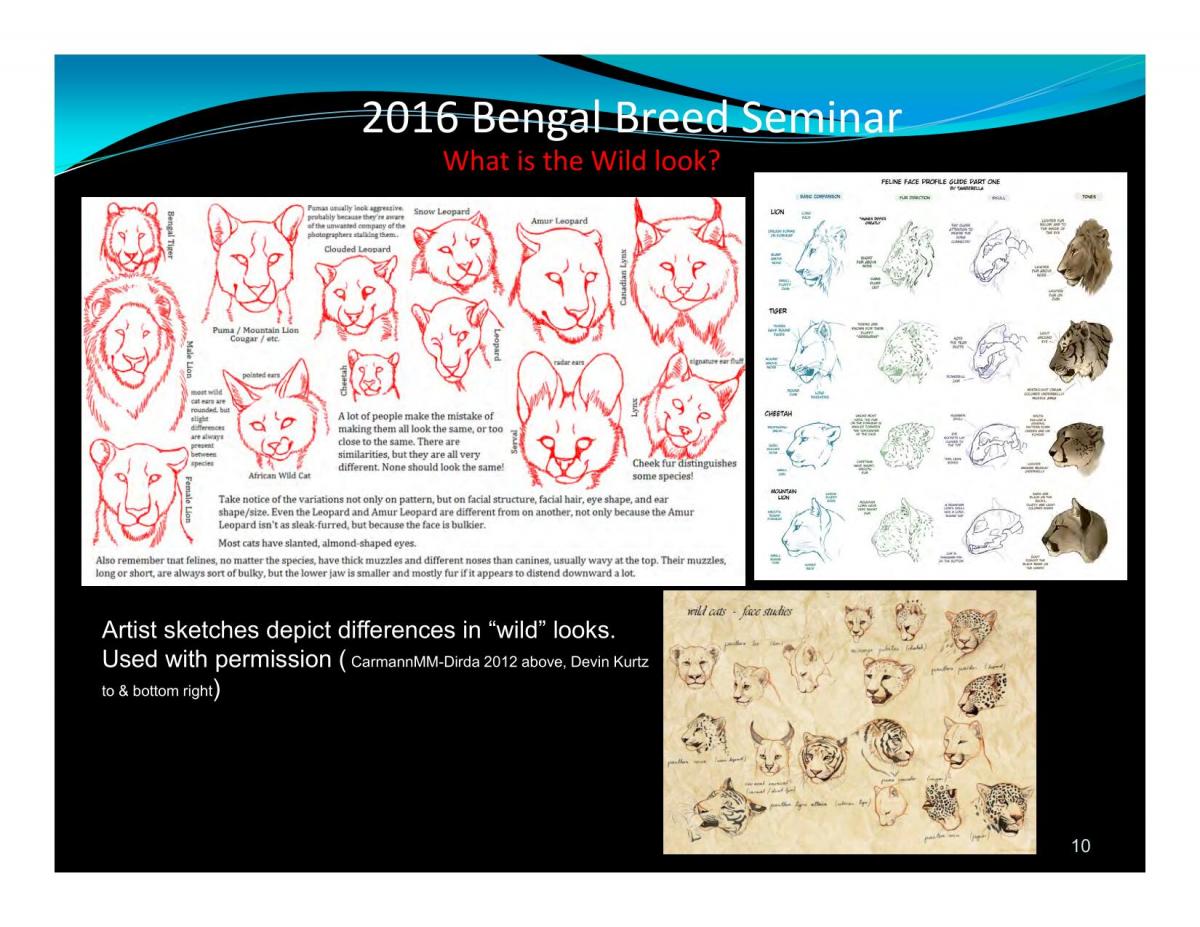
What is the Wild look? Beyond heads
Artist sketches depict differences in "wild" looks. Used with permission by Joumana Medlej Guide to Cats
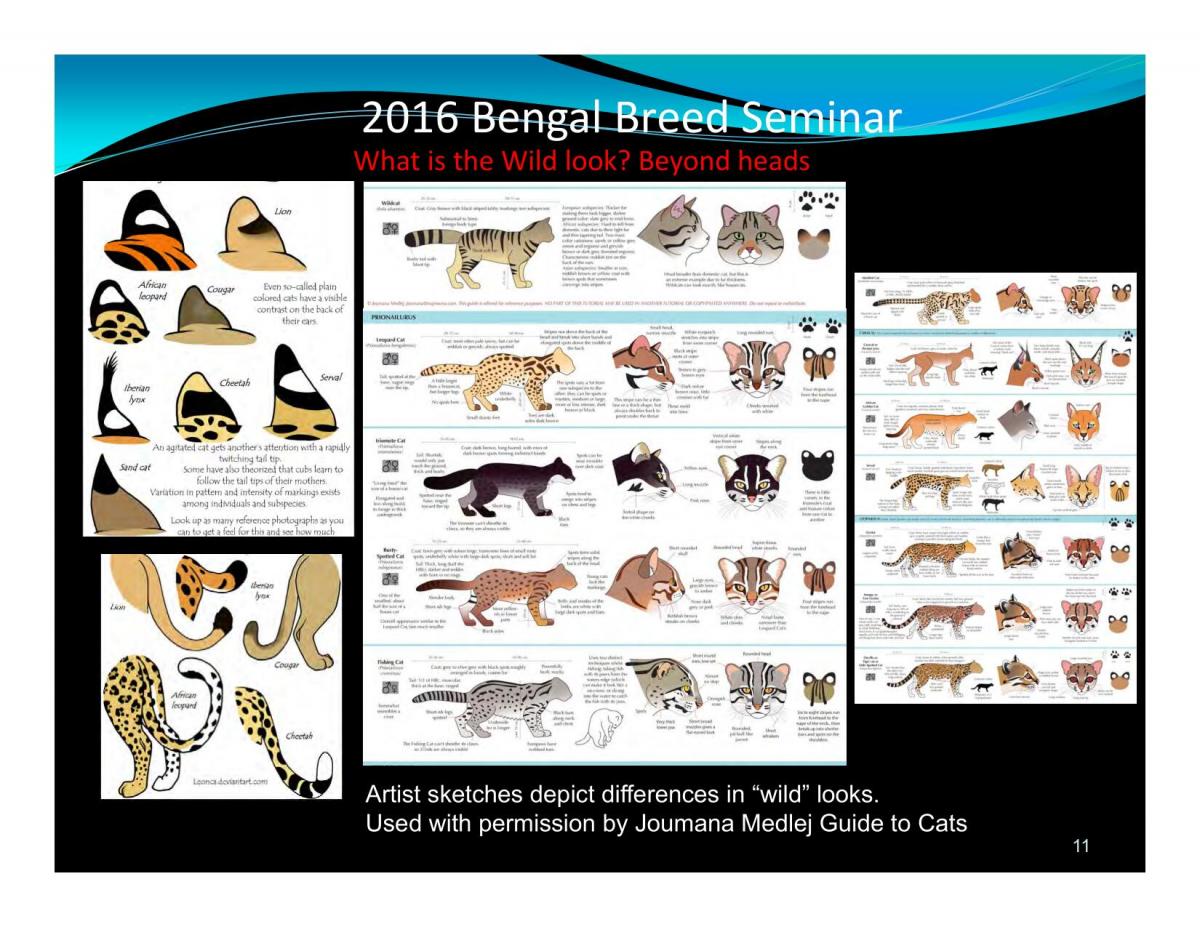
What is the Wild look?
Artist depictions of "wild" looks. Used with permission (Sindos 2015 chart, art Dolphy for Jungletrax 2015, middle)
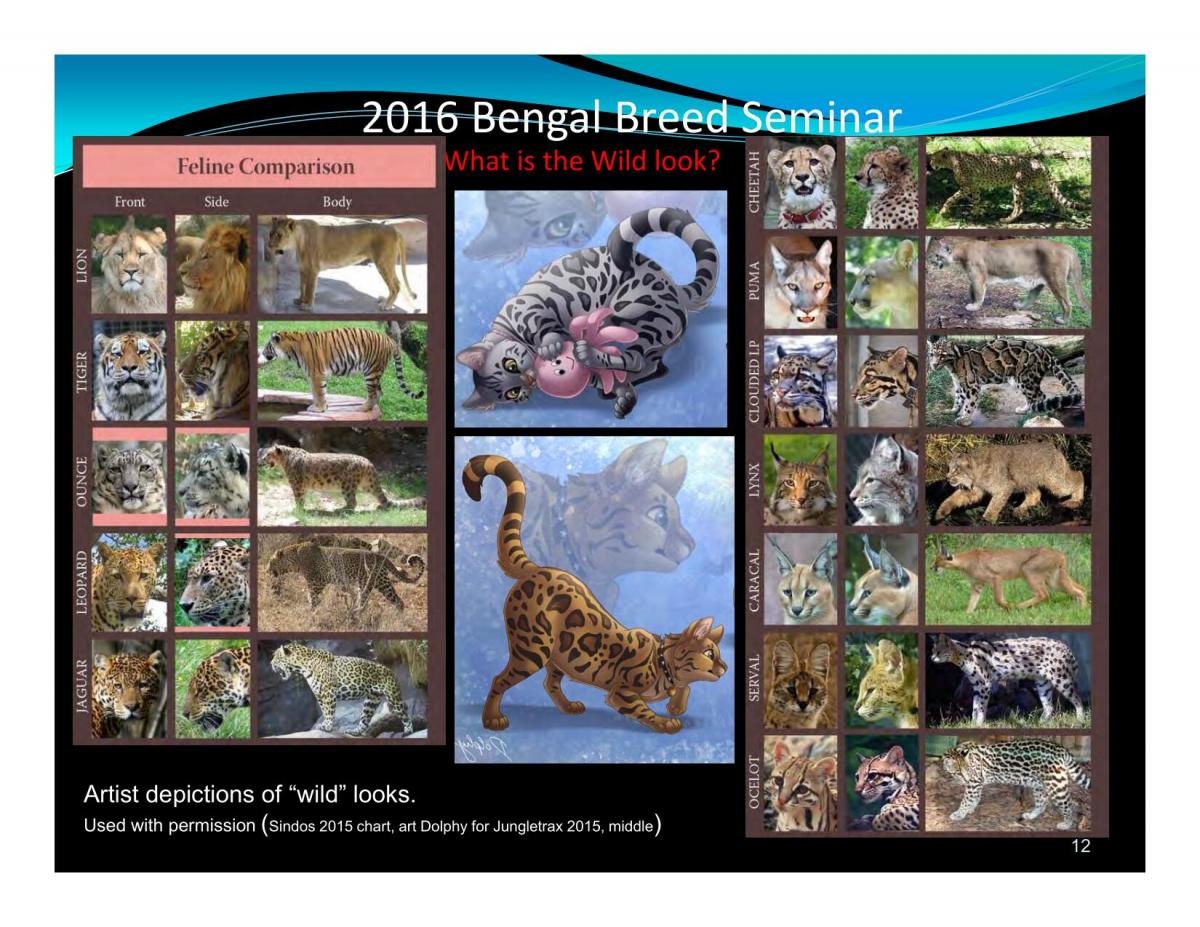
The Bengal Cat in the context of Domestic Cat looks?
Joumana Medlej domestic cat bodies, 2012 above
Breeds of Cats by Steinlen 1897* Note Wild Cats of Siam are likely Asian Leopard Cat X domestic hybrids
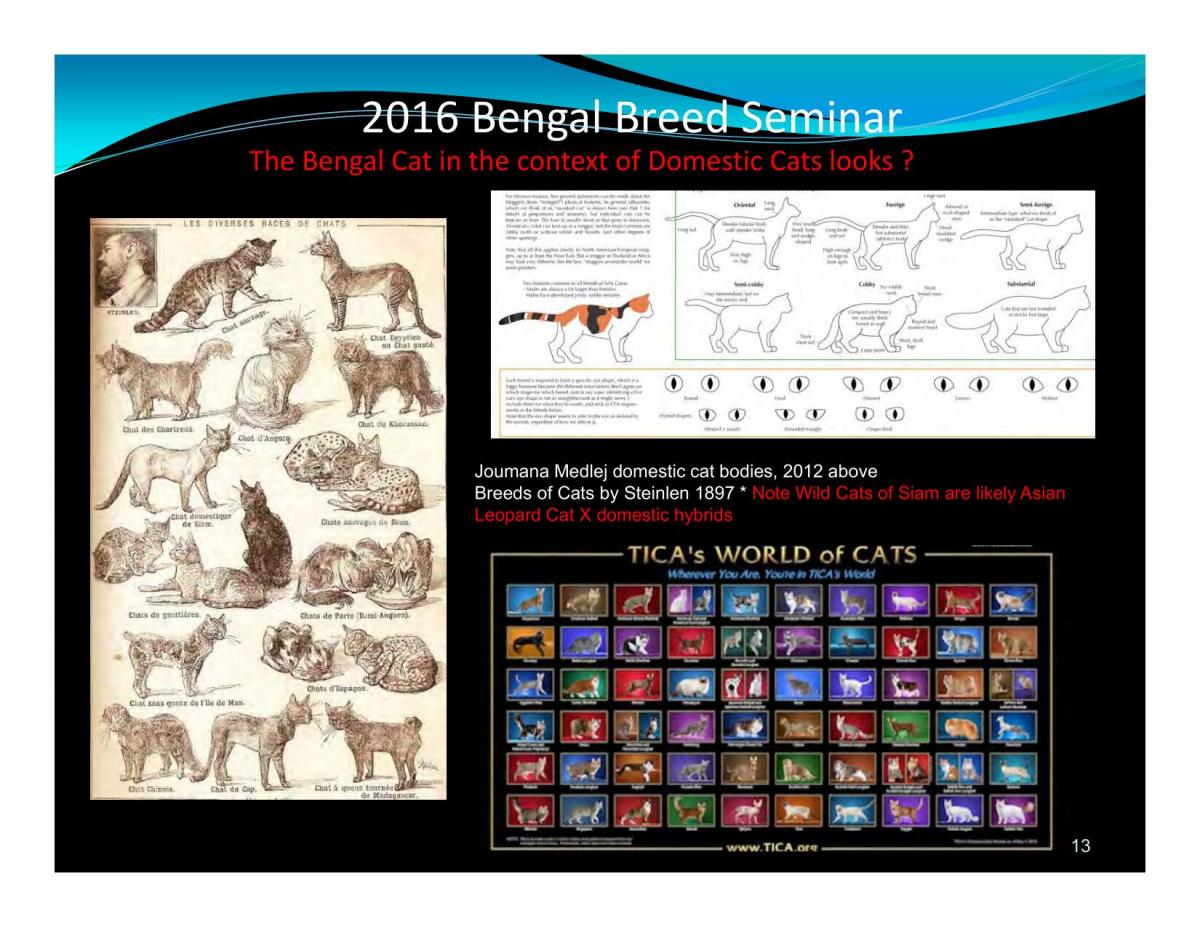
Bengal Breed Seminar, 2016
Presented by the TICA Bengal Breed Committee (2015-2018) for the illustration and understanding of the Bengal Cat Standard, Bengal History, Bengal Cat Handling and Bengal Cat Genetic Inheritance

For Breeders, Enthusiasts, Exhibitors and Evaluators of the Bengal Cat
OCELOT-A Beautiful Unique Per
The devotees of the Bengal Cat have undertaken a consequential endeavor that has brought incredible joy, challenge, triumph and love to the world. Bengal Cat breeders are the most diverse and numerous of all feline enthusiasts - experience, geography and socio-economic background. Bengals are a mixture of all known feline possibilities - all colors, all patterns, hair lengths, body types and brand new non-Felis sylvestris derived genes. When Bengal Cats were accepted and developing no tests existed for any desireable or undesirable traits.
This breed was not found on an island nor a standard written for a few cats that already existed. The idea of the ideal Bengal Cat was an aspiration. The beauty of the Bengal Cat exists because of dedicated breeders.
Is the Bengal Cat breed distinctiveness valued enough by those seeking to appreciate, breed and evaluate Bengal Cats?
The world now has cats that seek human attention and affection wrapped in coats once caressed only through hunting or trapping. These cats have heads and bodies with exotic essence previously enjoyed in fantasies, by the very lucky or very rich. They are domestic cats in every sense of the word, that's amazing!
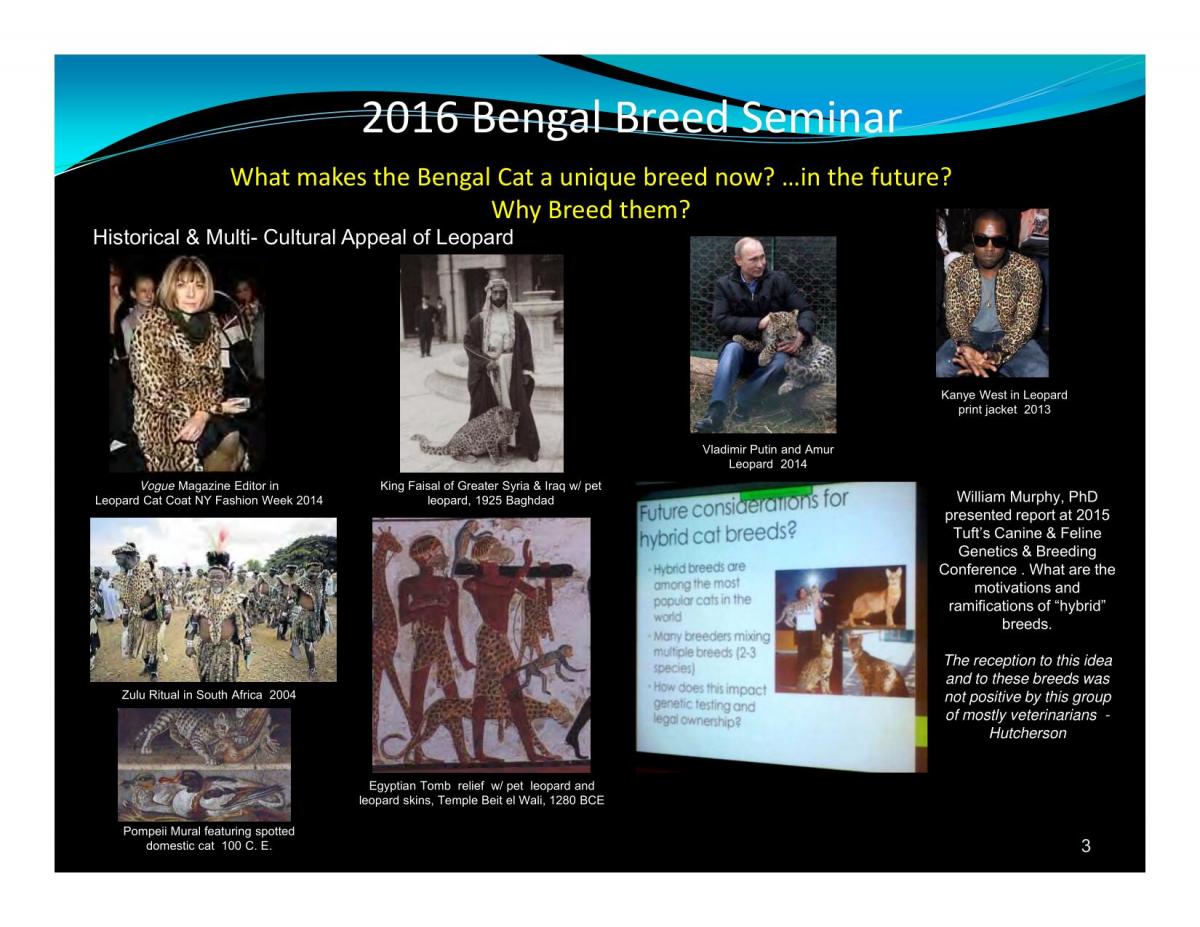
What makes the Bengal Cat a unique breed now?...in the future? Why Breed them?
Historical & Multi-Cultural Appeal of Leopard
- Vogue Magazine Editor in Leopard Cat Coat NY Fashion Week 2014
- King Faisal of Greater Syria & Iraq w/ pet leopard, 1925 Baghdad
- Zulu Ritual in South Africa 2004
- Pompeii Mural featuring spotted domestic cat 100 C. E.
- Egyptian Tomb relief w/ pet leopard and leopard skins, Temple Beit el Wali, 1280 BCE
- Kanye West in Leopard print jacket 2013
- Vladimir Putin and Amur Leopard 2014
Future considerations for hybrid cat breeds?
- Hybrid breeds are among the most popular cats in the world
- Many breeders mixing multiple breeds (2-3 species)
How does this impact genetic testing and legal ownership?
William Murphy, PhD presented report at 2015 Tuft's Canine & Feline Genetics & Breeding Conference. What are the motivations and ramifications of "hybrid" breeds.
The reception to this idea and to these breeds was not positive by this group of mostly veterinarians - Hutcherson

Why the words "Asian Leopard Cat" are NOT in the Standard
Initial Goal- Which Asian Leopard Cat? The species is highly variable in pattern, color, size and proportions
Which ALC subspecies is the ideal?
Asian Leopard Cat is not in the standard because they are highly diverse in general appearance and some zoologists and feline taxonomists divide them into as many as four (4) separate species. Genetic analysis validates the idea. William Murphy PhD, Brian Davis PhD, Jay Bangle, Anthony Hutcherson 2016
Jean Mill sought to create a miniature leopard, harvesting only the pattern & contrast from the Asian Leopard Cat Other Early Breeders & Exhibitors wanted Asian Leopard Cat replicas
Could/Should law enforcement be able to easily distinguished between a domestic Bengal Cat and an Asian Leopard Cat (or other non-domestic species) with a glance?
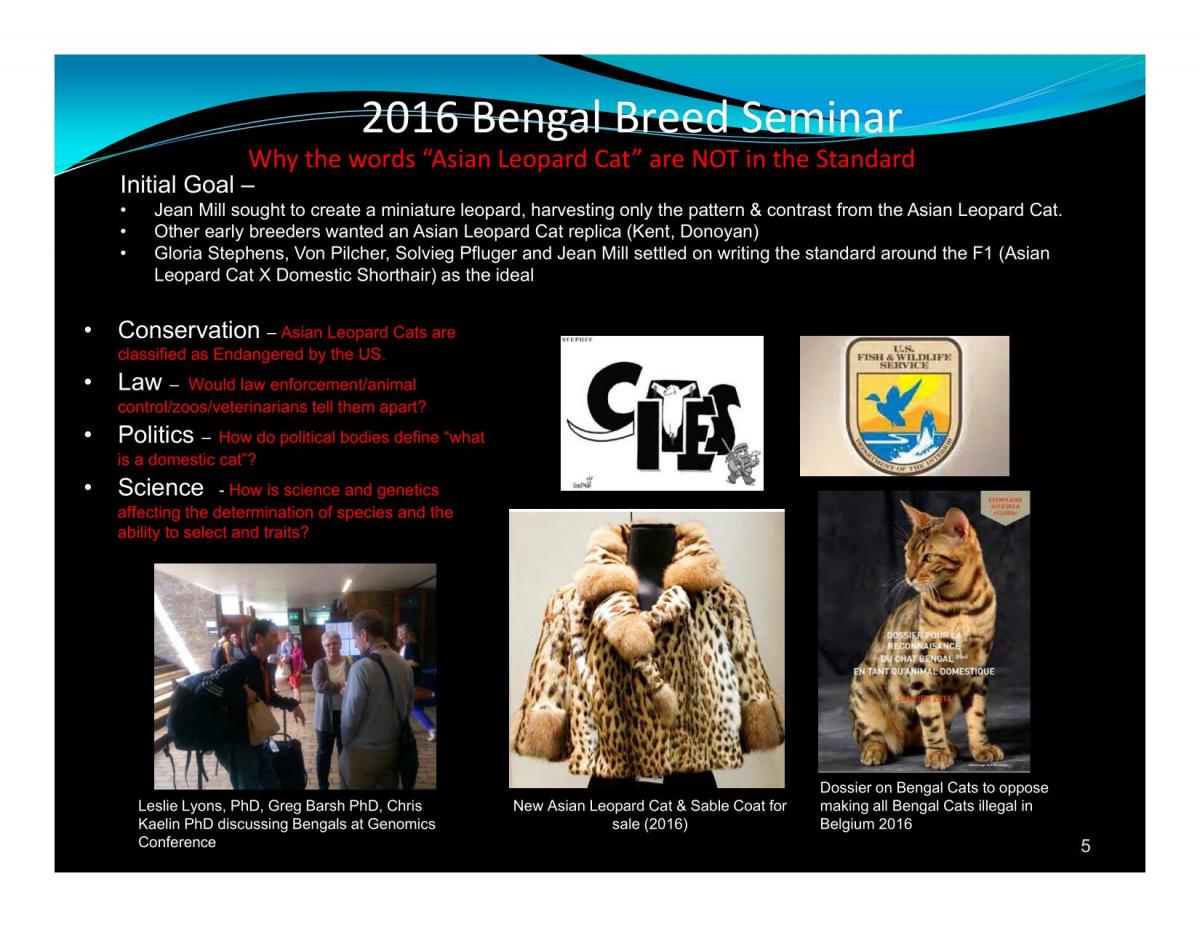
Why the words "Asian Leopard Cat" are NOT in the Standard
Initial Goal-
- Jean Mill sought to create a miniature leopard, harvesting only the pattern & contrast from the Asian Leopard Cat.
- Other early breeders wanted an Asian Leopard Cat replica (Kent, Donoyan)
- Gloria Stephens, Von Pilcher, Solvieg Pfluger and Jean Mill settled on writing the standard around the F1 (Asian Leopard Cat X Domestic Shorthair) as the ideal
Conservation - Asian Leopard Cats are classified as Endangered by the US.
Law- Would law enforcement/animal control/zoos/veterinarians tell them apart?
Politics -How do political bodies define "what is a domestic cat"?
Science -How is science and genetics affecting the determination of species and the ability to select and traits?
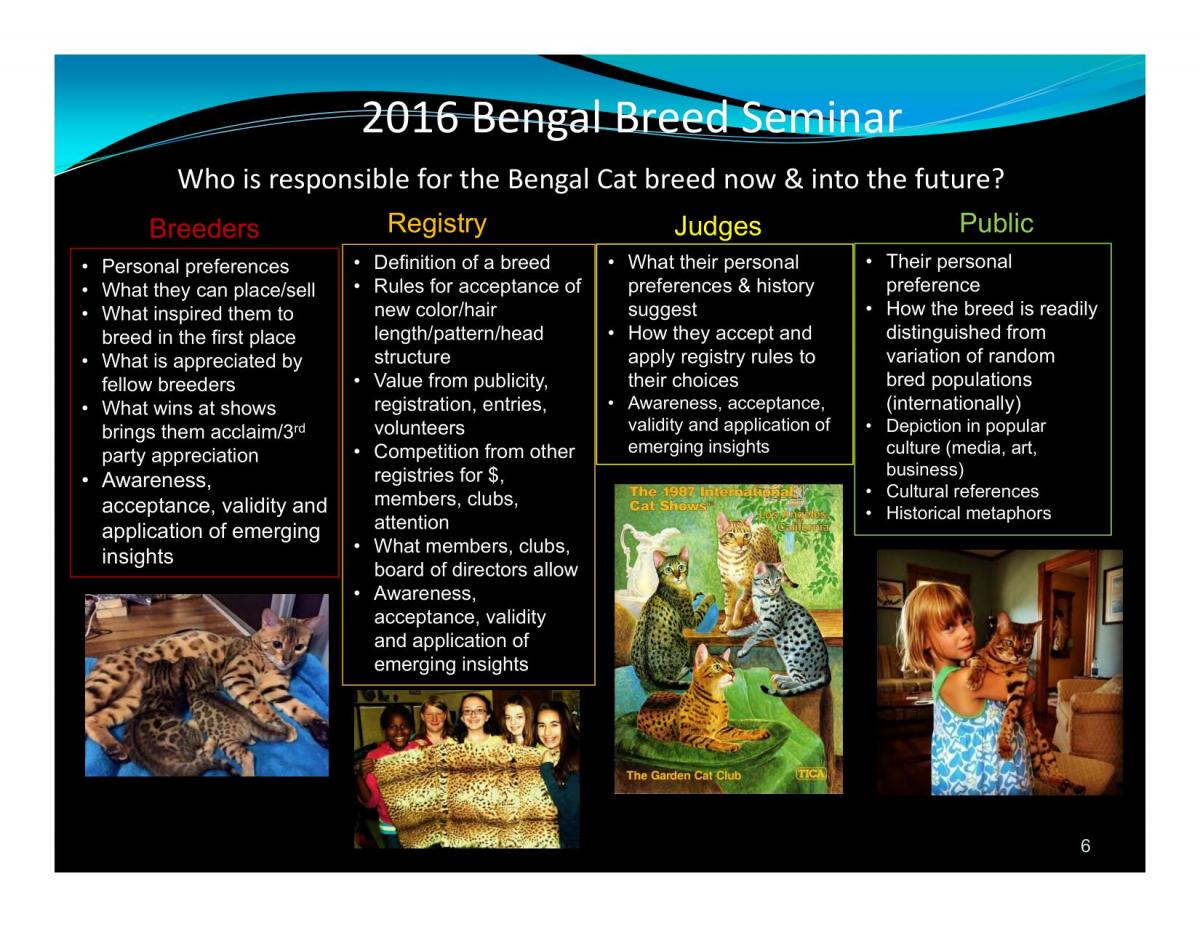
Who is responsible for the Bengal Cat breed now & into the future?
Breeders
Personal preferences
What they can place/sell
What inspired them to breed in the first place What is appreciated by fellow breeders
What wins at shows brings them acclaim/3rd party appreciation Awareness, acceptance, validity and application of emerging insights
Registry
Definition of a breed
Rules for acceptance of new color/hair length/pattern/head structure
Value from publicity, registration, entries, volunteers
Competition from other registries for $, members, clubs, attention
What members, clubs, board of directors allow Awareness, acceptance, validity and application of emerging insights
Judges
What their personal preferences & history suggest
How they accept and apply registry rules to their choices Awareness, acceptance, validity and application of emerging insights
The 1987 Internationa Cat Shows
Public
Their personal preference
How the breed is readily distinguished from variation of random bred populations (internationally) Depiction in popular culture (media, art, business)
• Cultural references •
Historical metaphors

Please DO NOT Call Bengal Cats a Hybrid Breed
Bengal Cats are a Category 1 (one) Breed in TICA -
Only Bengal Cats bred to Bengal Cats produce Bengal Cats
Asian Leopard Cats Prionailurus bengalensis is NOT an allowable outcross for Bengal Cats. ALC X domestic cats of any breed (including Bengal Cats creates an F1 Foundation Cat
TICA Registration Rules Define Bengal Cats as: 33.2.2 Domestic x Non-Domestic Source Species Hybrid Breed - A breed being developed by means of deliberate foundation crosses between domestic cats and a single non-domestic source species. The domestic cats used must not have a structural mutation.
Please DO Call Bengal Cats
• a domestic breed developed from Domestic X Non-Domestic Cat Hybrids
• Hybrid incorrectly infers Wild Cat (Asian Leopard Cat) X domestic = Bengal Cat
Starlight
Ramifications
Some municipal, US State and national laws restrict or prohibit hybrids. Incorrect use of terminology when judging, on websites etc. can result in confusion of what a Bengal Cat is to the law, science and public. That confusion can lead to domestic Bengal Cats being prohibited and made illegal.

